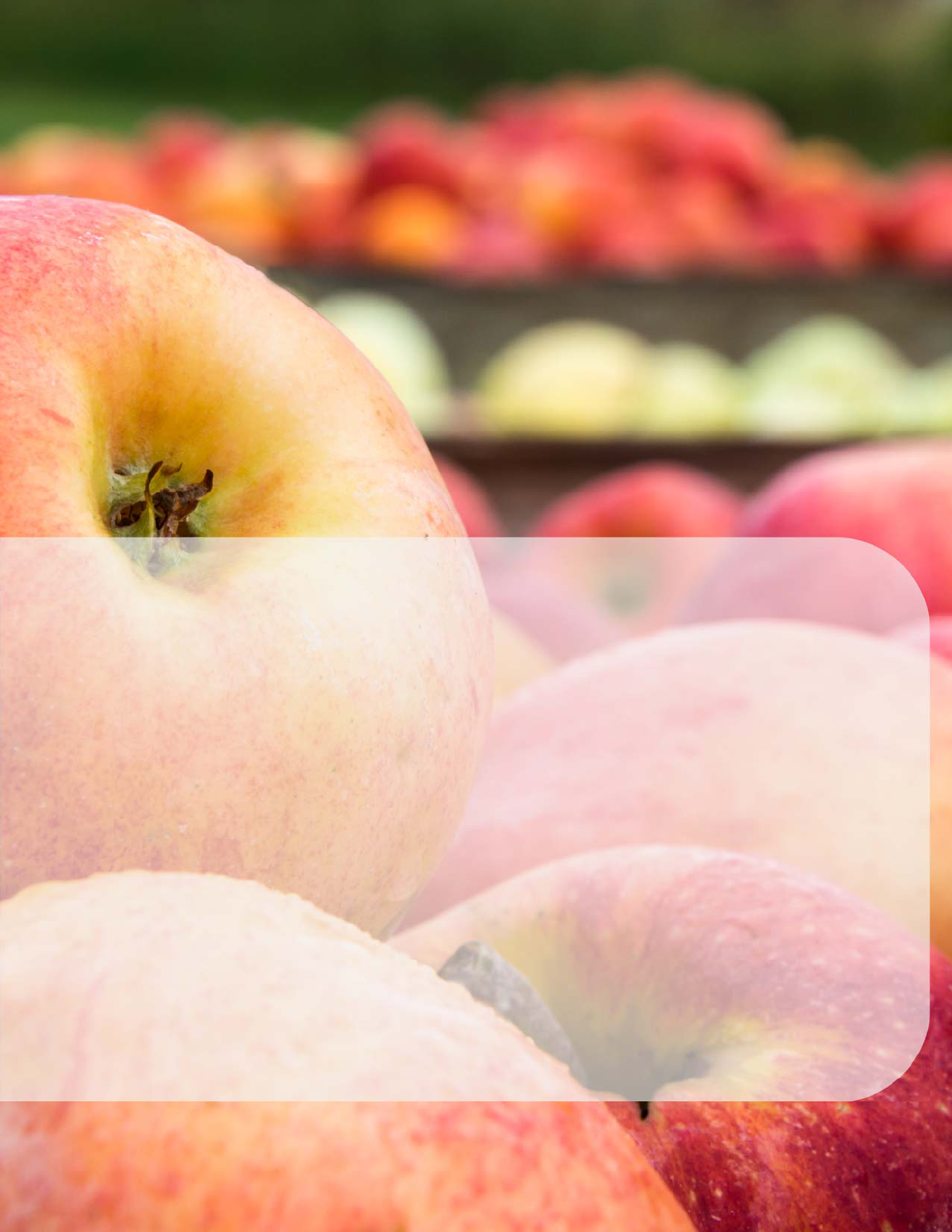
Washington State Food Waste
Management Evaluation
May 26, 2020
Prepared by
Cascadia Consulting Group, Inc., and Partners
for Washington State Department of Commerce

WASHINGTON STATE FOOD WASTE MANAGEMENT EVALUATION
ii
Contents
BackgroundandIntroduction__________________________________________________________________ 1
SystemandGeographicBoundaries _____________________________________________________________ 2
SystemBoundaries...................................................................................................................................................2
GeographicBoundaries............................................................................................................................................3
ExecutiveSummaryandKeyFindings____________________________________________________________ 3
FlowsofFoodWasteandWastedFoodinWashingtonState.................................................................................3
EdibleWastedFoodtoLandfill................................................................................................................................4
KeyFindings.............................................................................................................................................................4
SummaryofCurrentandRecommendedReportingProtocolsbyEntityType.......................................................5
RecommendationsforFutureMeasurementStudies.............................................................................................7
ChallengesandOpportunitiesforIncreasingCapacity...........................................................................................7
DataCollectionandModelingApproach _________________________________________________________ 8
IdentifyRequiredDataElementsandPrepareInitialDataRequests......................................................................8
SetDataCollectionPriorities.................................................................................................................................
10
ReviewAvailableDataandLiterature....................................................................................................................11
ConductInterviewsandSurveys............................................................................................................................14
ConductDataModeling.........................................................................................................................................14
DataLimitations.....................................................................................................................................................16
FindingsbyEntityType______________________________________________________________________ 17
HungerReliefOrganizations..................................................................................................................................17
AnimalFeedDistributorsandFarmRecipients.....................................................................................................24
CompostFacilities..................................................................................................................................................29
IndustrialUses
........................................................................................................................................................38
EmergingSolutions_________________________________________________________________________ 43
FertilizerTechnologies...........................................................................................................................................43
Bio-BasedMaterials...............................................................................................................................................43
References _______________________________________________________________________________ 44
Appendices_______________________________________________________________________________ 50
AppendixA:WashingtonStateFoodWasteFlowModelMethodology...............................................................50
AppendixB:HungerReliefInterviewGuide..........................................................................................................60
AppendixC:CompostFacilityInterviewGuide......................................................................................................64

WASHINGTON STATE FOOD WASTE MANAGEMENT EVALUATION
iii
AppendixD:CompostFacilitySurveyResponses..................................................................................................68
AppendixE:AnimalFeedFoodWasteCategories.................................................................................................97
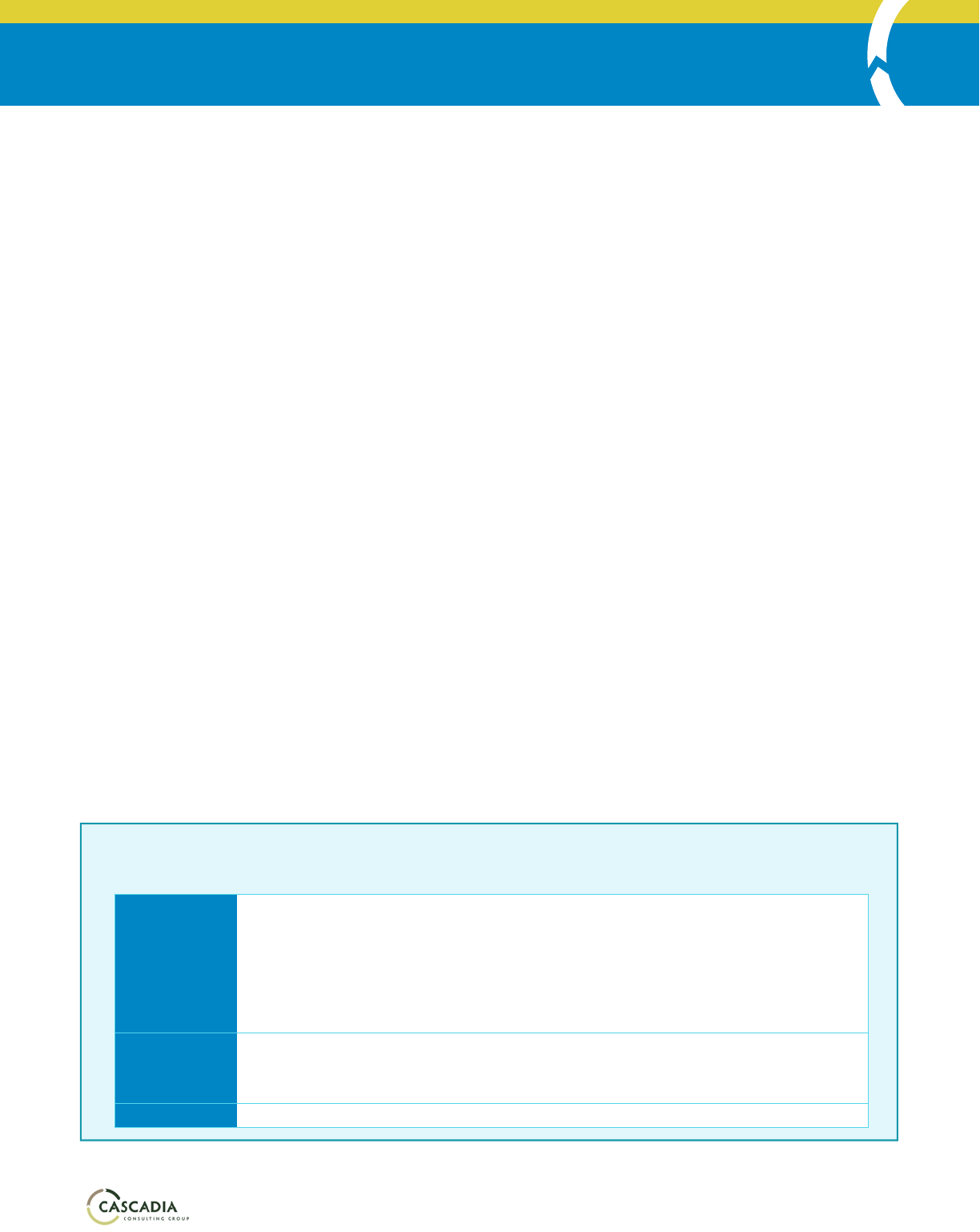
WASHINGTON STATE FOOD WASTE MANAGEMENT EVALUATION
1
BACKGROUND AND INTRODUCTION
CascadiaConsultingGroup,Inc.(Cascadia)beganthisevaluationofWashingtonState’sexcessfoodandfoodwaste
managementsysteminJanuary2020onbehalfoftheDepartmentofCommerce(Commerce)andtheDepartment
ofEcology(Ecology).ThepurposeoftheevaluationistosupporttheUseFoodWellWashingtonPlan(Plan)being
preparedbyEcologyunderHB1114.Thisundertakingrecognizestheimportanceofunderstandingcurrentdataasa
startingpointtodevelopandimplementplanstoreduceanddivertfoodwastemovingforward.
ThegoalofthePlanistoreduceby50percenttheamountoffoodwastegeneratedannually
inthestateof
Washington,relativeto2015levels,usingthefollowingstrategies:
Strategy1:Preventandreducetheamountofediblefoodthatiswastedbyresidentsandbusinesses.
Strategy2:Helpmatchandsupportthecapacityforediblefoodthatwouldotherwisebewastedwithfood
banks
andotherdistribu torsthatwillensurethefoodreachesthosewhoneedit.
Strategy3:Supportproductiveusesofinediblefoodmaterials,includingusingitforanimalfeed,energy
productionthroughanaerobicdigestion,orothercommercialuses,andforoff-siteoron-sitemanagement
systemsincludingcomposting,vermicomposting,orother
biologicalsystems.
ThisevaluationaimstosupportStrategy3bycreatingasnapshotofthequantityandtypesoffoodflowingthrough
WashingtonState’shungerrelief,animalfeed,compost,andindustrialusessystemsanddescribingthecapacityof
thesesystemstomanagemorematerialinthefuture,asapreferablealternative
tolandfill.
CascadiacompletedthisevaluationwiththeassistanceofstakeholderscreatingthePlan,including:
TheCoreTeam,asupportanddecision-makingstructureledbyMaryHarringtonofEcologyth atmeets
monthlytohelpdevelopthePlan,engagestakeholders,andensurec ompliancewithlegislativemandates.
Itismadeup
ofemploye esfromstategovernmentagenciesthatwillbeaffectedbythePlan,includingthe
DepartmentofAgriculture(WSDA),DepartmentofHealth(DOH),OfficeoftheSuperintendentofPublic
Instruction(OSPI),andDepartmentofCommerce(Commerce).
SubjectMatterExpert(SME)WorkGroups,whichwereformedtoassistwiththe
Planinrecognitionthat
reducingwastedfoodwillrequiremanyfieldsofexpertiseworkingtogetherincooperation.SMEsreceive
invitationstoparticipateinworkgroupsasregularlyastheychoose.
Terms and Definitions
ThetermsusedinthisreportreflectthoseusedinthetextofHB1114.
FoodWaste
Wastefromfruits,vegetables,meats,dairyproducts,fish,shellfish,nuts,seeds,
grains,andsimilarmaterialsthatresultsfromthestorage,preparation,cooking,
handling,selling,orservingoffoodforhumanconsumption.Includes,butisnot
limitedto,excess,spoiled,orunusablefoodandincludesinediblepartscommonly
associatedwithfoodpreparationsuchaspits,shells,bones,andpeels.Doesnot
includedeadanimalsnotintendedforhumanconsumptionoranimalexcrement.
FoodWaste
Management
Anymanagementoffoodthatwasn’tconsumedbyitsprimaryintendedrecipient.
Includesdistribution,processing,preserv ing,serving,sel ling,andcomposting.Does
notincludedisposal.
WastedFood Theedibleportionoffoodwaste.
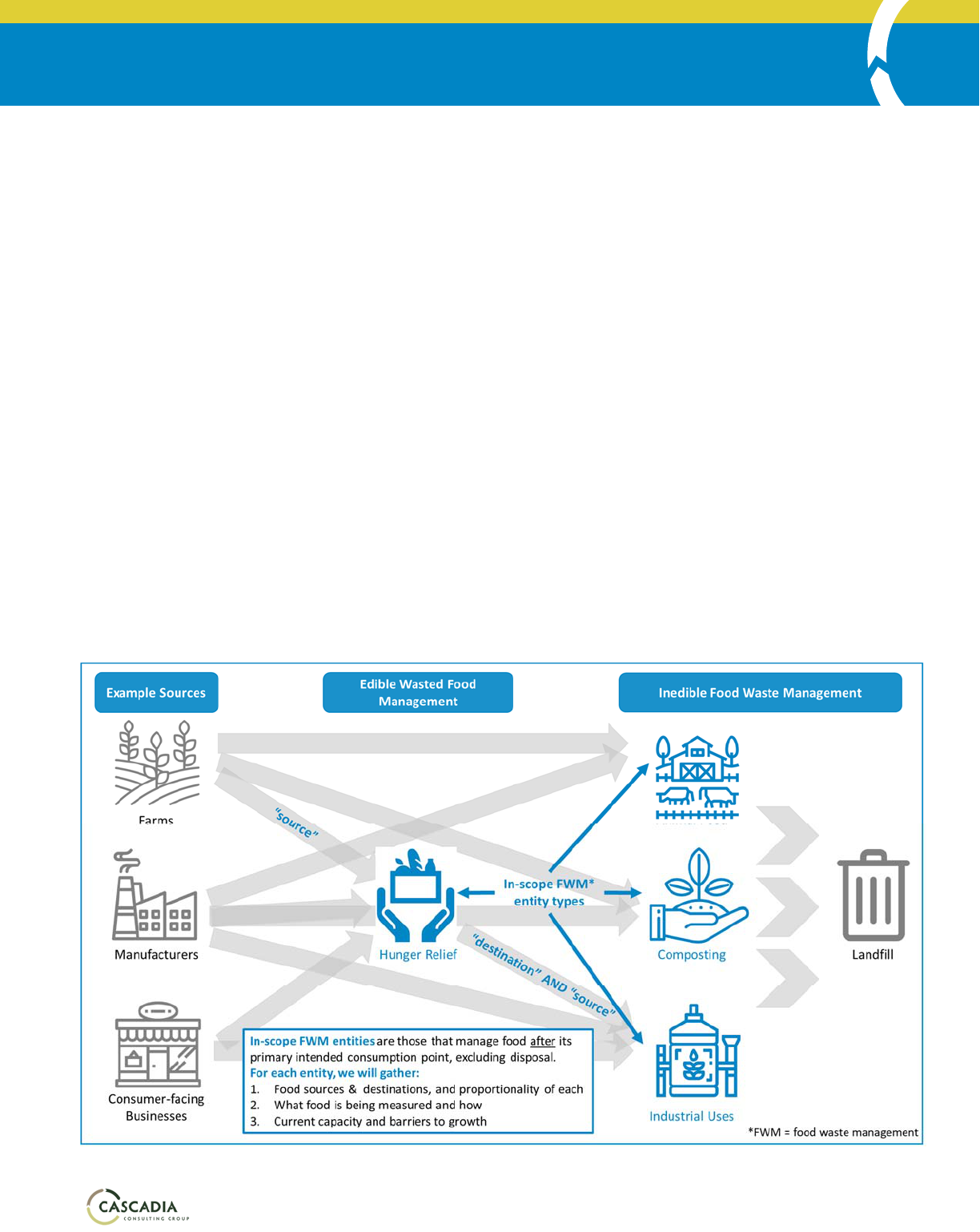
WASHINGTON STATE FOOD WASTE MANAGEMENT EVALUATION
2
SYSTEM AND GEOGRAPHIC BOUNDARIES
Duringthisevaluation,Cascadiaconsideredthreemainresearchareas:currentflowsoffoodwasteandwasted
food,themetricsandreportingprotocolsusedtotracksegmentsofthoseflowsovertime,andtheexisting
capacity,barriers,andopportunitiesfordifferenttypesofentitiestomanagefoodwasteandwastedfood.To
guide
projectwork,Cascadiadefinedthefollowingcorequestionsbyresearcharea:
A. FlowofFood:Howmuchfoodiscurrentlyflowingthrougheachentityinthefoodwastemanagement
system,i.e.,hungerrelief,animalfeed,compost,andindustrialuses?
B. Metrics&Protocols:Foreachentity,whatisbeing
measuredandhowisitbeingmeasured?What
opportunitiesexisttoharmonizemetricsandprotocolsacrossthesystem?
C. SystemCapacity:Whatisthecurrentcapacityofeachentityinthesystemtohandlewastedfoodand/or
foodwaste?Whatarethebarrierstoincreasingthecapacityofeachentity
inthesystem?
System Boundaries
Thisevaluationfocusesonthehand linganddispositionoffoodafter its primary intended point of consumption,
excluding landfill.Accordingly,ourscopeiscomposedoffourfoodwasteandwastedfoodmanagemententity
types:hungerrelieforganizations,animalfeeddistributorsanddirectusers,compostfacilities,andindustrialusers.
Entitiesthatgeneratefoodwaste,suchasfarms,consumer-facingbusinesses,
wholesalers,ordistributorsareoutof
scopeforthisevaluation.Figure1illustratesthesescopeboundaries.
Figure1.ProjectScopeBoundaries
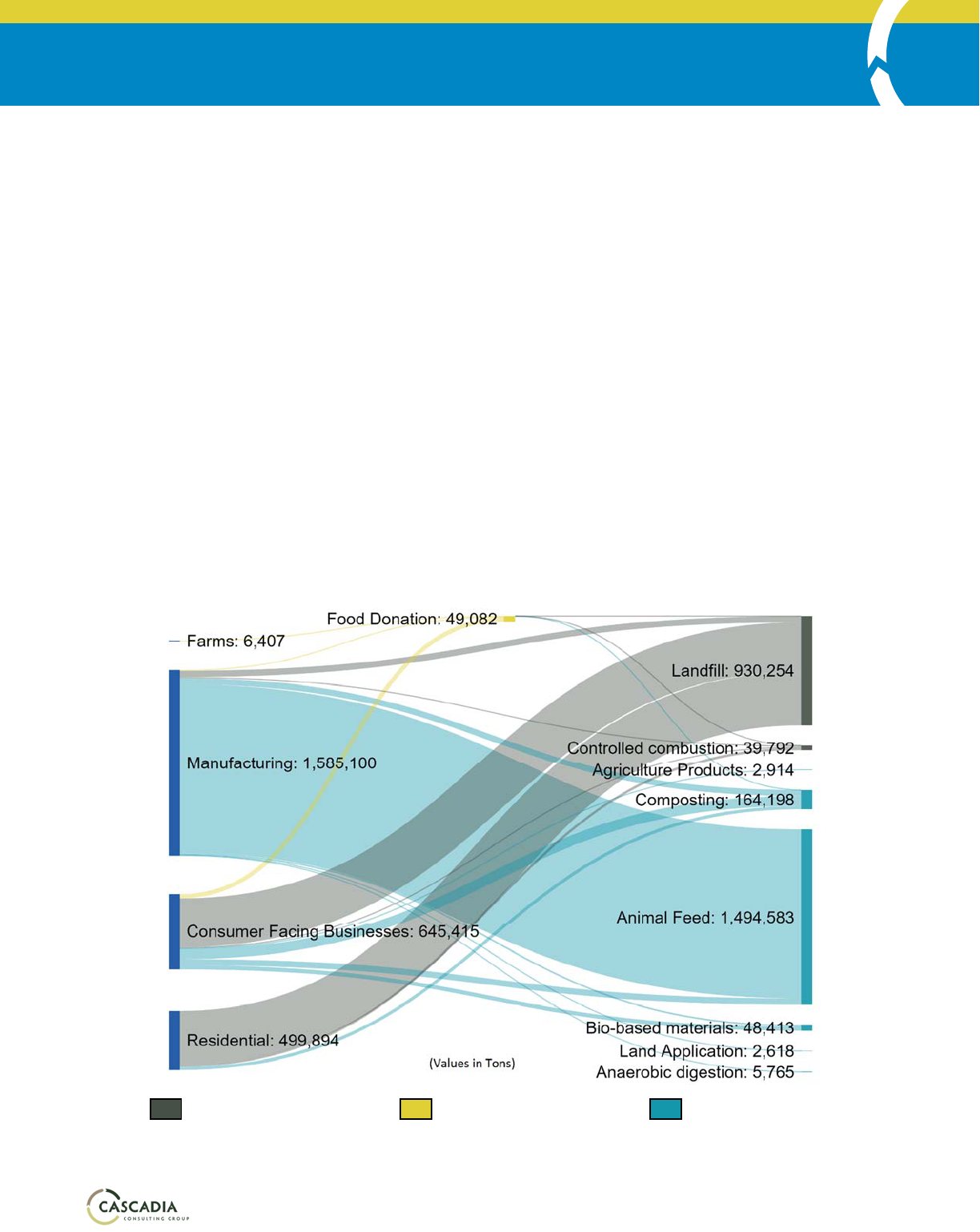
WASHINGTON STATE FOOD WASTE MANAGEMENT EVALUATION
3
Geographic Boundaries
WhilethescopeofthisevaluationdoesnotincludeentitiesoutsideofWashingtonState,werecognizethatsome
surplusfoodand/orfoodwastehandledbyin-scopeentitiescomesfromout-of-statesources.Wehaveincluded
thesesourcesofsurplusfoodandfoodwastetoprovidecontextforunderstandingthecapacityofin-stateentities.
Theseamountsarenotedandseparatedwherepossible.
EXECUTIVE SUMMARY AND KEY FINDINGS
Flows of Food Waste and Wasted Food in Washington State
Basedonsecondarydatacollectionefforts,literaturereviews,andextrapolationofdatasets,weestimatethat
WashingtonStategenerates2.7milliontonsoffoodwaste.Ofthisamount,1.7milliontonsarerecoveredbyhunger
relieforganizations,animalfeeddistributorsanddirectrecipients,compostfacilities,andanaerobicdigesters.The
remaining1.0million
tonsgotolandfill(96%)orcontrolledcombustion(4%).Figure2illustratestheestimated
generationacrossfoursegmentsofthefoodsupplychainthatareconsistentwithReFED’ sRoadmaptoReduceUS
FoodWaste:farms,foodmanufacturers,consumer-facingbusinesses(includingdistributors,retailgrocers,
restaurants,foodserviceproviders,andinstitutions),andresidential
(includingalldwellings).Thedataandmodel
thatproducedtheestimatesinFigure2andthroughoutthisdocumentaresummarizedinAppendixA:.
Figure2.WashingtonStateFoodWasteandWastedFoodManagementPathways(tons)
FoodWasteDisposalFlow FoodDonationFlow FoodRecoveryFlow
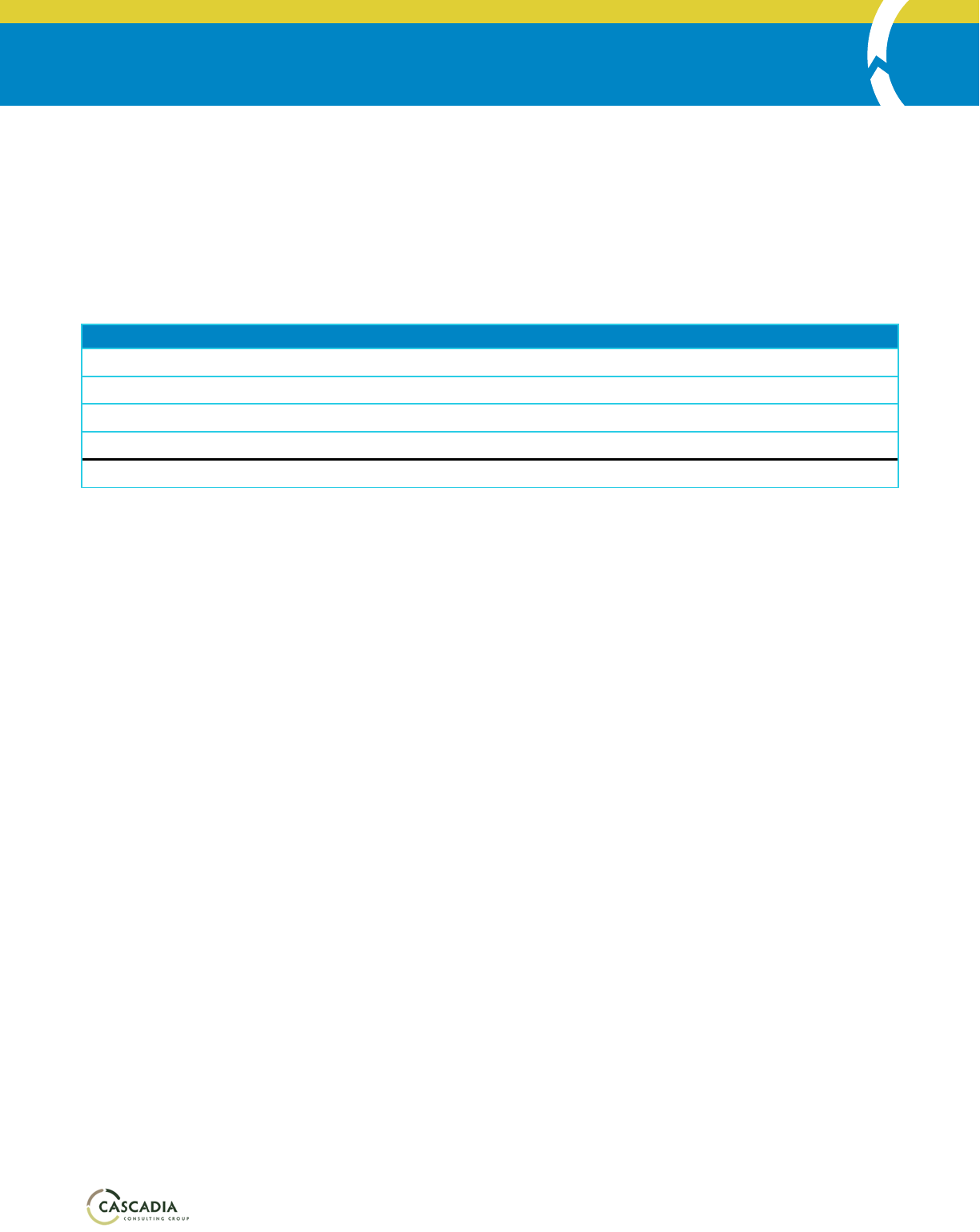
WASHINGTON STATE FOOD WASTE MANAGEMENT EVALUATION
4
Edible Wasted Food to Landfill
Thedistinctionbetweenedibleandinediblefoodismeaningfulandnecessarywhenmeasuringthepotentialfor
increasingfoodrecoveryforhumanconsumption.Toourknowledge,WashingtonState’s2015-2016statewide
wastecharacterizationstudywasthefirstlarge-scalestudyinWashingtonincludethisdistinction.Table1shows
resultsfromthatstudybysector.
Overall,47percentoffoodwastetolandfillwasidentifiedasedible.(Cascadia
ConsultingGroup,2018)
Table1.2015-2016WashingtonStatewideWasteCharacterizationStudyEdibleFoodPortionsofDisposedOrganics
Sincethecompletionofthisstudy,otherWashingtoncityandcountywastestudieshavemeasurededibleand
inediblefood.Accordingtoa2019study,KingCountyresidentsandbusinessesgeneratedanestimated234,600
tonsoffoodin2018.Thestudyestimatedthat“39to70percent—approximately91,300to163,400tons—isedible
wastedfood,whereediblefoodisdefinedasanymaterialintendedforhumanconsumption,regardlessofwhether
itwasspoiledorpartiallyconsumedatthetimeofdisposal”(CascadiaConsultingGroup,2019).
Thereisnotastatewideorganicscharacterizationstudythatdistinguishesbetweenedibleandinediblefoodin
WashingtonState.
Key Findings
Keyfindingsfromourevaluationareoutlinedbelow:
Manufacturinggeneratesthemajorityoffoodwaste(58%),followedbyconsumer-facingbusinesses(24%),
andthentheresidentialsector(18%).
o Ahighpercentageofmanufacturingandprocessingwasteisrecycledintoanimalfeedand
compostproducts:96percent.Muchofthisquantity
isspentgrainandotherby-productsfrom
brewersanddistilleries,whichcouldnoteasilybedonatedforhumanconsumption.
o Restaurantsgeneratealmosthalf(46%)ofthefoodwastefromconsumer-facingbusinesses.The
nextlargestgeneratorissupermarketsandgrocerystores,accountingforalittleoverafifth(22%)
of
ConsumerFacing Businessfoodwaste.
Animalfeeddistributorsanddirectrecipientsarereceivingthehighestpercentageoffoodwas te(55%) of
thefoodwastemanagementpathwaysconsideredinthisevaluation,primarilyfrommanufacturing
operations.
Landfillsreceivethesecondhighestpercentage(34%)offoodwasteandwastedfood.
o Every
generatortypeweconsidered,exceptmanufacturing,sendsmorefoodwasteandwasted
foodtolandfillthananyothersingledestination.Residentialsourcessendapproximately91
TotalFood(tons) EdibleFood(tons) EdiblePortion(%)
Residential 369,178 159,923 43.3%
Commercial 390,757 191,746 49.1%
Self-HaulC&D 3,580 1,589 44.4%
Self-HaulOther 32,579 21,233 65.2%
Statewide 796,094 374,490 47.0%

WASHINGTON STATE FOOD WASTE MANAGEMENT EVALUATION
5
percentofallfoodwastetolandfillandconsumer-facingbusinessessendanestimated67percent
oftheirfoodwastetolandfill.
o Differentcommercialsectorshavedifferentlevelsofrecovery.Whileoverall,consumer-facing
businessesrecoveraboutathird(33%)offoodwaste,restaurantsandinstitutionssendmostof
theirfoodwaste
tolandfill.Restaurantssendanestimated88percentoftheirfoodwastetolandfill
andinstitutions.Groceryretailerssendonly39percentoffoodwasteandwastedfoodtolandfill
andmostoftheirfoodwasteandwastedfood(61%)goestohungerrelieforganizations,compost,
andanimalfeed.
Anestimatedsixpercentoffoodwasteiscompostedacrossthestate.Mostcompostedfoodwasteis
comingfrommanufacturingandwholesaledis tributors,31percentand26percentrespectively.Residential
foodwastecontributesonly16percentoffoodgoingtocompost.
Ofthefoodenteringthestate’sfoodwastemanagement
pathwaysincludedinthisevaluation,only2
percentisdistributedtohungerrelieforganizations.Themainsourcesofdonationsarefarmsandgrocery
retailers.
Summary of Current and Recommended Reporting Protocols by Entity Type
Throughoutthisevaluationprocess,Cascadiafoundthatexistingdatawereoverallnoteasilyaccessibleandwere
spreadoutbetweenagenciesandotherstakeholders.Table2providesdescriptionsofexistingdatareporting
protocolsbyentitytypeandrecommendationstosupportdatamanagementforHB1114.Somerecommendations
willmaketrackingandreporting
morecomplicatedforthosesubm ittingit;theserecommendationsareidealfor
supportingHB1114,butmaynotbeidealforEcologytoimplementinotherways.Moredetailedsummariesof
currentandrecommendedtrackingandreportingarelistedintheFindingsbyEntityTypesectionbelow.
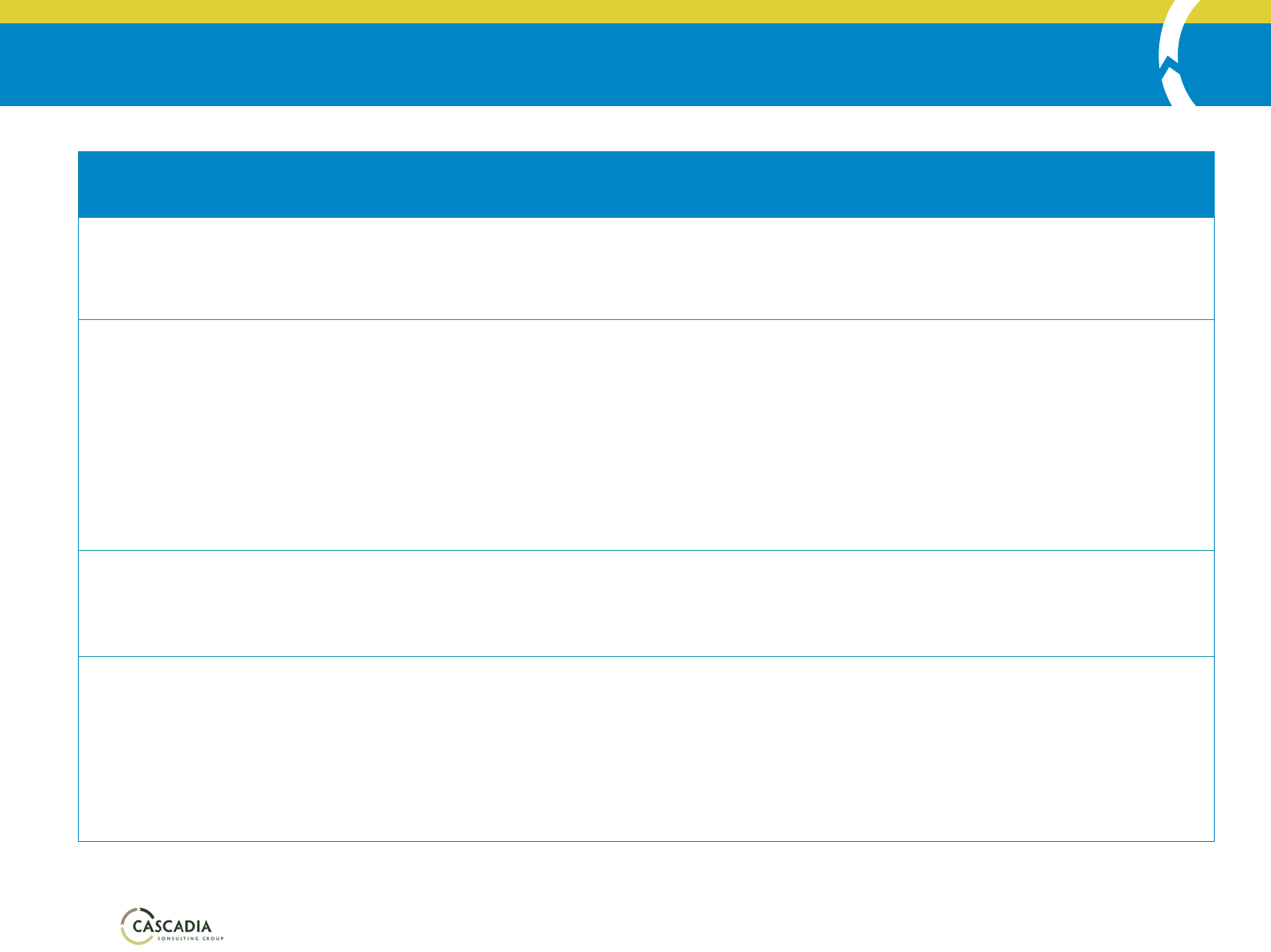
WASHINGTON STATE FOOD WASTE MANAGEMENT EVALUATION
6
Table2.CurrentandRecommendedReportingProtocolsandMetricsbyEntityType
EntityType
CurrentEntityDataReporting
Protocols
Recommended
ChangestoEntity
ReportingProtocols
CurrentStateAgenciesReporting
Metrics
RecommendedAdditionalMetricsfor
StateAgencyReporting
HungerRelief
Organizations
Organizationsreportannuallytolarge
fooddistributionnetworks.Reportingto
Ecologyisoptional.
Largedistribution
networkssubmitannual
reportingtoWSDA
and/orEcology.
Listofentitiesserved
Poundsoffooddistributed
and/orservedannually
Numberofindividualsserved
Entitylocation(zipcode)
Poundsoffooddonated
vs.purchased
Donororsellertype
Poundsoffoodtocompost/animal
feed/landfill
AnimalFeed
Feedcompaniesarelicensedandsubmit
annualreportingtoWSDA.
Petfoodcompaniesthatonlyproduce
petfoodmustregisterandsubmitsemi-
annualreportsaboutproductstoWSDA.
Reportsdonotincludeingredients.
Farmsdonotreportaboutfeed.
Farmssubmit
informationaboutfood
wasteusedasfeedas
part
ofanexistinglicense
orreportingprocess
Feedcompanies:Tonsoffeed
distributedbyingredientcategory
Petfoodcompanies:Productssold
Farms:Nometricssystematically
tracked
Feedcompanies:
Tonsoffeedreceivedbyingredient
category
Relevantingredientcategoriesmarked
forHB1114tracking
Specifichumanby-productingredients
Wetvs.drytons
Petfoodcompanies:Quantityoffoodwaste
ingredientsusedinproducts
Farms:Quantityoffoodwasteingredientsused
asfeed
Compost
Facilities
Compostfacilitiesaboveacertainsize
thresholdrequiresolidwastepermitsand
reporttoEcologyannually.
Compostfacilitiesbelowthepermitting
thresholddonotsubmitreports.
None
Feedstocksreceivedbypermitted
compostfacilitiesbytype,including
foodprocessingwaste,post-consumer
foodwaste,yarddebris/foodwaste,
andsometimes,otherfoodwaste.
None,
butfoodwastecategoriesshouldremain
thesameyearbyyearandideallybe
accompaniedbydefinitionsforcompost
facilitiesformaximumconsiste ncy.
Anaerobic
Digesters
Dairydigestersprocessingmanureas
50%ormoreandnon-manureorganicsas
nomorethan30%offeedstockvolume
submitannualreportstoEcologyand
localhealthdepartments.
Small-scaledigesterswithnomorethan
5,000gallonsor25cubicyardsof
materialon-siteatatimearepermit-
exemptandsubmit
noreports.
Dairydigesters:None.
Small-scaledigesters:
Voluntaryannual
reportingtoEcologyis
recommended.
Dairydigesters:
Feedstocktypesandamounts
Digestateamountandanalysis
Small-scaledigesters:
Feedstocktypesandamounts
Digestateamountandendproduct(s)

WASHINGTON STATE FOOD WASTE MANAGEMENT EVALUATION
7
Recommendations for Future Measurement Studies
MostfoodwasteandwastedfoodmetricsavailabletoWSDAandEcologyaremeasuredandreportedbyind ividual
entities,asdescribedinTable2.Inadditiontorecommendednewmetricstoincludeintheseongoingreporting
protocols,therearealsoopportunitiesforstateagenciestocollectdataontheirown.To
bolstertheinformation
availableandbestsupportHB1114,agenciescouldconductadditionalprimarydatacollectionstudiesaboutfood
wasteandwastedfood,outlinedbelow:
Hunger Relief Organizations
Conductabarriers andopportunitiesstudybyentitytypeandge ographytogleaninsightsaboutunique
barriersandopportunitieswherelocal,regional,andState
agenciescouldprovidesupport.
Conductagenerator-basedwas techaracterizationstudyofhungerrelieforganizationsanddonorsfora
morenuancedlookattheirwastestreamswithoutaddingstrenuousreportingrequirementsforhunger
relieforganizations.ThisdatacollectionshouldbeconductedincollaborationwiththeHungerReliefSME
WorkingGroup
andcouldresultinanadjustablemodelthatWSDAorEcologycouldusetotrackprogress
goingforward.
Measureedibleportionsofdisposedfoodinstatewidecharacterizationstudiesviaaddedmaterial
categories.
Animal Feed
Surveyfarmstounderstandtheextentofdirectrelationshipsbetweenfoodwastegenerators andfarms
using
foodwasteasanimalfeed.
Compost
Conductbarriersandopportunitiesstudyaboutcompostprogramparticipationtounderstandlowratesof
compostinginWashington,especiallyamongresidencesandrestaurants.
Conductcomposterfeedstockcharacterizationstudiestotracklevelsofcontaminationandthesuccessof
foodwastediversionprograms.SupportSmall‐andCommunity‐ScaleCompostSystems.
Anaerobic Digestion
Conductinterviewsofon-farmanaerobicdigesterstounderstandtheirsourcesoffoodwaste,challenges,
andopportunities.
Offervoluntaryreportingforsmall-scaledigestercompaniesorindividualsitestocollectinformationabout
theirinputsandoutputs.
Challenges and Opportunities for Increasing Capacity
Hunger Relief Organizations
ThehungerreliefsysteminWashingtonStatefacessiloedorganizationscompetingforresourcestoaccomplish
overlappinggoalsasitsmainchallenges;thesechallengesandaneedforgreaterflexibilityinsourcingand
deliveringfoodhavebeenhighlightedduringtheCOVID-19pandemic.Themainopportunitytoimprovecapacityis
tostrengthen
channelsforcommunication,collaboration,andresourcesharing–bothbetweenhungerrelief
organizationsandwithdonors.Thiswouldenablefooddonorsandhunger relief organizationstosharefoodand
resourcesefficiently,distributefoodwithinsafetywindows,andreducetheamountoffoodgoingtocompostand
landfill.

WASHINGTON STATE FOOD WASTE MANAGEMENT EVALUATION
8
Animal Feed
Thisevaluationhasfoundthatanimalfeedpathwaysmaybeneartheircapacitytoacceptfoodwastebecausemost
foodwasteappropriateforthisuseisalreadysenttocommercialfeedcompanies.Withmicrobreweriesand
distilleriesgainingtractioninWashingtonState,theremaybeadditionalfeedstocksavailable,especiallyforfarms
willingtocreateindividualrelationshipswithgenerators.
Compost
Thereareseveralchallengesthatcompostfacilitiesfacetoexpandcapacityingeneral,suchaslengthypermitting
processesandNIMBYismduetoneighborconcernsaboutodors.Therearealsospecificchallengesforcompost
facilitiestoacceptmorefoodwastefeedstocks,suchasa
higherneedforodorandcontaminationmanagement.
Mainopportunitiesincludetappingpublicsectorandagriculturalmarkets,advertisingcarbonsequestration
potentialandotherenvironmentalbenefits,providingupstreameducationtoreducecontaminationatthepointof
foodwastedisposal,andcombininganaerobicdigestionwithcompostfacilities.
Industrial Uses
Themajorchallengesfacinganaerobicdigesters
areeconomic:highup-frontcosts,costsofoperationsand
maintenance,andunstablenaturalgasmarketsthatobscurethebenefitsofrenewablenaturalgasproduction.In
addition,digestatecanbedifficulttointroduceasasoilamendmentbecausetherearesomanydifferenttypesof
soilamendmentsonthemarketalready.For
small-scaledigesters,opportunitiesincludeclientsinterestedin
keepingthebenefitsofdigestionon-siteandaninnovativeblockchain-basedtrackingsystembeingpilotedby
ImpactBioenergytotrackdigesterinputsandoutputs.Renewablenaturalgasandnutrientrecoveryareboth
opportunitiesforon-farmanaerobicdigesterstobringinrevenueandcreatea
positiveenvironmentalimpact.
Anaerobicdigestionatwaterresourcerecoveryfacilities(WRRFs)hasbeensuccessfullyusedtomanagefoodwaste
insomemunicipalities.
DATA COLLECTION AND MODELING APPROACH
Duetoscope,budget,andtimeconstraints,thisevaluationwasnotaprimarydatacollectioneffort.Rather,itrelied
ongatheringexistingdatafromasmallgroupofrepresentativestakeholders,incl udingCoreTeammembersand
subjectmatterexpertswhoparticipatedinPlanworkinggroups.Belowisasummaryofthestepswetookto
compileandaugmentavailablequantitativeandqualitativedataaboutthefourin-scopeentitytypes.
Identify Required Data Elements and Prepare Initial Data Requests
Afterdefiningclearsystemandgeographicboundariesforourevaluation,weframedourinitialdatarequeststokey
projectstak eholdersusingtherequireddataelementsoutlinedinTable3,includingpromptingquestionsand
suggestedpossibledatasourcesforeach.
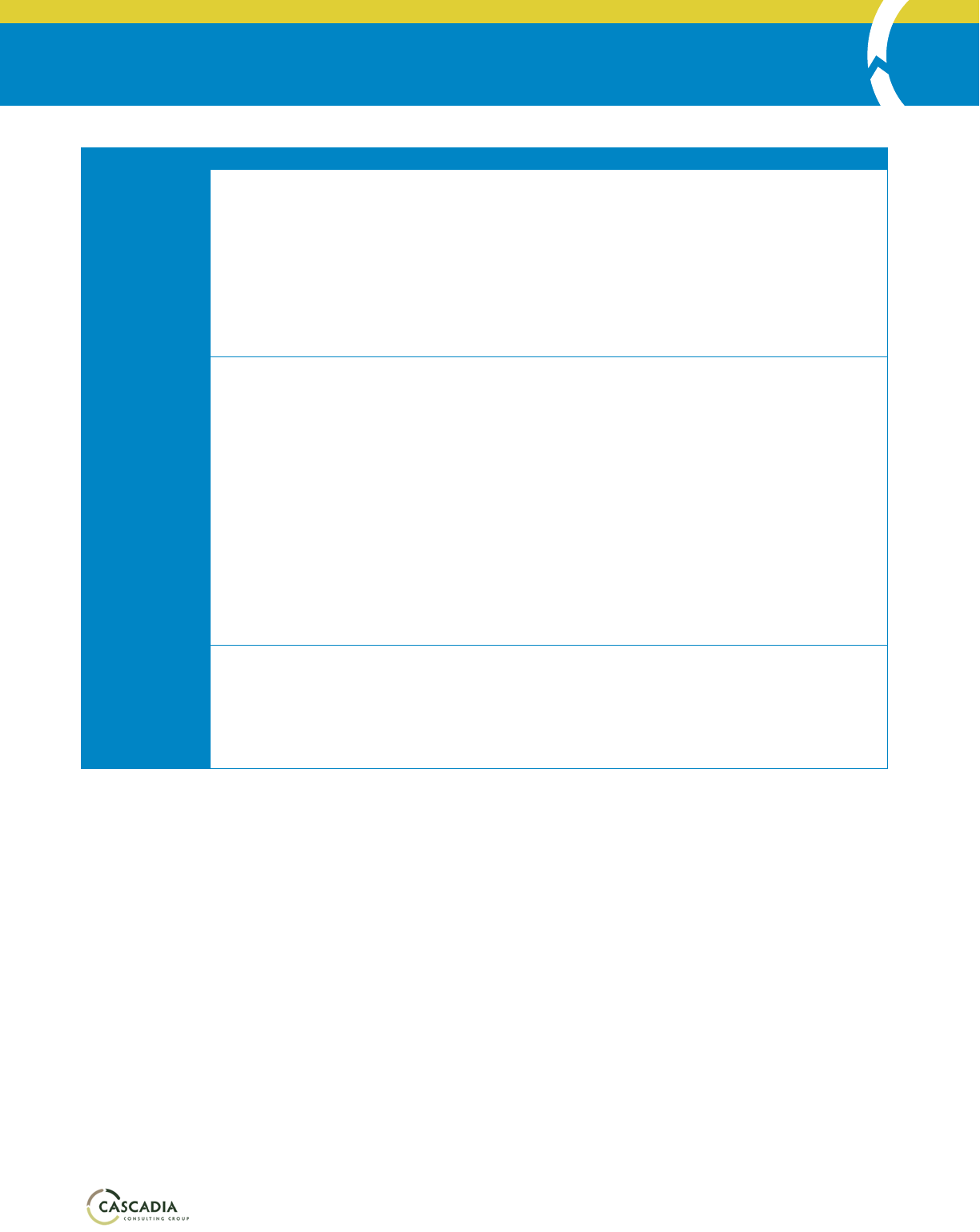
WASHINGTON STATE FOOD WASTE MANAGEMENT EVALUATION
9
Table3.RequiredDataElements
DataElement PromptingQuestions PossibleDataSource(s)
EntityListing&
Classifications
Wherecanwefindthemostcomprehensivelistingof
theseentitiesinWashingtonState?
Whatdefiningcharacteristicsormetricsareavailable
toclassifytheentitiesintosimilartypes,e.g.,sizein
termsofFTEs,operatingbudget,customersserved,
materialsaccepted,poundsprocessed,geography,
etc.?Thesemetricswillinform
datacollection
methodsandquotasbyentitygrouping.
Askidentifiedagencyto
provideavailabledata
and/orconnectuswith
someonewhocan
Quantitative
Data
Whatisthetotalquantityoffoodwastemanagedby
eachentity?
Whatarethesourcesanddestinationsoffoodwaste
managed—includingproportionalityofeach—by
eachentity?
Whatcategoriesoffoodwastearebeingmeasured
andhowaretheybeingmeasured?
Whatisthecurrentestimated
operatingcapacityof
eachentity,specificallyformanagingincomingfood
waste?Whatquantitativedataisavailableabout
basicinfrastructuresuchasrefrigeratedtrucksand
coldstorage?
DatareportedtoWSDA,
Ecology,Commerce,etc.
Exportsfrompropri etary
databases,suchasFood
Lifeline’sCeressystem
Annualreports
Qualitative
Data
Whatarethegreatestchallengestoincreasingeach
entity’soperatingcapacity?
Existingliterature
Surveysand/orinterviews
withrepresentative
organizationsasidentifiedin
Table4.
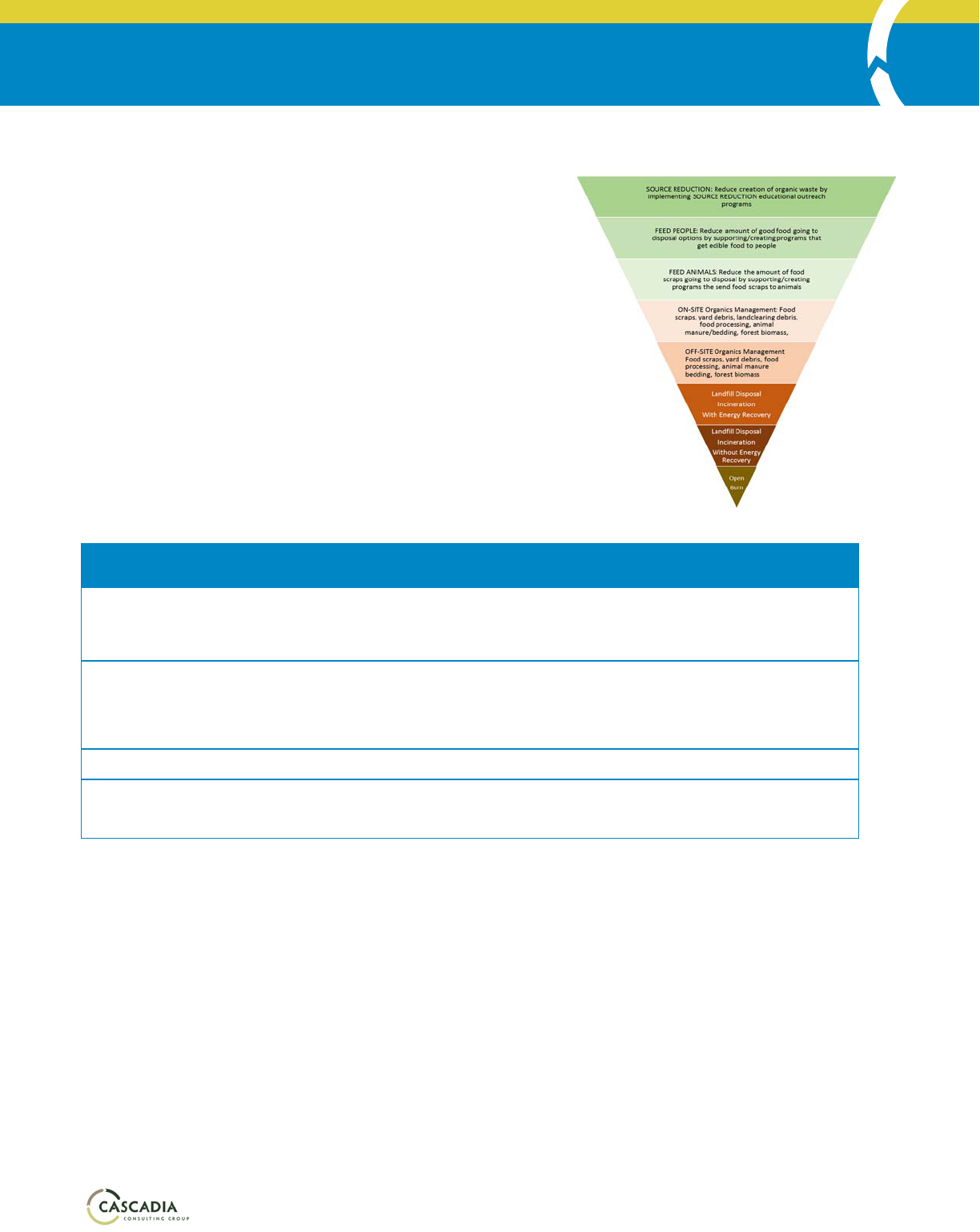
WASHINGTON STATE FOOD WASTE MANAGEMENT EVALUATION
10
Set Data Collection Priorities
Giventheproject’sacceleratedtimeline,Cascadiaworkedwiththe
planningCoreTeamtosetdatacollectionprioritieswithinour
scopeboundaries.InaccordancewiththeEcologyOrganicWaste
Hierarchy(Figure3),CascadiaandtheCoreTeamidentifiedhunger
reliefasourhighestpriority.Further,becausestatewidehunger
reliefdataisless
readilyavailableviacentralizedpublicdatasources
thanotherin-scopeentitytypes,weexpectedthathungerrelief
datacollectionwouldbemorelabor-intensivethandatacollection
forotherentitytypes.Incontrast,animalfeed,composting,and
industrialusesentitiesarefewerinnumberandalreadyhave
establishedreportingchannelsto
stateagencies,ifnotatthe
desiredlevelofdetail.
Table4summarizestheagreedupondatacollectionprioritiesfor
ourevaluation.
Table4.DataCollectionPrioritybyEntityType
EntityType In-ScopeEntityClassifications Priority
PrimaryAgencyPartner
forDataCollection
HungerRelief
Foodpantries,foodbanks,andmeal
programs,segmentedbygeography:
urban/ruralandeast/west
High WSDA
AnimalFeed
Farms
Licensedfeeddistributors
Petfoodcompanies
Mid-Low WSDA
Composting
Commercialcomposters
Mid-Low Ecology
IndustrialUses
On-farmanaerobicdigestors
Small-scaledigesters
Mid-Low Commerce
Figure3.EcologyOrganicWasteHierarchy
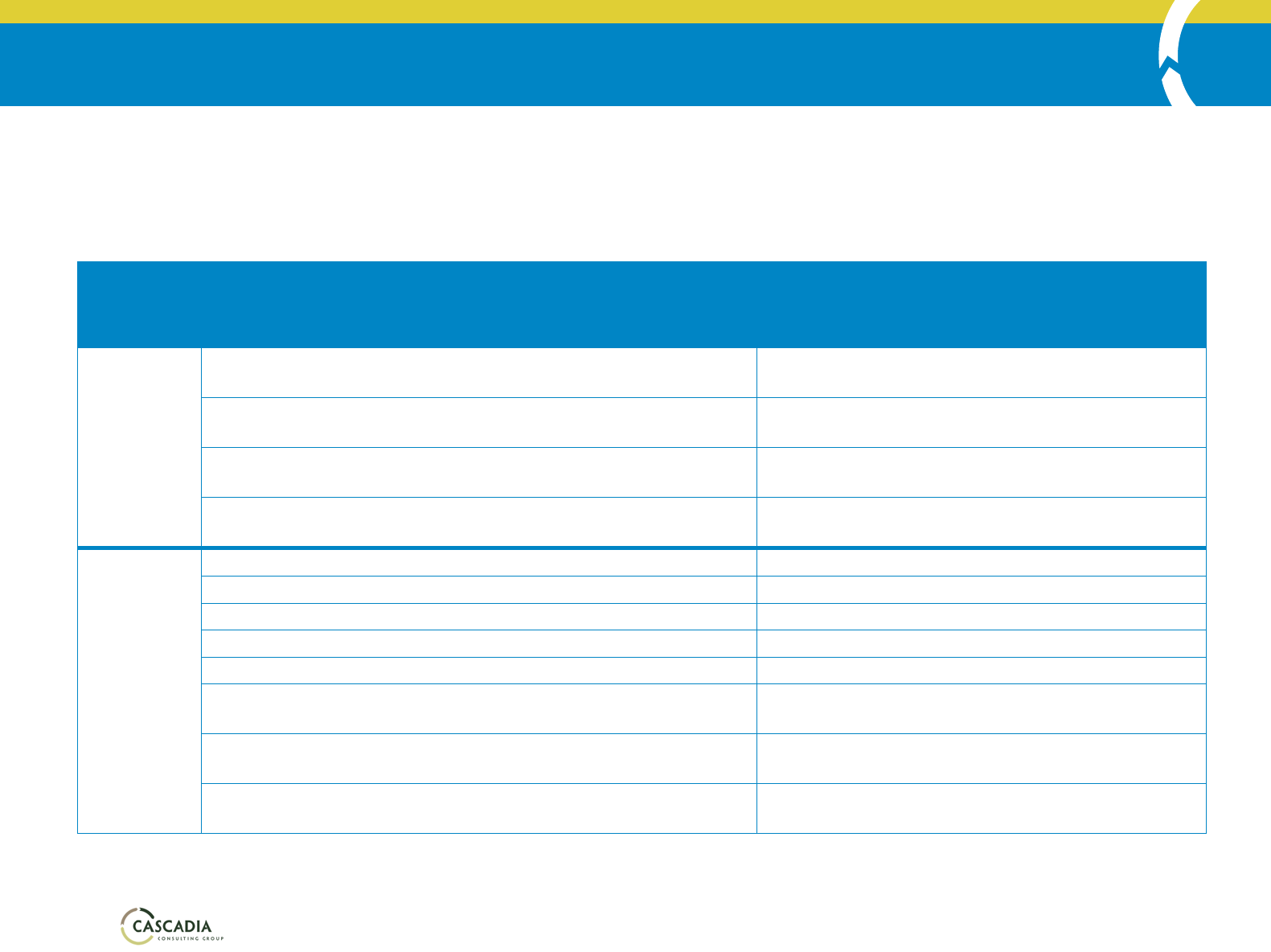
WASHINGTON STATE FOOD WASTE MANAGEMENT EVALUATION
11
Review Available Data and Literature
WorkinginpartnershipwithCoreTeammembersandSMEworkgroupparticipants,weidentified,obtained,andcompiledthedatasetsand
litera tur eoutlinedinTable5.
Table5.EvaluationDataandLiteratureSources
EntityType Sources
TypeofInformationProvided
EntityLists
and/orNumber
ofEntities
Sources,
Disposition,
Measurement
SystemCapacity,
Challenges,
Opportunities
Cross-Cutting
ReFED:ARoadmaptoReduceU.S.FoodWasteBy20Percent(Cirilli,etal.,
2016)
FoodWasteReductionAlliance(FWRA)AnalysisofU.S.FoodWasteAmong
FoodManufacturers,RetailersandRestaurants(BSR,2014)
FoodWasteReductionAlliance(FWRA)2016AnalysisofU.S.FoodWaste
AmongFoodManufacturers,Retailers,andRestaurants(FWRA,2016)
WADepartmentofEcology2015-2016WashingtonStatewideWaste
CharacterizationStudy(CascadiaConsultingGroup,2018)
HungerRelief
Organizations
ListofEFAPandTEFAPContractorsandSubcontractors(WSDA,2019)
FoodLifelineFoodBankActivityReport(FoodLifeline,2019)
NorthwestHarvestAnnualReport,2017-2018(NorthwestHarvest,2019)
FarmtoFoodPantryReport(RotaryFirstHarvest,2018)
SecondHarvestAccountabilityReport2019(SecondHarvest,2019)
Report:ModelingthePotentialtoIncreaseFoodRescue(NaturalResources
DefenseCouncil,2017)
DraftReport:StopWastePreparedFoodRescueStudyProjectSummary
(CascadiaConsultingGroup,2019)
Webinar:BetterTogether:RoodSystemBestPracticesforNavigating
COVID-19:Logistics(ReFED,2020)
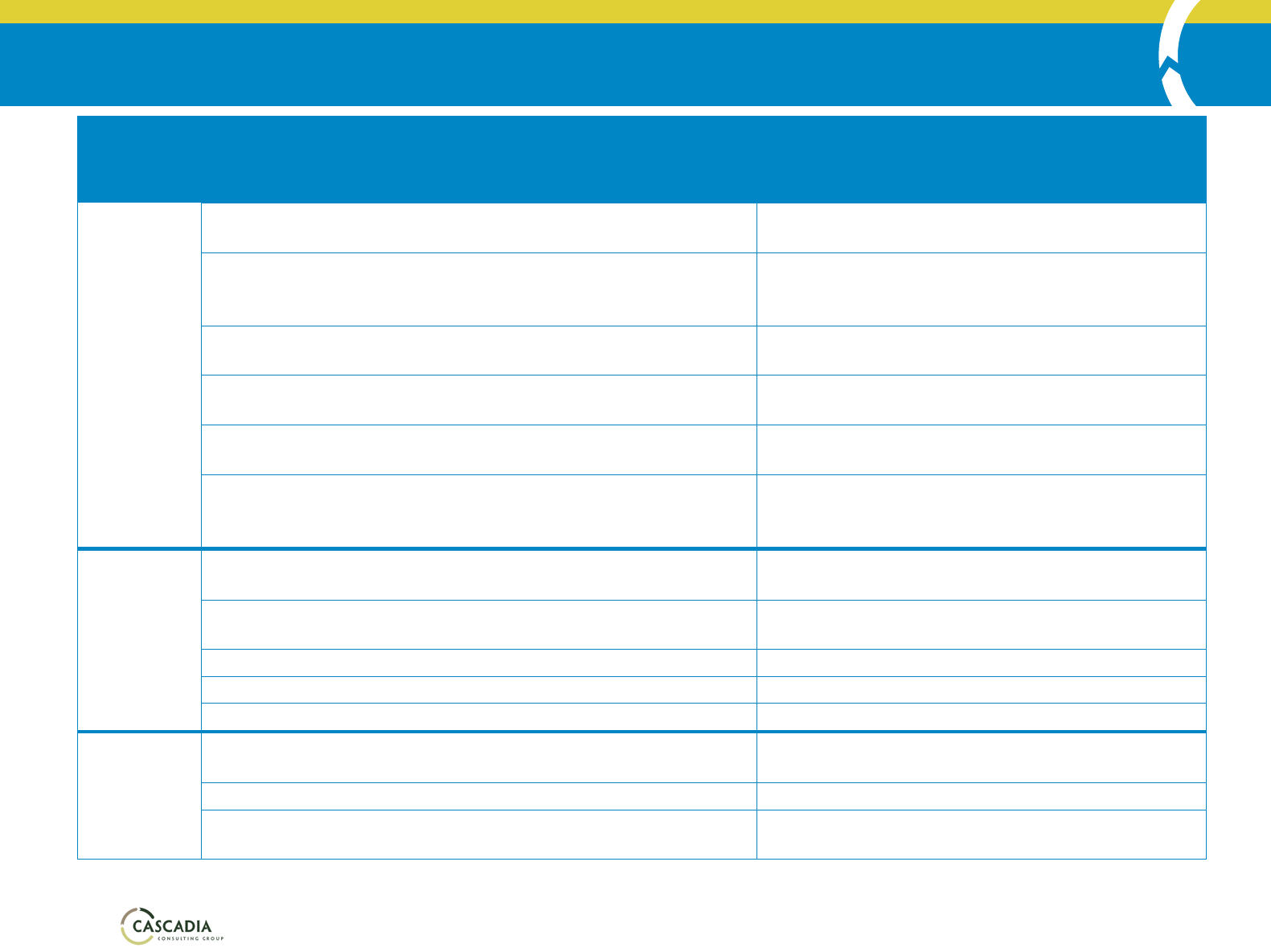
WASHINGTON STATE FOOD WASTE MANAGEMENT EVALUATION
12
EntityType Sources
TypeofInformationProvided
EntityLists
and/orNumber
ofEntities
Sources,
Disposition,
Measurement
SystemCapacity,
Challenges,
Opportunities
HealthyFoodAvailability&FoodBankNetworkReport.ReportforCityof
SeattleandSeattleCityCouncil(Bolt,etal.,2019)
Report:FoodWastePreventionandRecoveryAssessment2015,SPUand
SeattleOfficeofSustainabilityandEnvironment(Otten,Diedrich,Getts,&
Benson,2015)
Report:ATippingPoint:LeveragingOpportunitiestoImprovethe
NutritionalQualityofFoodBankInventory(MAZON,2018)
Report:FoodWasteInterventionEvaluations:ASystematicReview(Hecht
&Neff,2019)
ExcessFoodOpportunitiesMapVersion2.0–supportingdatafiles(U.S.
EPA,2019)
Report:NeedsAssessmentoftheRuralandRemoteMemberFoodBanks
oftheCaliforniaAssociationofFoodBanks(NutritionPolicyInstitute,
UniversityofCalifornia,2017)
AnimalFeed
Operations
Listoflicensedfeeddistributors(WSDA,AnimalFeedDistributor s
Licensees(In-state),2019)
USDAAgriculturalCensus,WAState(USDANationalAgriculturalStatistics
Service,2012)
CommercialFeedLicensingInformation(WSDA,2020)
AnimalfeeddistributionJuly’18-June‘19(WSDA,2020)
InterviewwithLeannKrainickofKrainickDairy(Krainick,2020)
IndustrialUses
Report:PromotingRenewableNaturalGasinWashingtonState(WA
DepartmentofCommerceandWSUEnergyProgram,2018)
Article:EconomicsofDairyDigester sinWashingtonState(Kennedy,2013)
Report:BiogasandRenewableNaturalGasInventorySB334(2017):2018
ReporttotheOregonLegislature(OregonDepartmentofEnergy,2018)
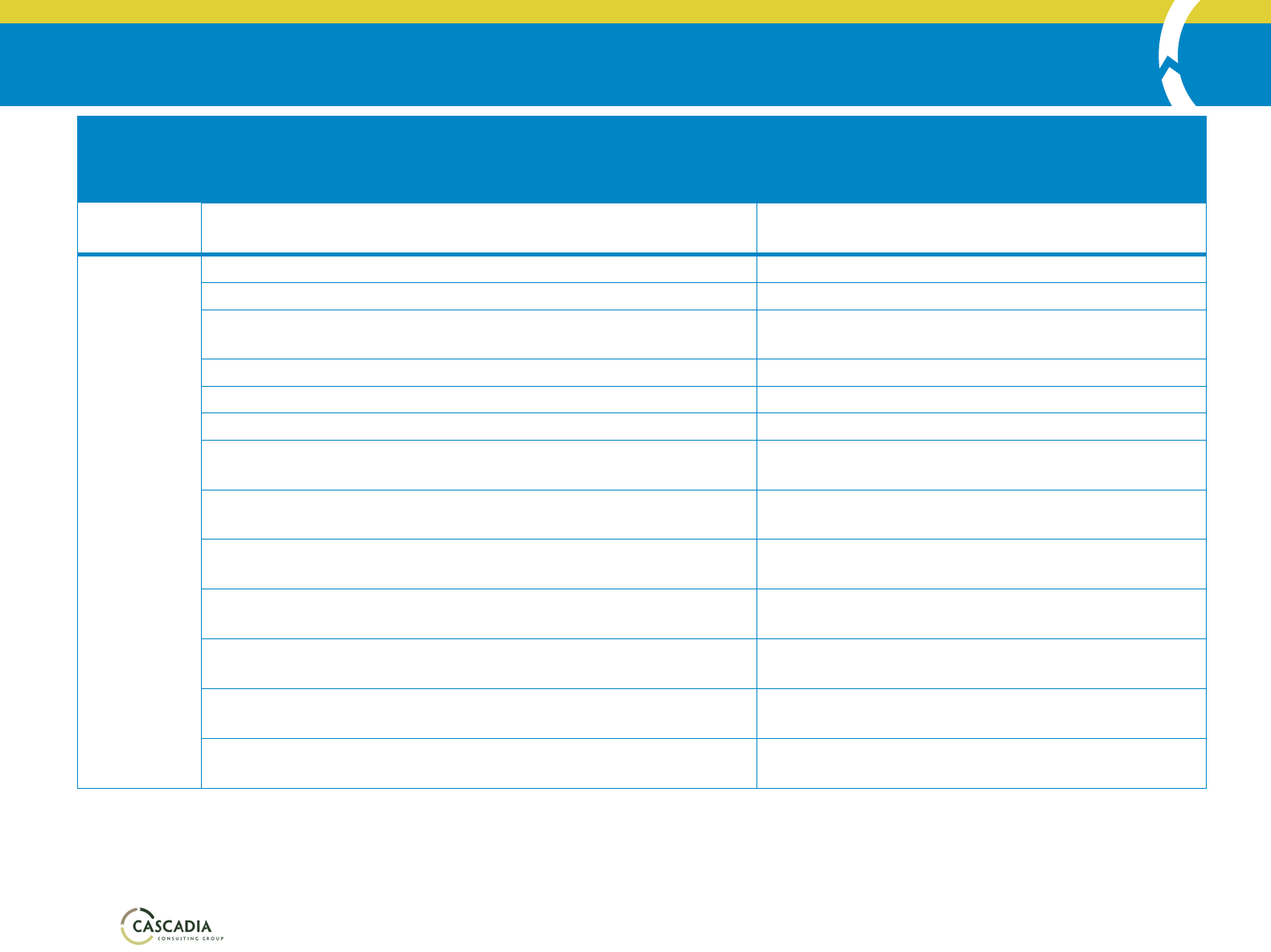
WASHINGTON STATE FOOD WASTE MANAGEMENT EVALUATION
13
EntityType Sources
TypeofInformationProvided
EntityLists
and/orNumber
ofEntities
Sources,
Disposition,
Measurement
SystemCapacity,
Challenges,
Opportunities
AnaerobicDigesterProjectandSystemModifications:AnEconomicAnalysis
(WashingtonStateUniversityExtension,2012)
Compost
Facilities
2017WACompostedMaterials(WADepartmentofEcology,2019)
2018WACompostedMaterials(WADepartmentofEcology,2020)
Report:OrganicMaterialsManagementinKingCounty(KingCountyDept.
ofNaturalResourcesandParks,2019)
Report:SB1383InfrastructureandMarketAnaly sis(CalRecycle,2019)
Article:IntegratingAnaerobicDigestionwithComposting(BioCycle,2014)
Report:ValueofCompostinAgriculturalUses(Brown,2019)
Report:MarketAssessmentforOrganicMaterialsinKingCounty(Cascadia
ConsultingGroup,2015)
Report:CommercialCompostApplicationinWesternWashingtonFarms
(Collins,Harness,&Bary,2016)
Report:OrganicMaterialsManagementinKingCounty(KingCountyDept.
ofNaturalResourcesandParks,2019)
Report:Yes!InMyBackyard:AHomeCompostingGuideforLocal
Government,InstituteforLocalSelf-Reliance(Platt&Fagundes,2018)
Report:CompostinginAmerica:APathtoEliminateWaste,RevitalizeSoil,
andTackleGlobalWarming(U.S.PIRGandFrontierGroup,2019)
ReportandToolkit(WashingtonStateOrganicsContaminationReduction
Workgroup,2 017)
Report:AdvancingOrganicsManagementinWashingtonState:TheWaste
toFuelsTechnologyPartnership(Waste2Resources,2016)

WASHINGTON STATE FOOD WASTE MANAGEMENT EVALUATION
14
Conduct Interviews and Surveys
Afterreviewingavailabledataandliterature,weconductedinterviewsandsurveyswithreleva ntstakeholder
groupstoaidinfillingdatagaps.
HungerReliefOrganizations.Theinterviewguide,foundinAppendixB:HungerReliefInterviewGuide,was
developedwithinputfromKatieRains(WSDA),KyleMerslich(WSDA),andTrishTwomey(WA
Food
Coalition).DuetodisruptionscausedbytheCOVID-19pandemicduringthisevaluation’stimeframe,itwas
neveradministered.Theguidewasintendedtobeadministereddigitallyasanema ilattachmentorverbally
asaphonesurvey.
AnimalFeedDistributorsan dFarmRecipients.Cascadiaconductedone-on-one interviewswithstaffat
WSDAandKrainickDairy.
CompostFacilities.Theinterviewguide,foundinAppendixC:CompostFacilityInterviewGuide,was
developedwithinputfromMaryHarrington(Ecology).Thegoalofthisguidewastocollectinformation
frompermittedcompostfacilitiesprocessingfoodwaste.Itwassenttocompostersasanemailattachment
tobecompleteddigitally,withtheoptionofcallingthecontactinformationlistedbyphonetocomplete
thesurveyverbally.Cascadiapre-filledthepreviousyear’sreportingtotalsineachcategorywithinthe
survey.SurveyresponsesareincludedinAppendixD:CompostF acilitySurveyResponses.
AnaerobicDigesters.Cascadiaconductedone-on-one
interviewswithstaffatCommerce,Ecology,and
ImpactBioenergy.
EmergingTechnologies.CascadiainterviewedstaffatthebiofertilizercompanyWISErg.
Conduct Data Modeling
Toestimatethequantityandqualityoff oodwasteandwastedfoodflowingthrougheachsegmentofthestatewide
foodhandlingsystembysourcesanddisposition,CascadiaworkedwithERG(EasternResearchGroup,Inc.)to
createadatamodel.
Twelvegeneratorsoffoodwasteareindividuallyevaluatedinthemodel:
Food Waste Generators
Farms
Manufacturing
Residences
Consumer-facingBusinesses*
* Consumer‐facing businesses include:
InstitutionsofHigherEducation
Hospitals
HotelsandMotels
K-12Schools
NursingHomes
Prisons
Restaurants
Supermarkets
WholesaleDistributors

WASHINGTON STATE FOOD WASTE MANAGEMENT EVALUATION
15
Generatedfoodwasteandwastedfoodisallocatedamongtwodisposalandsevenrecoverypathways.
Disposal
Landfill
Waste-to-EnergyCombustion
Recovery
Donation
AgricultureProducts
AnaerobicDigestion
AnimalFeed
Bio-basedMaterials
Composting
LandApplication
Totheextentpossible,themodelreliesondata
specifictofoodwasterecoveryanddisposalinWashingtonState.
Statespecificdatawasavailableforsevenoftheninefoodwasteandwastedfoodmanagementpathwaysshown
above.Theserecordsaredeemedtobeofhighquality.Recoveryoffoodwasteviaagriculturalandbio-based
productsrecoverypathwayswas
estimatedbasedonnationalrecoverystatisticsformanufacturers,restaurants,
supermarketsandwholesaledistributors.Themostrecentlyavailabledatawereusedforallestimates.Model
resultsestimateannualfoodwastegeneration,recoveryanddisposalinWashingtonStateforarepresentative
periodbetween2016and2019.
WashingtonStatedatagenerallyprovidedestimatesof
foodwasterecoveryanddisposalviaindividualpathways
(i.e.landfill,compost,etc.).Nationalsamplingstudyestimatesoffoodwastegeneration,recovery,anddisposal
providemoredetailandinsightintothegenerationoffoodwasteforthefollowinggeneratingsectors:higher
education,hospitals,hotels,K-12schools,nursinghomes,prisons,restaurants,supermarkets
andwholesale
distributors.WashingtonStatedatawasuseddirectlytosupplyfoodwastegenerationestimatesforfarmsand
residences.AmixtureofnationalsamplingestimatesandWashingtonStatedatawasusedforthemanufacturing
sector.EstimationmethodsbasedonnationalsamplingdataareindependentofWashingtonfoodwastedisposal
statisticsand
donotperfectlymatchreporteddatatotalsforWashingtonState.Aniterativeprocesswasusedto
facilitateconvergenceofthefoodwastemodelwithWashingtonStatedatatotalsoffoodwastemanagement
pathways.
Originalmodelestimatesoffoodwastegeneration,priortomodelfitting,yieldedavalue2.7percentgreater
than
thequantityindicatedbyWashingtonStatedatarecords.Themodelfittingprocedurereducedthisdiscrepancyto
0.18percentandalignedestimateddisposalandrecoverypathwayswithdataavailableforWashingtonStatefilling
ingapswithreasonablenationalestimates.
Detaileddocumentationoffoodwasteestimationproceduresandsourcescanbefound
inAppendixA:,andthe
accompanyingMSExcelmodel(model).Reviewofthemodel,particularlytherangeindocumentedfoodwaste
generationfactors,estimationproceduresandfoodwastemanagementpathwaydistributions,willhelpgivecontext
tothecertaintyoruncertaintywithwhichindividualsectorestimatesshouldbeviewed.
Key Food Waste Generation Assumptions
Excessfarmproductiondonatedtofoodbanks,foodpantries,andotherdonation-baseddistribution
programsistheonlysourc eoffoodwasteproducedbythefarmingsectorthatisconsideredinthis
analysis;foodpurchasesandfoodfromfederalcommoditiesprogramsdistributedbydonation
organizationsisoutsidetheproj ect’sscopeandwas
excludedfromtheanalysis.

WASHINGTON STATE FOOD WASTE MANAGEMENT EVALUATION
16
Foodwastegeneratedbyotherminorsources(e.g.officebuildings,sportsvenues),notexplicitlycalculated
bythemodel.Thesetonsaredistributedamongthetwelveincludedgenerators.Basedonthemodel’s
structure,mostofthiswasteisexpectedtobedistributedamongthenineconsumer-facingbusinesses,
potentiallyoverestimatingfoodwaste
generatedbytheseninesources.Giventhequalityofthematch
betweentheoriginalestimationandreporteddataforWashingtonState,priortomodelfitting,distortions
inmodelresultscausedbythisprocedureareexpectedtobeminor.
Key Food Waste Management Assumptions
AWashingtonStatewastecharacterizationstudy for2015-2016wasusedto
estimatethequantityoffood
wastepresentindisposedMSW(16to17percentdependingonregion)andtheshareofdisposedMSW
fromcommercialandresidentialsources(CCG,2018).
Generatedfoodwastewasallocatedtothethreecommonroutesofmunicipalfoodwastedisposal
(compost,combustion,andlandfill)
basedontotalfoodwastedisposalviathesethreepathwaysin
WashingtonStateforInstitutionsofHigherEducation,Hospitals,HotelsandMotels,K-12Schools,Nursing
Homes,Prisons,andthenon-edibleshareofdonatedfood.
WashingtonStatedatafor2018wasusedtoquantifyfoodwasteprocessedatcommercialcomposting
facilities.
Foodprocessingwastewasassumedtobeproducedbythemanufacturingsector.Post-consumer
foodwasteandyarddebris/foodscrapswereallocatedamongresidentialandcommercialge nerators
basedondataprovidedbytheWashingtonStateDepartmentofEcology.Thequantityoffoodwaste
presentinmixedyarddebris/foodscrapswasassumed
tobe10percentbasedonlimitedcompostfacility
surveydata.
Estimatesoffoodwasteusedasanimalfeedincludeanimalproducts,brewerswaste,distillerswaste,
screenings,andhumanfoodby-products.
Allfoodprocessingwastegoingtoanaerobicdigestionandlandapplicationwasassumedto beproduced
bythe
manufacturingsector.
Data Limitations
Themostsignificantlimitationofthisevaluationwastheavailabilityofdata,whichCascadiarecognizedduringthe
datacollectionprocessandtookstepstoaddress,withvaryinglevelsofsuccess.Thislimitationwasattributableto
threemainfactors:
Somedataowners,suchasanimalfeedmanufacturers,largehungerrelieforganizations,
andcompost
facilities,werenonresponsivetomultiplerequestsforinformation.Thiscouldbeduetofactorssuchas
protectivenessofproprietarydataandlimitedresources.
Oncetheneedforadditional,concertedoutreachtohungerreliefdataholderswasidentified,the
outbreakoftheCOVID-19pandemicrenderedthisimpracticaland
inappropriategiventhese
organizations’importantroleinmeetingbasicneedsofthoseimpactedduringthecrisis.
Wheredatawereavailable,theywereprovidedinag gregate(i.e.,totaltonshandled)ratherthantons
disaggregatedbysourcesanddispositions.Thesedatabegintoanswertheresearchquestions,but
severallargeandsignificant
gapsremainwherewewillrecommendfutureresearchinbelowsections.
Nationalsamplingdatawasusedtoestimatefoodwastegenerationforhighereducation,hospitals,
hotels,K-12schools,nursinghomes,prisons,restaurants,supermarketsandwholesaledistributors
havingnocomprehensiveavailabilityatthestatelevel.
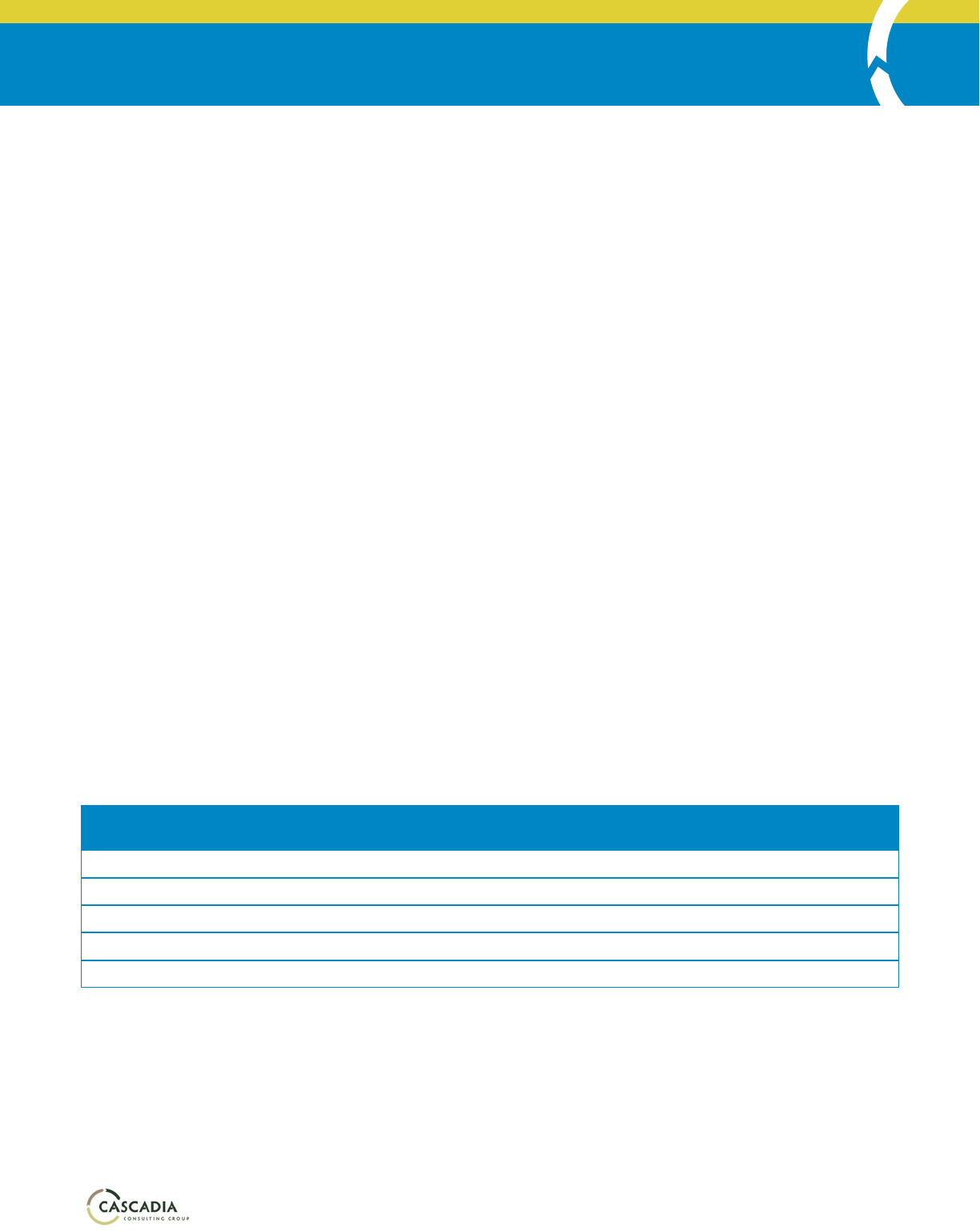
WASHINGTON STATE FOOD WASTE MANAGEMENT EVALUATION
17
Nationalsamplingdatawasusedtoestimatefoodwastedisposalandrecoveryforrestaurants,
supermarketsandwholesaledistributorsduetoalackofstatespecificdata.Otherinstitutionalfood
wastegeneratorswereassumedtodisposeoffoodwasteviatheavailablemunicipalrecoveryand
disposalsystemwhichincludescomposting,landfill,
andcontrolledcombustion.
Aswithallmodels,thismodelislimitedbythequalityofthedatauponwhichitisbased.Themodel
estimatesveryspecificvaluesbutshould onlybeviewedasestimateswithoneortwosignificant
figures.
FINDINGS BY ENTITY TYPE
Hunger Relief Organizations
Summary of Entities
UsingavailabledatafromFoodLifelineandWSDA,combinedwithonlineimpactandactivityreports,Cascadia
estimatesbetween652and724uniquehungerrelieforganizationsareoperatinginWashingtonState(Food
Lifeline,2019;WSDA,2020;SecondHarvest;NorthwestHarvest,2019;HarvestAgainstHunger,2020;WSDA,2020).
Thesenumbersareshown
inTable6.Thelongestlistofentitynamescamefromalistofrecipientsoffoodfromthe
EmergencyFoodAssistanceProgram(EFAP)andTheEmergencyFoodAssistanceProgram(TEFAP),whichoperateat
thestatelevelandthefederallevel,respectively,toprovidefundingforhungerrelieforganizationstopurchase
food.AnotherentitylistwasprovidedbyFoodLifeline.
ThelistofEFAPandTEFAPrecipientsandtheFoodLifelineentitylistcombinedtellusthatthereareatleast652
uniquehungerrelieforganizationsinWashingtonState,with112organizationsappearingonbothlists.
RepresentativesfromWSDAestimatethat
the652entitiesrepresent90percentofhungerrelieforganizationsin
WashingtonState,butadditionalresearchisnecessarytoverifythisestimate.Inaddition,therearelikelysmall-
scalelocalnonprofitsthatdonotreceivefoodfromanyofthesedistributors,althoughthequantitiestheyreceive
anddistributearemostlikely
comparativelysmall.
Table6.HungerReliefOrganizationsServedbyFoodDistributionOrganizationsandProgramsinWashingtonState
OrganizationorProgram
NumberofHungerRelief
OrganizationsServedinWA
Datayear
EFAP andTEFAP 543 2019
FoodLifeline 221 2019
SecondHarvest 227 2019
NorthwestHarvest 375 2018
FarmtoPantry 163 2019
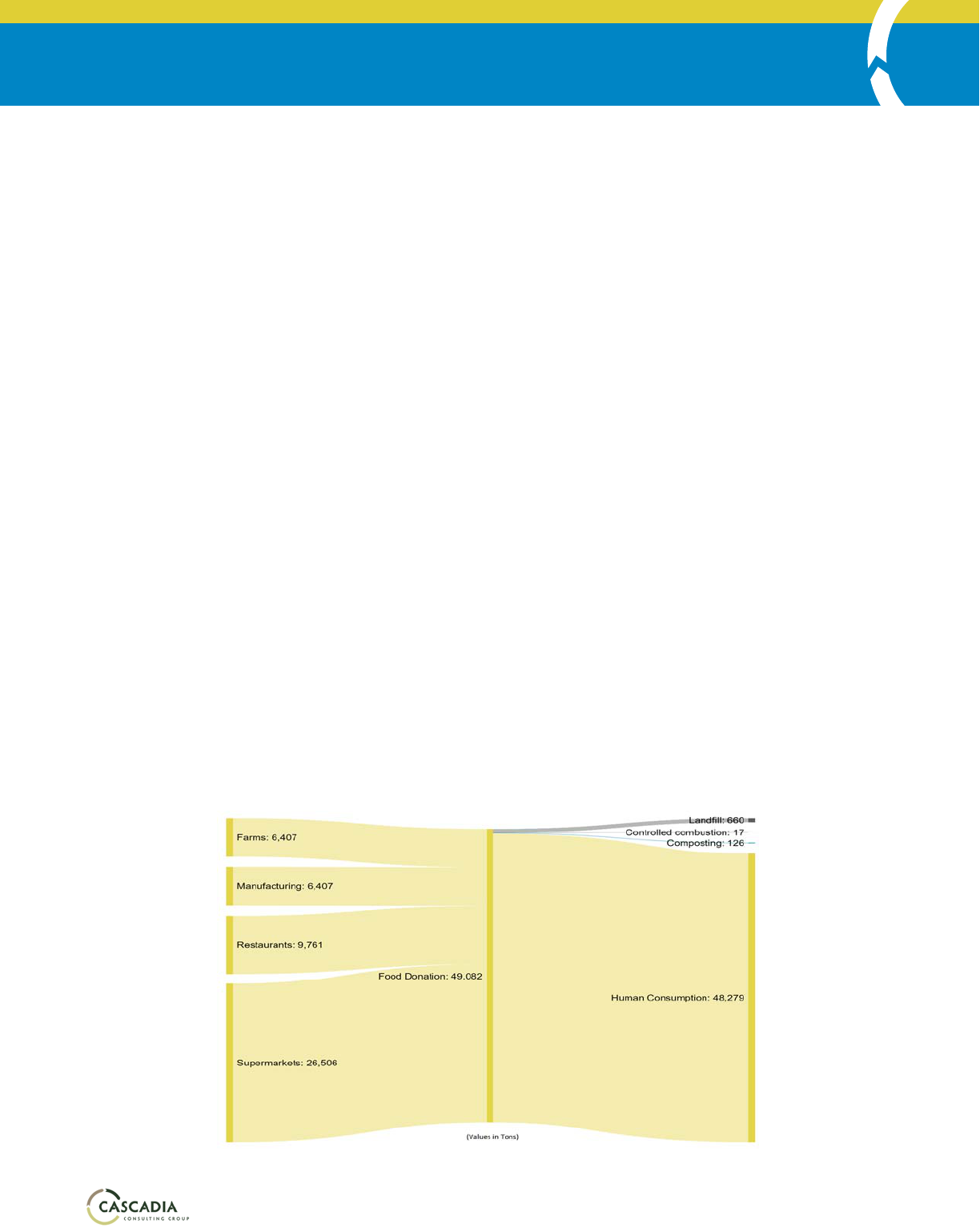
WASHINGTON STATE FOOD WASTE MANAGEMENT EVALUATION
18
Theseentitiescanbefurtherclassifiedbasedonfunctionandlocation.Therearethreemaintypesofhungerrelief
organizations,differingincustomersserved,productsdistributed,andassociatedlogistics:
Foodbanksstoreanddistributelargequantitiesoffoodtofoodpantrieswithlittletonodistributionof
fooddirectlyto
individuals.
Foodpantriesdistributefooddirectlytoindividuals,particularlyshelf-stableitemsandothertypesof
groceries.
Mealprogramsserveordistributeoneormoremealsperdaytoindividuals.
InWashingtonState,hungerrelieforganizationscanfacedifferentchallengesdependingongeography.Easternand
westernWashingtondifferbased
onpopulationdensityandavailabletransportationcorridors,providingdifferent
operatingcont extsforhungerrelief.Urbanandruralhungerrelieforganizationsfacedifferentchallengesand
opportunitiesrelatedtothedensityofdonorsandindividualrecipients,transportation,etc.(Bolt,etal.,2019)
(NutritionPolicyInstitute,UniversityofCalifornia,2017).
Flow of Food
Hungerrelieforganizations
obtainfoodthroughbothdonationandpurchase.Donationsofediblefoodcomefroma
varietyofsources.Thisfoodisnotconsideredwasteunlessitisnotservedtocustomersandissubsequentlysentto
composting,disposal,orsomeotherfoodwastemanagementpathway.Whileprovidingtheessentialserviceof
feeding
hungrypeople, WashingtonState’shungerreliefsystemalsoprevents49,802tonsoffoodfromentering
foodwastemanagementpathwayseachyear.Understandingthecapacityofhungerrelieforganizationstohandlea
potentialincreaseindonatedfoodisimportanttounderstandingtheeffectsonthestate’sfoodwastemanagement
system.
Of
the49,082tonsoffooddonationsmanagedbyWashingtonhungerrelieforganizationsin2019,approximately
54percentwasfromgroceryretaildonors,13percentwasfrommanufacturersandprocessors,20percentwas
fromrestaurants,institutions,andothercommercialkitchens,and13percentwasfromfarms,asi llustratedin
Figure4.Available
datadonotpermitfurtherdisaggregationofthesenumbersbyfoodbanks,foodpantries,and
mealprograms,respectively.
Figure4.SourcesandDispositionsofFoodforHungerReliefinWashingtonState(tons)

WASHINGTON STATE FOOD WASTE MANAGEMENT EVALUATION
19
Metrics and Reporting Protocols
WashingtonState’shungerreliefsystemishighlydiffuse,withfewcentralizedsourcesofdata.Thecentralizeddata
sourcesinclude:FeedingAmericaaf filiatesFoodLifelineandSecondHarvest,statewideagencyNorthwestHarvest,
andEFAPandTEFAPTherearecurrentlynostandardprotocolsforreportingannualtonsofdonatedfoodmanaged
by
hungerrelieforganizations—outsideofEFAPandTEFAP,whichdistributefederallysubsidizedfoodpurchases—to
WSDAoranyotherStateagency.Thereisavoluntaryprocessforhungerrelieforganizationstoreportpoundsof
donatedfoodreceivedtoEcology,butthelowtotalsindicatethatthereareminimalratesofparticipationinthis
reporting(WADepartmentofEcology,2017).
Themetricsconsistentlytrackedandreportedbyhungerrelieforganizationsarepoundsoffoodmanagedand
poundsoffooddistributed(asgroceriesbyfoodbanksandpantriesorasmeals bymealprograms).
Capacity
ThissectionsummarizescapacitychallengesandopportunitiesfromCascadia’sexperienceand
areviewofavailable
literature.
Challenges
Challengescommonlyfacinghungerrelieforganizationsarenumerousandwell-documented.Challengesdiscussed
hereincludelimitedresources,lackofaccurateandrobustdataacrossthesystem,needfornutritiousanddiverse
foodsfromdonors,andbettercommunicationwithandtrainingfordonors.
Limited Resources and Silos
Limitedfunds,space,
andinfrastructure,suchasvehiclesandcoldstorage,arenearlyubiquitouschallengescitedby
hungerrelieforganizations(Hecht&Neff,2019).Theselimitationscanmakeitdifficultforhungerrelief
organizationstoacceptasmuchnutritiousproduceandotherperishableitemsastheywouldlike,re-packagebulk
donations,andspendtime
onsorting,pickups,anddelivery(Otten,Diedrich,Getts,&Benson,2015).Attimes,staff
reportthatthetimespentseekinggrantscanlimitoperations(Hecht&Neff,2019).Limitedfundingalsomeansthat
manyorganizationsmustrelyonvolunteers,whichintroducesmanagementchallengesandsomeunreliabilityin
operations(Hecht&
Neff,2019).
Specificneedsvaryam ongdifferentsizesoforganizations,butthethemeofresourcelimitationsremainsthesame.
AccordingtoaNaturalResourcesDefenseCouncil(NRDC)survey,thesmallestorganizationstendtodesirefunding
forpaidstaff,mid-sizedorganizationsindicateinterestinmorevehiclesandfundingtomaintainthem,and
large
organizationsmostfrequentlyaskforlargerfacilities(Berkenkamp&Phillips,2017).
InSeattle,theongoingFoodRescueInnovationInitiativehasfoundthatresourcelimitations,combinedwiththe
siloednatureofhungerrelieforganizations,hasledorganizationstofeelthattheyarecompetingforscarcefunding,
food,storage,transportation,and
volunteers.IntheSeattlearea,eachorganizationisoperatingseparatevehicles,
volunteers,staff,andfacilities,creatingnearlycompletesilos.Therearewa ysfororganizationstoworktogetherto
shareresourcesandbuildefficiencies,butthesenseofcompetitionbetweenorganizationsleadstoalackof
transparencyandtrust,whichcauseslow
levelsofcommunicationandcollaborationtopoolresourcesand
coordinatelogistics,whichmeansthatallorganizationshaveinsufficientequipmentandstaffing(Cascadia
ConsultingGroup,2020).

WASHINGTON STATE FOOD WASTE MANAGEMENT EVALUATION
20
Communication with Donors
Hungerreliefrepresentativeslistcommunicationwithdonatingbusinessesasachallenge,especiallyaroundtraining
andcoordination.Insufficientcommunicationbetweendonorsandrecipientorganizationscanresultinmissed
opportunitiesandavoidablewaste.TheNRDCagreesthatinthecitiestheirteamhasstudied,coordinationand
trainingofdonorsisimportantto
improvelogisticalefficienciesandincreasethevolumeofdonations(Berkenkamp
&Phillips,2017).Whencommunicationchannelsarestrongbetweendonorsandor,fooddonationscanbebetter
sharedortransferredbetweenorganizationswithinfoodsafetywindows.
Inaddition,thereisaneedamongdonorsforeducationalmaterialsabouthowtodonate
andhandlefoodsafelyfor
donationandwhattheincentivesare(Hecht&Neff,2019).Thereisalackofknowledgeamongdonorsofdifferent
businesstypesaboutwhere,how,andwhattodonate(CascadiaConsultingGroup,2019).
Lack of Data Across the Hunger Relief System
Resourcescarcity,silos,andlackofcommunicationhavecontributedtoasignificant
datadeficitthatpreventsa
completepictureoftherecoveryoffoodthroughhungerreliefinWashingtonStatefromcomingintoview.Oneof
thegapsidentifiedinthisevaluationhasbeeneasilyaccessibledataaroundthequantity,quality,andtypeoffoods
beingrecoveredbyhungerrelieforganizationsand
wherethosefoodsaredistributed,consumed,andwastedat
variousstages.Thislackofdatacreateschallengesforthehungerreliefsystemitself,sincethereisminimalclarity
aroundcertainaspectsoflogistics,inventorymanagement,andpatternsandopportunitiesth atcouldinform
decisionsaboutstaffing,fundraising,andmore,andhelporganizations
attractdata-drivenfunders.Inparticular,
real-timedata—oratleastdatatrackedmoreregularlythanquarterlyorannuallyforreporting—wouldhelphunger
relieforganizationsmaketimelyoperationaldecisions(Anzilotti,2020).
Need for Nutritious Donations
Manyorganizationsreportaneedforhigherqualitydonations(Hecht&Neff,2019;Otten,Diedrich,Getts,&
Benson,2015).Forexample,
inSeattle,grocerydonationrecipientshavenotedaconsistentoversupplyofbread
(CascadiaConsultingGroup,2020).Onaveragenationally,accordingtoasurveyof196foodbankscompletedby
MAZON,freshfruitsandvegetablescomprisenearlyonethirdoffoodbankinventorydistributed,whileonequarter
ismadeupof
unhealthybeveragesandsnackfoods.Nearlyhalfoffoodbanksdonotuseasystemtotrack
nutritionalquality,butthosethatuseatrackingsystemreporthealthierinventorythanthosewithouttracking
systems(MAZON,2018).Itisimportanttonotethatanorganization’saccesstocoldtransportationandstorageis
linkedtotheircapacitytoacceptmorenutrient-densefoodssuchasmeat,dairy,andfreshproduce.
Challenges Highlighted by the COVID-19 Pandemic
Duringthesign ificantandunprecedenteddisruptionscausedbytheCOVID-19pandemic,thechallengesdiscussed
abovehavebeenexacerbatedandnewoneshavebecomeclear,includinga lackof:
Flexibilityinsourcingdonations:DuringWashington’ s
statewideStay-at-Home,allbut“essential”businesseshave
beenshuttered,includingbars,restaurants,hotels,cateringcompaniesandothercommonandpreviouslyreliable
sourcesoffooddonations(Kim,2020).Grocerystoresarelargelystilloperating,butincreaseddemandforgrocery
itemshasreducedthevolumeoffoodavailablefordonation.Traditionaldonation
streamstohungerreliefdropped
suddenlybyabout75percent(ReFED,2020).Someorganizationsareequippedwithwebportalsandotherlogistics
solutionstoacceptdonationsfromnewupstreamsources,suchasdistributorsandfarms,butmanyarenot(ReFED,
2020).
Staffingandcapacity:Duetothepublichealthcrisis,numbers
ofvolunteershaveplummeted,leadingtostaffing
shortagesatmanyhungerrelieforganizations(Guarente,2020).Atthesametime,thebusinessclosuresand

WASHINGTON STATE FOOD WASTE MANAGEMENT EVALUATION
21
disruptionshavecreatedrapidlyrisingunemploymentrates—atrendnotisolatedtoWashington.Demandforfood
assistancehasriseninparallel,withsomehungerrelieforganizationsfacingdemandthreetofivetimeshigherthan
levelsbeforethepandemic(ReFED,2020).
Flexibilityinfooddelivery:Manyofthoserequiringfoodassistancearehomebound
seniorsorpeoplewithhealth
vulnerabilitieswhoareunabletotravelforfood.Somemealprogramsthatmanypeoplereliedonforfoodarenow
closedduetohealthorstaffingconcerns .Asaresult,last-miledeliverytoindividualsisanewandsignificantneed
toprovidehungerrelief(ReFED,
2020).
Opportunities
Prepared Food Rescue
Preparedfoodrescuehasbeencalledthenextfrontieroffooddonation(Ambroz,2017).NRDC’s2017report,
“ModelingthePotentialtoIncreaseFoodRescue:Denver,NewYorkCityandNashville,”notedthatmorethanone
thirdofalluntappeddonationpotentialunderanambitiousscenariocouldconsistofprepared
fooditems
(Berkenkamp&Phillips,2017).Cascadia’sinterviewswithbusinessesinAlamedaCounty,CAalsofoundthat
preparedfoodisacommonitemavailablefordonationathotels,hospitals,cateringcompanies,andgrocerystores
(CascadiaConsultingGroup,2019).NRDC’sreportnotesthatprepared,ready-to-eatfoodscanbeusefultomeal
programsathomelessshelters,seniormealservices, andsimilarscenariosthatoftenservethemostacutelyfood
insecurepopulations(Berkenkamp&Phillips,2017).
Rescuingpreparedfoodcomeswithsomelogisticalconsiderations.Indeed,thereissomuchremainingpotentialfor
thistypeoffoodtoberescuedbecausetherearelogisticalchallenges
forbothdonorsandrecipients,including
shortfoodsafetywindows,packagingandchainofcustodyrequirements,and,amongdonors,fearofliability
(CascadiaConsultingGroup,2019).Thegreatestpotentialforpreparedfoodrescuecouldlieinurbanlocationsas
thereisaconcentrationofpotentialdonorsandrecipientsoffood,
anditmaybemorefeasibletodeliveranduse
foodwithinshortsafetywindowsthaninlessdenseareas(Berkenkamp&Phillips,2017).
Communications and Logistics Solutions
Theconsistentchallengeoflimitedresources,theCOVID-19crisis,andtheopportunityofpreparedfoodall
reinforcetheneedtocreateefficiencieswithinthehungerrelief
system.WhileFoodLi felineandNorthwestHarvest
playsignificantrolesinconnectingbusinessdonorstofoodpantriesandmealprograms,thesubsequentworkto
transport,store,andredistributethisfoodisprimarilydonebylast-mileorganizationswhodirectlyserveindividuals
andfamilies.Forthemostpart,last-mileorganizationsoperatetheirown
facilities,vehicles,staff,andvolunteers.
Thiscomplexsystemproducessiloed organizationswithfewincentivesortoolsforefficientcollaborationand
poolingofresources.Organizationsrelyoninformalnetworks,suchasemaillistsandphonecalls,todistributeand
sharefoodandothersupplies.However,thesenetworksdonotprovidethe
real-timecapacitynecessaryto
effectivelyredistributefoodwithinthefoodsafetywindow.Alackofaccessibletoolsforreal-timecommunication
amongorganizationsandbetweenorganizationsanddonorscontributestoperceivedscarcity,missed
opportunities,andwaste(CascadiaConsultingGroup,2020).
Thereisamyriadoftechnology-basedlogisticssolutions,bothfor-profitandnonprofit,
onthemarkettoconnect
thedotsbetweendonorsandrecipientorganizationsandtoensurethatfoodisallocatedappropriatelywithinthe
hungerreliefsystem.Thesesystemscanalsosupporttrackingandreporting,whichwouldenablestafftoreducethe
stepstheytaketorecordfoodvolumes,types,andwaste.
Astheybecomemorewidespreadandsophisticated,and
ifitispossibletointegratetheirresults,thesetoolsmaybeabletogivelocaland/orstateagenciesareal-time
windowintothecapacityofhungerrelieforganizationsandabetterabilitytorespondtotheirneeds.

WASHINGTON STATE FOOD WASTE MANAGEMENT EVALUATION
22
SeattlePublicUtilitiesiscurrentlyresearchingapilotprogramtouseafoodrecoverylogisticsappinSeattle.
(CascadiaConsultingGroup,2020).Werecommendthatstat eagenciesseekopportunitiestosupportthiswork.The
pilotaimsto:
Enablefooddonorsandhungerrelieforganizationstosharefoodandresourcesefficiently
todistribute
foodwithinsafetywindowswithoutaddingcosts.
Connectvolunteerswithorganizationswhenandwheretheyareneededmost.
Providehungerrelieforganizationswithreal-timeaccesstoinformationaboutthetypes,quantities,and
locationsoffoodavailableforrecovery.
Reducetheamountoffoodgoingto
compostandlandfillandincreaseth eamountoffooddeliveredto
hungerrelieforganizationclients.
Buildonorconnectwithexistingsystemsthathungerrelieforganizationsusesothatimplementationis
streamlinedandscalable.
Provideinformationthatreducesgapsaroundtransportationlogisticsandstorage.
Recommendations for Filling Data Gaps
Whileweareloath
toproposeimposingadditionalreportingrequirementsonalreadyoverburdenedandunder-
resourcedhungerreliefstaff,thecentralizedavailabilityofthedatadescribedinthissectionwouldprovideinsights
thatcouldbeusedtoinformfutureinvestmentsininfrastructure,programdevelopmentandstaf fing,andlogistics
coordination.Asmentionedabove,wewereunable
toengageindialoguewiththeseorganizationsduringthis
evaluation.WerecommendthatEcologyandWSDAconductfurtherdialoguewiththesestakeholdersbefore
institutinganynewreportingrequirements.
Centralized Annual Reporting of Quantitative Hunger Relief Data
Tofacilitateconsistent,ongoingtrackingofthequantityandqualityofpotentiallywastedfoodbeingdonatedto
hungerrelieforganizationsinsupport
ofHB1114,werecommendthatWSDAexpanditsannualreportingprotocols
toincludelargehungerreliefdistributionnetworksinadditiontoexistingEFAPandTEFAPreportingprotocols,then
forwardinformationtoEcology.Requesteddatawouldideallyinclude:
Acompletelistofuniquehungerrelieforganizationsservedannua lly.While
thereareundoubtedly
independent,community-andfaith-basedorganizationsoperatingoutsideofthemajorhungerrelief
distributionnetworks,thisapproachwouldgoalongwaytowardobtainingacomprehensivelistingofthe
hungerrelieforganizationsoperatinginWashingtonState.
Tonsoffoodmanagedannually,disaggregatedbysourceanddisposition:
o
Donatedvs.purchased.Theprimarypubliclyavailabledatasetcontainingtonsoffoodmanagedby
hungerrelieforganizationsinWashingtonStateisfortheEFAPandTEFAPprograms,whichpr ovide
federallysubsidizedfood.Giventhis,itisdifficulttoascertainhowmuchofthefoodcurrently
enteringhungerrelieforganizationsinWashington
Statewouldotherwisehavebeenwasted.
Trackinghowmuchfoodisdonatedversushowmuchispurchasedisone—albeitimperfect—way
toreachthisunderstanding.Trackingquantitiesofdonationsandpurchasedfoodcanalsoprovide
insightsabouttheextenttowhichthequantityandqualityoffooddonationsaremeetingthe
needsofthestate’shung errelieforganizations.

WASHINGTON STATE FOOD WASTE MANAGEMENT EVALUATION
23
o Donororsellertype.Understandingthemajorsourcesofdonatedandpurchasedfoodcanhelpto
prioritizefutureeffortstoimprovethequalityoffoodenteringthestate’shungerreliefsystem.
Thisinformationcanalsohelptoshapefuturewastepreventionefforts.
o Location(zipcode).Locationinformationcaninform
futureinvestmentsininfrastructure,program
developmentandstaffing,andlogisticscoordination.
o Tonsoffooddistributedand/orservedtocustomers annually.Tonnageinformation,when
combinedwiththenumberofcustomersservedannually,canprovideinsightsintothescalability
ofcurrenthungerreliefinfrastructure,staffing,anddonationlevels.
o Numberof
individualsserved.Asnotedabove,thisnumber’schangesovertimecangiveinsight
intotheneedforanyadditionalhungerreliefcapacity,includinginfr astructure,staffing,and
donationlevels.
o Tonsoffoodreceivedbutnotdistributedorservedtohumansannually(foodwasteandwasted
food),i.e.,senttocomposting,
disposal,orsomeotherfoodwastemanagementpathway.Thereis
verylimitedunderstandingofhowmuchfoodreceivedbyhungerrelieforganizationsgoesto
waste,eitherbecausefoodwasdonatedinanunusablestateorbecauselogisticsormanagement
processesattheorganizationresultedinwaste.Measuringquantitiesoffood
wastedisan
importantstepthatwouldshinealightondonationdumpingbydonors,increaseunderstandingof
whethertherearecategoriesoffoodtha taredifficulttoworkwithorthataredonatedinexcess,
andopentheblackboxoffoodwastedriversinhungerrelieforganizations.
Conduct Barriers and Opportunities Study by Entity Type and Geography
Numerous
reportsbasednationallyandinurbanareasofWashingtonStateandcasestudiesfromdifferentpartsof
thecountrylistchallengesthatareuniquetodifferenttypesofhungerrelieforganizationssuchasfoodbanks,food
pantries,andmealprograms.Cascadiarecommendsconductinginterviewsorfocusgroupswithhungerrelief
organizations
ofdiff erenttypesandindifferentlocations(urban/ruralandeastern/westernWashington)toglean
insightsaboutuniquebarriersandopportunitieswherelocal,regional,andStateagenciescouldprovidesupport.
Conduct Generator-Based Waste Characterization Study of Hunger Relief Organizations
Wealsorecommendconductingagenerator-basedwastecharacterizationstudyofarepresentativesampleof
hungerrelieforganizationsanddonorstodevelop
amorenuancedlookathungerrelieforganizations’waste
streams.Aprimarydatacollectioneffortofthisnature,conductedregularlybyastateagency,canfilldatagapswith
comparativelyless intrusionthanaddingnew,moredetailedreportingrequirementsforhungerrelieforganizations.
Thisdatacollectionshouldbeincollaborationwith
anadvisorycommitteeliketheHungerReliefSMEWorking
GroupthathasadvisedthePlan.Themethod ologyforthestudyshouldinteractwiththeBarriersandOpportunities
studyrecommendedabove,ifitoccurs,andcaninclude:
Surveysandinterviewswithfooddonors,intermediaries,andrecipients.Aspartofthis
evaluation,Cascadia
developedasurveyguide,whichisavailableinAppendixB:HungerReliefInterviewGuide.
On-siteweighingoffooddonationsatfoodrescuefacilities,notingwhatproportionofdonationsisusable.
On-sitecountingofmealsservedatmealprograms.
Measurementofhungerreliefwastestreamsthroughreview
ofdisposaltonnagedatafromwastehauling
billsand/orgeneratorwastech aracterizationstudies.Wastecharacterizationstudiesaremoreexpensive
butalsoprovidericherdataaboutwhatisbeingdisposedthatcouldinformfuturestudiesandpolicies
relatedtodriversoffoodlossathungerrelieforganizations.

WASHINGTON STATE FOOD WASTE MANAGEMENT EVALUATION
24
Aftercompletinglocaldatacollectionactivities,werecommendproducinganadjustablemodelthatWSDAor
Ecologycanusetotrackfoodrescueprogressgoingforward.Themodelcouldcontainanddocumentanyprimary
assumptions;storedemographicdata;modeltonsbysourceandfoodtypesrescued;producesensitivityanalyses
basedonvariation
inreportedtons,participationrates,andrescueefficiencyrates;andprovideaframeworkfor
ongoingdatacollectionandreporting.Wealsorecommendconsultingtheadvisorycommitteeafterdatacollection
toidentifyareaswhereadditionalduediligenceiswarranted.
Measure Edible Portions of Disposed Food in Statewide Characterization Studies
Statewidewastecharacterizationstudiesarethebestwa ytocaptureacomprehensive
pictureofdisposaland
recoveryacrossthestate.EcologycommissionedCascadiatoconductastatewidemunicipalsolidwaste(MSW)
characterizationstudyin2009and2015andhasenlistedth emtoconductanotherstudyin2020.Forthe2020
study,Cascadiahasrecommendedupdatingthematerialcategoriestosupportdatacollection
forfoodwaste
reductionandmanagementandhasthusdefinedthematerialcategoriestodistinguishbetweenedibleandinedible
fooditemstoassessdonationpotential.Cascadiahasdevelopedandrefinedapplicablematerialcategoriesduring
otherstatewideandlocalwastecharacterizationsandlooksforwardtoapplyingtheminWashingtonState.
Animal Feed Distributors and Farm Recipients
Summary of Entities
InWashingtonState,thereare136licensedcommercialfeeddistributorsthatdistributefeediningredient
categoriesthatmeetthisevaluation’sdefinitionoffoodwaste.Thesecategoriesare:
Brewers
Distillers
AnimalProducts
HumanFoodBy-Products
Screenings
ExceptforHuman Food By‐Products,alltheseingredientcategoriesappearto
consistonlyoffoodprocessingwaste.
TheHuman Food By‐Productscategoryalsoincludessometypesoffoodprocessingwaste,aswellasrestaurant
foodwasteandrecoveredretailfood(WSDA,2018).Therearesixcommercialfeedcompaniesthatarelicensedto
distributeHuman Food By‐Products.Definitionsoftheingredientcategoriesconsideredas
foodwasteforthis
evaluationarelocatedinAppendixE:AnimalFeedFoodWasteCategories
Additionalentitiesthatcreateanimalfeedfromfoodwastearefarmsandpetfoodmanufacturers(Phillips-
Donaldson,2019;Pope,2014),butourresearchdidnotidentifyanydataaboutwhichfarmsandpetfood
manufacturersuse
foodwasteorhow muchfoodwasteentersthismanagementpathway,becauseregistrationand
permittingprocessesdonotrequiredisclosureofthisinformation(WSDA,n.d.).
KrainickDairy,locatedinEnumclaw, Washington,isonedairyfarmthatusesspentgrainandbakeryitemsasfeed
forcows(Krainick,2020).KrainickDairy
isaverylargedairyfarminWashingtonStatewith3,000headsofcattle.In
2018,theWashingtonDairyNutrientManagementProgramlisted320dairyfarmsinthestate,including106large
dairies,eachwithover700 headsofcattle(WSDA-DairyNutrientManagementProgram,20 18).
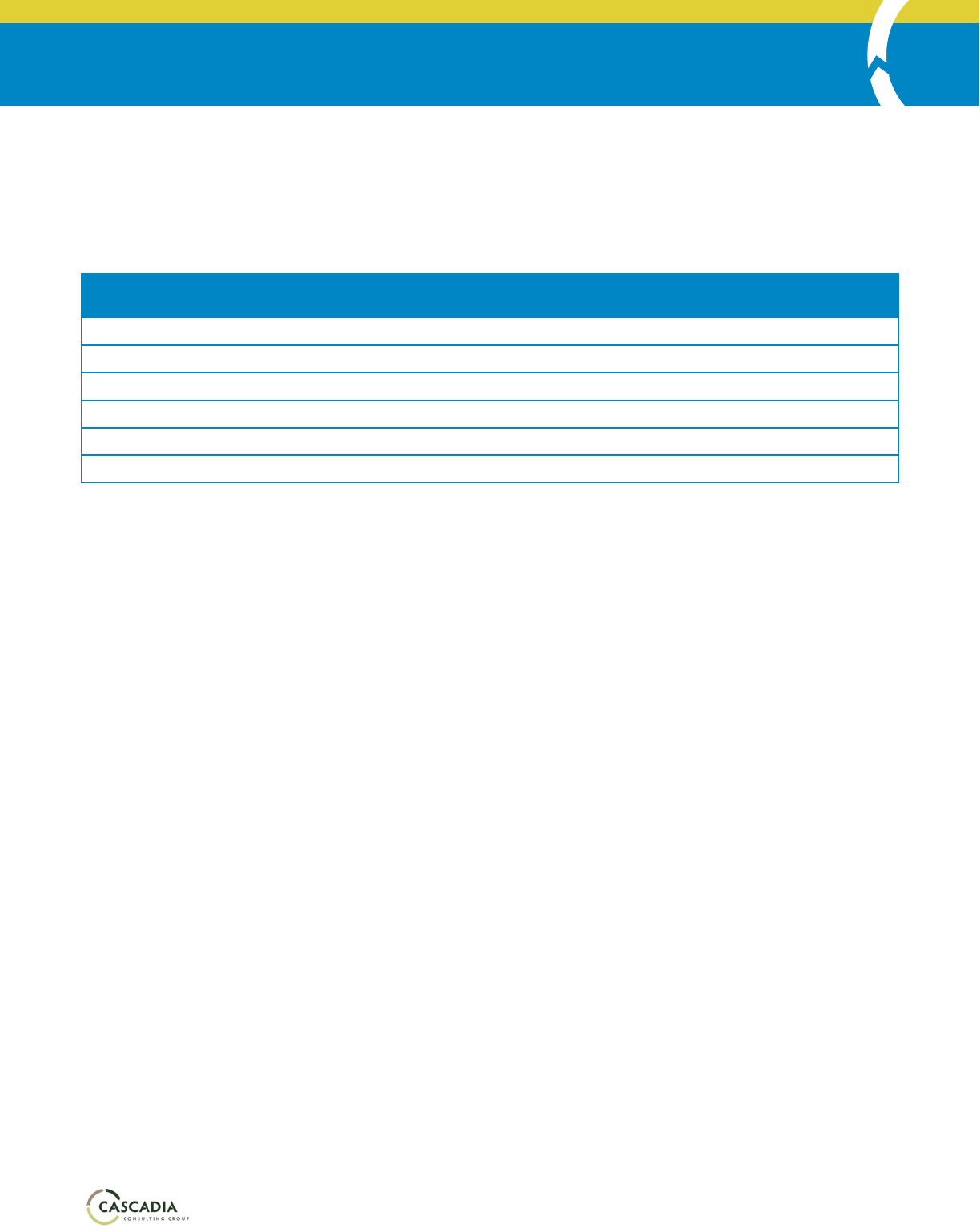
WASHINGTON STATE FOOD WASTE MANAGEMENT EVALUATION
25
Flow of Food
BetweenJuly2018andJune2019,licensedcommercialfeedcompaniesdistributed1,494,807tonsoffoodwaste
ingredientsasfeed.Thevastmajorityofthisamount(92%)wasdistillerywaste,withsmallpercentagescomposed
ofBrewery Waste, Animal Products, Human Food By‐Products, andScreenings,asshowninTable7.
Table7.CommercialFeedDistributedbyIngredientCategory
Foodwasteingredientcategory TonsdistributedJuly2018-June2019
%oftotalfoodwastetons
distributed
Brewers 7,808.37 0.5%
Distillers 1,373,465.78 92.0%
Animalproducts 10,832.68 0.7%
Humanfoodby-products 17,077.78 1.1%
Screenings 85,621.98 5.7%
Total 1,494,806.59 100.0%
AsillustratedinFigure5,themainsourceoffoodwasteforanimalfeedismanufacturing,whichcontributed
1,442,380tonsoffoodwastetocommercialfeedcompanies,or96.5percentofthetotal,in2018-2019.Outofall
foodwastecategoriesgoingtoanimalfeed,“distillers’products”makeup92
percent.Theseproductsinclude
molassesdriedsolubles,potatodriedsolubles,driedgrainswithsolubles,wetgrains,andmore.Noneofthe
ingredientswithinthiscategoryisappropriatefordonationtohungerrelief;animalfeedmaybethehighestand
bestusefortheseproducts.Inmanycases,distillersandbrewersbuild
animalfeeddestinationsintotheirbusiness
models,asdonatingsolublesandgrainby-productsorsellingthematalowcostpertonismuchcheaperthan
payingtonnagefeestosendthemtolandfillorcompost(Pope,2014).Thisisauniquefoodwast e streaminthis
regard.
KrainickDairy
acceptsapproximately1,500tonsoffoodwasteannuallytofeedits3,300cows.Foodandbeverage
manufacturers,includingbrewersandalargebakeryproductfacility ,contributeallthefoodwasteingredientsthat
KrainickDairyacceptsasfeed(Krainick,2020).
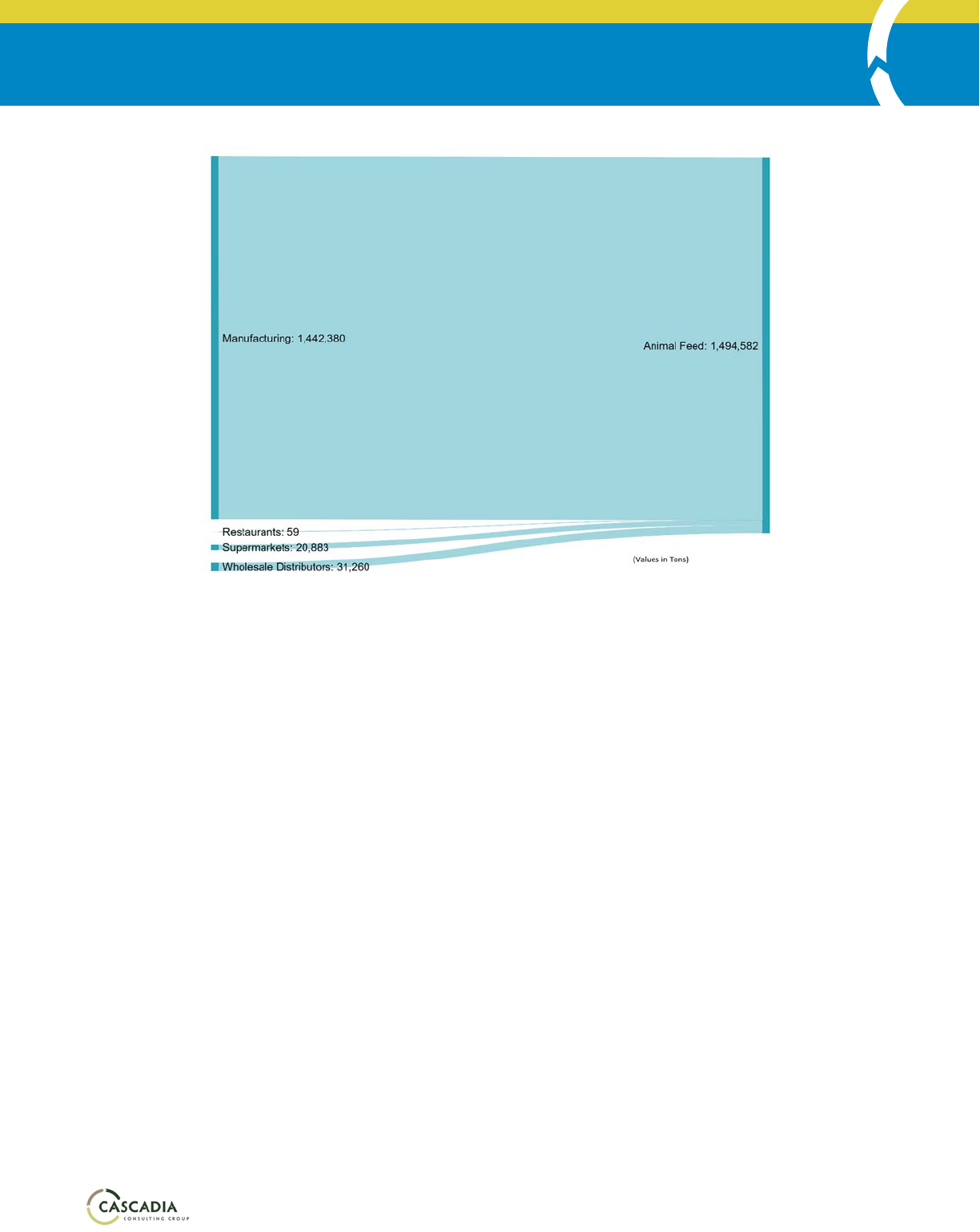
WASHINGTON STATE FOOD WASTE MANAGEMENT EVALUATION
26
Figure5.FoodWasteandWastedFoodtoAnimalFeed(tons)
Metrics and Reporting Protocols
Feedcompaniesmustbelicensedinordertomanufactureordistributecommercialf eedinWashingtonState,oract
asaguarantoronacommercialfeedlabel(WSDA,n.d.).Licenseddistributorsmustlistspecificingredientcategories
intheirapplicationsandreportonthequantitiesofthoseingredientsdistributedinfeedannually
toWSDA.The
ingredientcategoriesincludeseveralthatfallunderthisevaluation’sdefinitionoffoodwaste:Human Food By‐
Products, Distillers Products, Brewers Products, Screenings, and Animal Products(WSDA,2018).IntheHuman Food
By‐Productsingredientcategory,exampleingredientsincludeRestaurant Food Waste, Recovered Retail Food, and
Food Processing Waste.AdditionaldetailaboutthemainsourcesofHuman Food By‐Productsandtheassociated
barriersandopportunitieswouldprovide
aclearerimageoftheflowoffoodthroughanimalfeedentitiesasafood
wastemanagementpathway.Itispossibletoseetheaggregatequantityofeachingredientcategorydistributedina
givenyear,butnottoseethequantityperfeedcompany.
Petfoodcompaniesaresimilarlyrequired
toregisterpriortodistributingproductsinWashingtonState.Ifa
companydistributesonlypetfood,itisnotrequiredtoapplyforacommercialfeedlicense.Petfoodregistrants
submitsemi-annualreportsofallfeeddistributedwithinorintoWashingtonState,butregistrationsandreportsdo
notcontaininformationabout
ingredientsoringredientcategoriesused(WSDA,n.d.).
Farmsandotherrecipientsoffoodwasteforanimalfeeddonotneedlicensesorregistrationtogivethefeedto
theirownanimals,andthereisnoreportingprocess(WSDA,n.d.).Farmsarerequiredtoholdseveraldifferent
licenses,butfeed-relatedlicenses
arenotrequired(WSDA,2019).
Capacity
Challenges
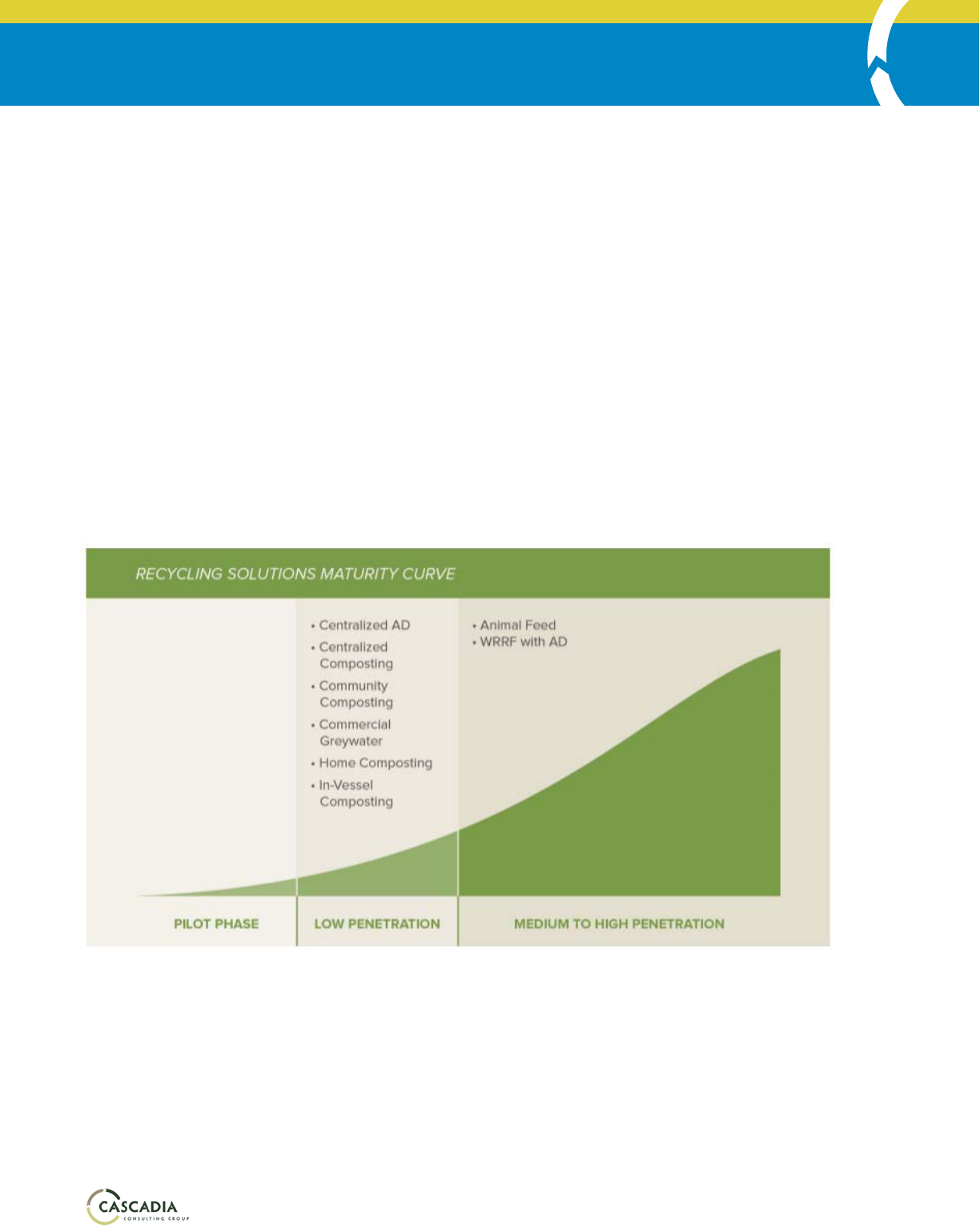
WASHINGTON STATE FOOD WASTE MANAGEMENT EVALUATION
27
Themainchallengeforexpandinganimalfeedasafoodwastemanagementpathwayisthat,accordingtotheFood
WasteReductionAlliance,thevastmajorityoffoodwasteappropriateforuseinanimalfeedisalreadybeing
recoveredandusedacrosstheUnitedStates.Acrossthecountry,anestimated95percent
ofindustrialfoodwasteis
recycled,with85percentofthisamountbeingusedasanimalfeed(FoodWasteReductionAlliance,2013).ReFED
notesthatthisisarelativelysuccessfulfoodwastemanagementpathwayduetothepredictabilityofquantityand
qualityofthewastestream(Cirilli,etal.,2016).
Figure6showsthat,comparedtootherlayersoftheorganicwaste
hierarchy,thepracticeofdivertingfoodwastetoanimalfeediswidespread.
Datausedinthisevaluationsupp ortstheideathatanimalfeedisnearcapacityasafoodwastemanagement
pathway:outofthe1,585,100tonsoffood
wastegeneratedbythemanufacturingsector,91percentgoestoanimal
feed.AnimalfeedisthelargestfoodwastemanagementpathwayinWashingtonState,processingmorefoodwaste
thanallotherdispositionscombined,includinglandfill.
AccordingtoReFED,itwillbedifficultforanimalfeeddistributorstocapturetheremaining
foodwasteavailable
becausetheequipmenttocollect,transport,dry,and treatfoodwasteintoaproductappropriateforanimalsis
expensiveandoptimalnewlocationsinproximitytolargefoodwastegeneratorsandlargeanimaloperationsmay
notexist(Cirilli,etal.,2016).
Figure6.ComparativeMaturityofAnimalFeedasFoodWasteManagementPathway
(Cirilli,etal.,2016)
Atthesametime,therearechallengesforfarms,likeKrainickDairy,thatwishtoreceivefoodwastedirectlyfortheir
ownuseasanimalfeed.ChallengesnotedinCascadia’sinterviewwithLeannKrainickinclude:
De-packaging:Manufacturingisthebestsourceoffoodwasteforanimalfeedbecauseit
doesnotrequire
de-packaging.Foodfromgrocerystorestakesalotoftimeandmoneytode-package.
Separatingmeatoutofwaste:Ruminantscannothav emeatintheirfeed.Someprocessorscannotorare
notwillingtoseparatefoodwastewithmeatfromfoodwastewithoutmeat,makingit
unavailablefordairy
feed.

WASHINGTON STATE FOOD WASTE MANAGEMENT EVALUATION
28
Logisticsatmanufacturingsites:Itcanbetrickytonegotiatewithfoodmanufacturerstofindparkingfora
trailertocollectwaste.
Regulation:Krainickwouldliketochargemanufacturersfortheserviceofcollectinganddistributingtheir
foodwastetootherfarmsbutnotesthatpayingfortonnage
andfeedlicensingareachallenge.
Highcoststobegincollection:KrainickDairyhasspentover$1millionontrailersandtruckstocollectand
transportfoodwastefromprocessors.
Opportunities
Thegrowthofmicro-breweriesanddistilleriesinWashingtonStateispromisingforfarmsthatwouldliketodirectly
collect
grainforuseasanimalfeed(Forshee,2015).Over90percentoffoodwasteusedasfeedbybothKrainick
Dairyandallfeeddistributorsisbreweryanddistilleryspentgrain.AccordingtoKrainick,itiseasiesttobegin
relationshipswithsmall-tomid-sizedbreweriesanddistilleriestocollecttheir
spentgrain.
Opportunitiesforcommercialfeedcompaniesarelessclear,giventhatthisisarelativelymaturepathwayand
commercialfeedcompanieswerenotresponsivetoourrequestsforinformation.
Recommendations for Filling Data Gaps
Ourevaluationidentifiedseveraldatagapsrelatedtofeeddistributors,astheywerenotresponsivetoourrequests
forinformation.
GapsincludethespecificingredientswithineachWSDAfoodwastefeedingredientcategory,
informationaboutthewastestreamsoffeeddistributors,andspecificchallengesandopportunitiesfacedbyfeed
distributorsotherthanKrainickDairy.Thissectionofferssomerecommendationstofillthesedatagaps.
Augment Annual Reporting of Specific Food Waste Information
Tofacilitateconsistent,ongoingtrackingof
thequantityandqualityoffoodwastebeingsenttoanimalfeedin
supportofHB1114,werecommendthatWSDAupdateitsexistingreportingprotocolstocapturetheadditional
datapointsoutlinedbelow,andforwardrelevantreportingdatatoEcology.
Feedcompanies:Thecurrentreportingprotocolisagood
startingpoint.Ifpossible,itwouldbehelpfulifthe
reportsalsocaptured:
Theamountoffoodwasteingredientsreceivedbylicenseeseachyear,inadditiontotheingredients
distributed,asthiswouldsupportmorerobuststatefoodwastegenerationestimates.
Ingredientcategoriescontaining foodwasteclearlymarked
as“foodwaste”categoriesforthepurposesof
HB1114.Thiswouldbenefitdatamanagementbymaintainingclarityaboutwhichingredientcategoriesare
inscopeforongoingmeasurementandreporting.WerecommendthatEcologyandWSDAconfirmthe
categoriesoffeedingredientsconsideredfoodwasteandconsistentlytrackrelevantmetrics
forthose
ingredientcategories.
Moredetailedinformationaboutcontentsofthehumanfoodby-productingredientcategory,i.e.,what
kindsofretailandfoodprocessingwasteareincluded.Thiswouldprovideaclearerimageoftheflowof
foodthroughanimalfeedasafoodwastemanagementpathwaybyproviding
informationaboutsources
andwhetheringredientscouldbeusedinhigherlevelsoftheEPAwaste managementhierarchy.
Whethertheweightssubmittedinreportingare“wet” or“dry.”Manyfeedingredients,especiallygrains,
gothroughadryingandpowderingprocessbeforetheyaresoldasfeed,thusremovingahigh
percentage
ofeachingredient’sweight.Inordertomatchdistributedfeednumberswithfoodwastegeneration
numbers,the“wet”weightismostrelevant(Krainick,2020;Cirilli,etal.,2016).

WASHINGTON STATE FOOD WASTE MANAGEMENT EVALUATION
29
Petfoodcompanies:Werecommendtrackingfoodwasteingredientsinpetfoodproductsbyincludingan
additionalinformationrequestontheexistingregistrationandsemi-annualreportingformsthatdefinefoodwaste
forthepurposesofHB1114.Ontheregistrationform,registrantscouldindicatewhethertheycurrentlyuseorplan
tousefoodwasteingredients,andinsemi-annualreporting,theycouldlisttheamountoffoodwasteingredients
usedinthefeeddistributedwithinthereportingtimeframe.Aswithfeedcompanyreporting,itwouldbehelpfulif
reportingeffortscapturedtheamountsoffoodwasteingredientsreceivedwithinthereporttimeframeinaddition
toamountsdistributed.
Farms:Althoughtherearecurrentlynorequiredreportingprotocolsforfarmsthatacceptfoodwasteasfeed,our
evaluationisnotrecommendingaddingthese,asthismaydiscouragefarmsfromparticipatinginthisfoodwaste
managementpathway.Krainicknotedthatsheviewsfees
andmandatoryreportingasabarrier;itisalreadyamajor
expenseforfarmstobegincollectingspentgrainusingtrailersandtrucks,andrigorousreportingwouldraise
barriershigher.Fromthelackofavailable,organizedinformation,webelievethatthisfoodwast e management
pathwayisbasedlargelyonindividualrelationships
betweenfarmsandfoodandbeverageprocessors,and
reportingprotocolscanremaininformal.
WasteData:Itisnotclearhowmuch,ifany,foodwasteingredientsreceivedbycommercialfeeddistributorsendup
incompostordisposal.Informationaboutthiswastestreamwouldhelpwithcomparingthepoundscommercial
feedcompanies
reportdistributingwithfoodwastegeneratedinWashington,sincethepoundsdistributedand
poundstowasteshouldadduptothetotalamountcommercialfeedcompaniesreceive.and petfoodcompanies
Survey Farms
Ourresearchdidnotidentifydataaboutthenumberoffarmsdirectlyreceivingfoodwasteasanimalfeed,likely
becauseindividualfarmsoftenformdirectrelationshipswithnearbyfoodwastegenerators.Werecommend
furtherresearchintohowwidesp readthispracticeisbypartneringwithstakeholdersatWSDAtosurveyanimal
farmsinWashingtonState.Understandingtheextentofdirectrelationshipsbetweengeneratorsandfarmswould
clarifyhowmuchand
whattypesoffoodwasteisflowingthroughthispathway.
Compost Facilities
Summary of Entities
InWashington,therearethreemaintypesofcompostfacilitiesthatacceptandprocessfoodwaste:commercial
compostfacilities,permittedon-sitecompostfacilities,andpermit-exemptsmall-scalecomposters.Ofthe65
permittedcompostfacilitiesinthestate,22ofthem (34%)acceptandprocessfoodwaste,includingeighton-site
facilitiesat
universitiesandcorrectionalcentersand14commercialfacilities(WAStateCompostedMaterialsfor
2018,2020).Those22facilitiesprocessed46.5percentofthetotalfoodwastefeedstocksreceivedbypermitted
compostfacilitiesinWashingtonState.
Permittedcommercialcompostfacilitiesandon-sitefacilitieshavedifferentfeedstocksourcesandproductend
uses,warranting
twodifferentsub-entitytypesforthisevaluation.
Flow of Food
In2018,permittedcompostfacilitiesprocessed187,977tonsoffoodwaste.Ofthisamount,159,574tons(85%)
camefromwithinWashingtonState.Thein-statefoodwastetonsare24percentlowerthan2017,whenpermitted
compostfacilitiesprocessedanestimated210,865tonsof
foodwaste;thisdifferenceappearstobelargelyduetoa
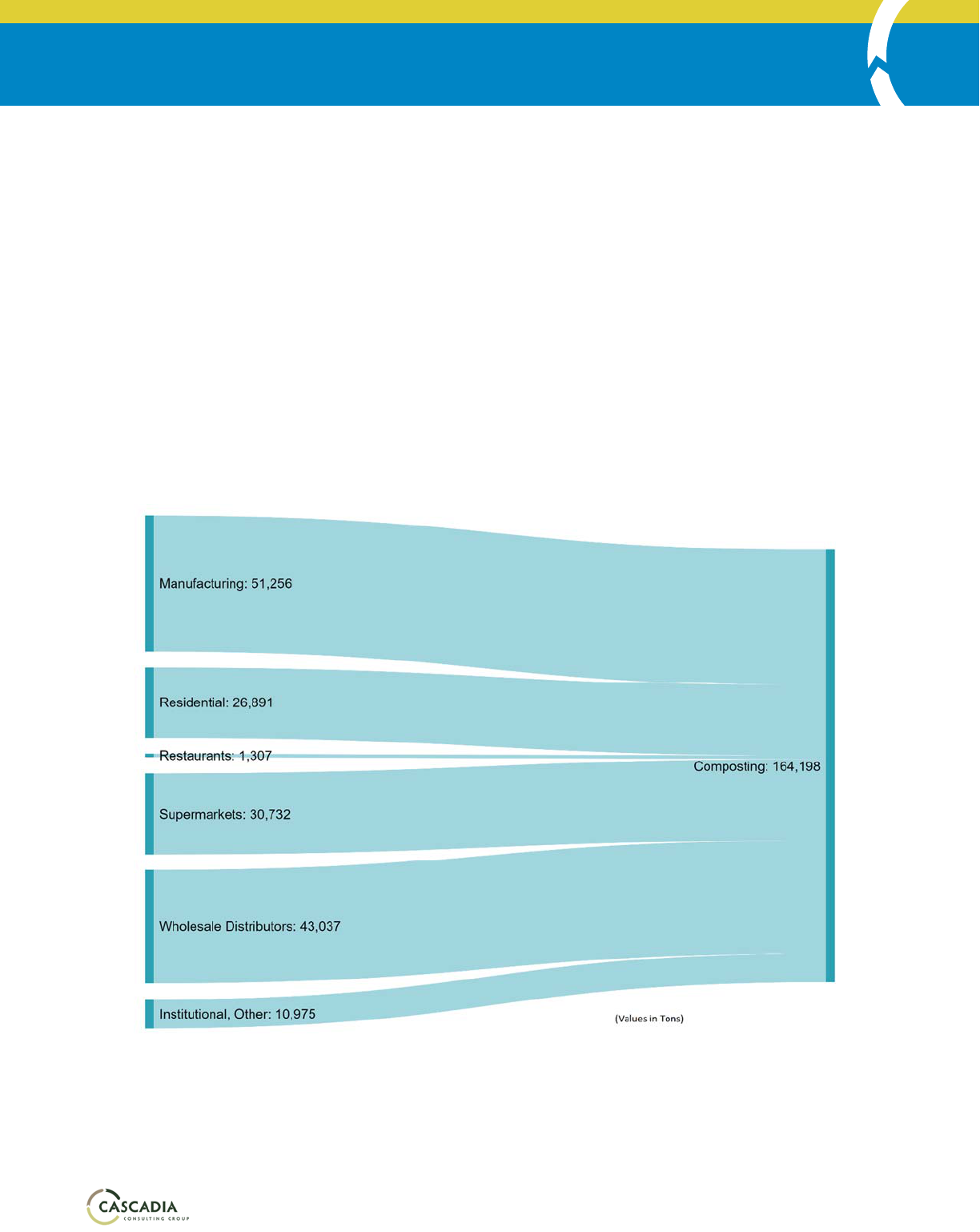
WASHINGTON STATE FOOD WASTE MANAGEMENT EVALUATION
30
decreaseinfoodwastefeedstocksattwocompostfacilities.Oneofthetwofacilities,BoiseWhitePaper,didnot
acceptanyfoodwastefeedstocksin2018;theother,CedarGroveMapleValley,droppedfrom70,566tonsoffood
wastefeedstocksin2017 to49,609tonsin2018.Thedatainformingour
modelshowsthatthecombinedamount
offoodwastegoingtolandfillandcontrolledcombustionissixtimesgreaterthantheamountoffoodwastegoing
tocompost.
ThethreefeedstockcategoriesthatpermittedfacilitiesmustuseforreportingtoEcologyareFood Processing Waste
(frommanufacturers),Post‐consumer Waste(fromthekitchens
includedinConsumer‐facing Businessesforthis
evaluation,whichalsoincludescorrectionalcenters),Yard Debris/Food Waste(fromresidentialcurbsidecollection
programs).SurveysandWSDAestimateshavenotedthattheYard Debris/Food Wastecategoryisconsistently90
percentyardwasteand10percentfoodwastebyweight.Ourevaluationandmodelapplythisassumption
accordingly.
Figure7
showstheproportionoffoodwastefeedstocksthatcamefromeachsourcetocompostfacilitiesin2018.
Mostfoodwastefeedstockscamefromconsumer-facingbusinesses(52.4%),followedbymanufacturers(31.2%)
andresidences(16.4%).
Figure7.FoodWasteandWastedFoodtoCompostinWashingtonState(tons)
AccordingtotheeightfacilitiesthatrespondedtoCascadiasurveys,themainoutputsofcompostingarecompost
andmulch.
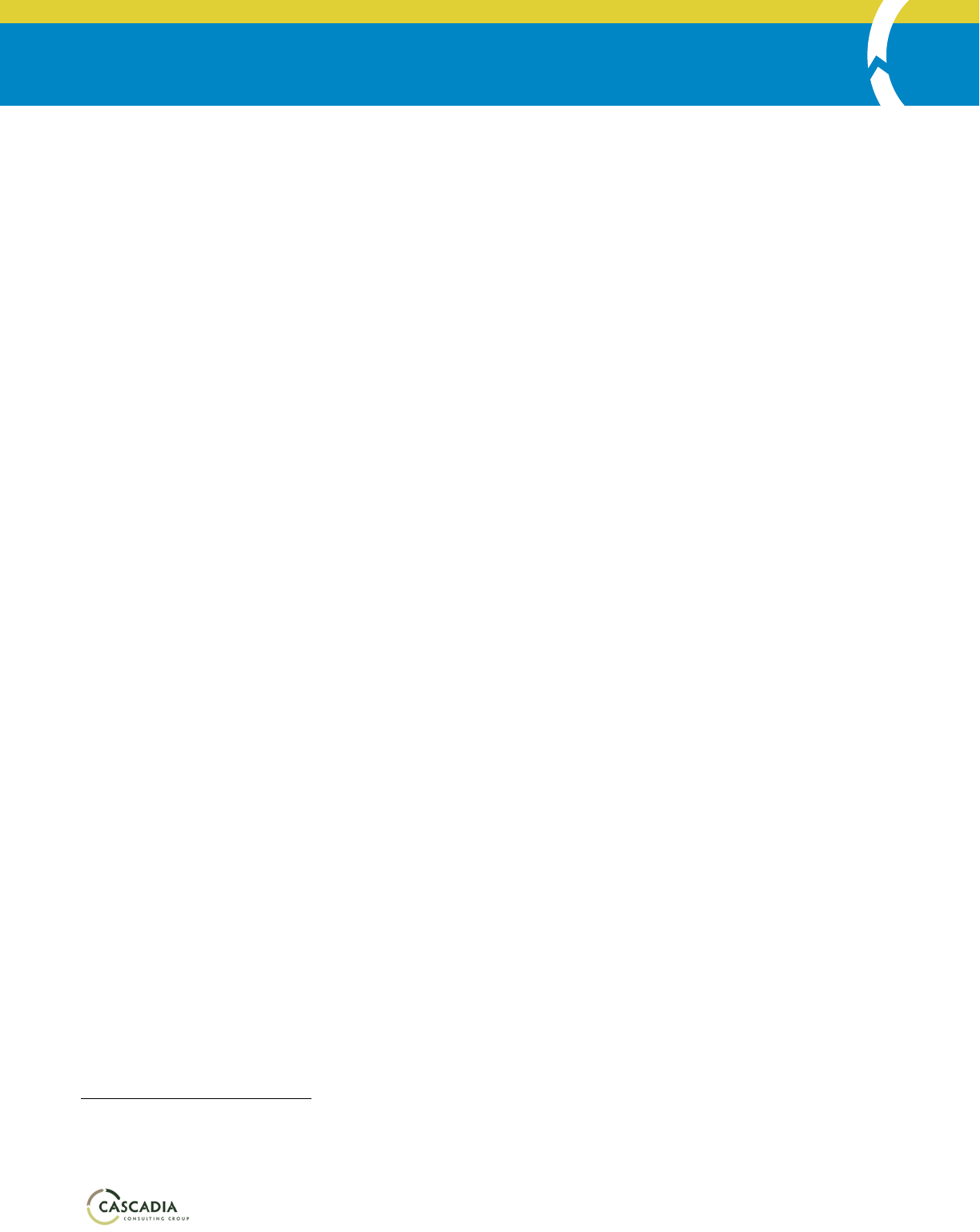
WASHINGTON STATE FOOD WASTE MANAGEMENT EVALUATION
31
Metrics and Reporting Protocols
Compostfacilitiesacceptingfoodwasteasafeedstockarerequiredtohavesolidwastepermitsiftheyhave“greater
than25butnomorethan250cubicyardsofmaterialon-siteatanyonetime,nottoexceed1,000cubicyardsina
calendaryear”(WashingtonStateLegislature,2018).
Each
permittedfacilityreportsthequantityoffeedstockstheyreceiveannuallybycategoryoffeedstock,including
foodwastecategories:Food Processing Waste, Post‐consumer Food Waste,Yard Debris/Food Waste,and,
sometimes,Other Food Waste(WADepartmentofEcology,2019)(WADepartmentofEcology,2020).
Accordingtosur veyresponses,facilitiesmayalsotrack(butdonotreport):contaminationlevels,moisturelevels,
anddirtcontent.Theydidnotinformusaboutcontaminationlevelsoffoodwastefeedstocks.
Capacity
Sevenoutofeightcompostersurveyrespondentsindicatedthattheirfacilitiesarecurrentlyoperatingbelow
capacityandcouldprocessmorefoodwastethantheydonow.
Amongthefivepermittedfacilitiesthatprovided
theirpermittedcapacities,acomparisonwithEcology’s2018reportshowsthatthereisacombined164,184tonsof
excesscapacityavailable(WADepartmentofEcology,2020).
1
Althoughthereiscapacityamongsomecomposters
toacceptmorefoodwaste,projectionsindicatethatitwillfillupquickly,andactualavailablecapacitycanbe
dynamic.
Thedynamicsbehindpermittedcapacityandrealavailablecapacity arecomplicated.Evenifthereiscapacity
availableonpaper,theremaystillbe
challengestoacceptingfoodwasteoranyadditionalfeedstocks.First,amounts
ofmaterialenteringcompostfacilitiesarevariableacrossseasons:someseasonsmayfindfacilitieswithequipment
andstafftospare,whileothersmayhavethemoperatingatmaximumcapacity.Inaddition,factorssuch astraffic
limitations,companyaffiliations,feedstockquantities,
andmorecanaffectdailyandseasonalrealavailablecapacity
(CalRecycle,2019).
Capacitytoreceivefoodwasteasafeedstockcomeswithspecificissuesandrequirementsforcomposters.A
statewidesurveyofcompostersinCaliforniaindicatedthatveryfewfacilitiesprocessfoodwasteasmorethan30
percentoftheir
feedstocks,thoughthecurbsideorganicscollectionprograminCaliforniaisoneofthemostmature
inthecountry.DespiteupcomingstatewidemandatesforfoodwastediversionaspartofSB1383,themajority(66
percent)ofcomposterssurveyedsaidtheydidnothaveanyinterestorrealcapacitytoincreasethe
proportionof
foodscrapsreceived.Theycitedmultipleconcernsassociatedwithincreasingtheamountoffoodwastereceivedat
theirfacilities,includingodors,contamination,theneedtoamendexistingpermits,theneedtoupgradeprocessing
technology,andmore(CalRecycle,2019;Waste2Resources,2016).
Despitethis,thesupplyoffood
wastefeedstockswillgrowasstreamscontinuetoshiftfromlandfilltocompost,
makingadditionalpermittedcapacityatcompostfacilitiescriticalinthecomingyears.Accordingtoa2019
projection,organicsgenerationforth eregionincludingKingandSnohomishCountiesisprojectedtoincrease29
percentfrom2019levelsby2030
and36percentby2040,basedsolelyoncurrentper-persongenerationof
organicsandavailablepopulationgrowthprojections.Thisprojectiondoesnotassumeanyfuturechangesin
organicsdiversionbehavior, suchasincreaseddiversionoforganicsfromdisposaltocomposting(Cascadia
ConsultingGroup,2019).Figure8illustratesprojectedorganicsgeneration
increasesagainstcurrentannual
1
Tworespondentslistedtheirpermittedcapacityincubicyards;weconvertedtheirestimatestotonsbyassuming
thatonecubicyardofcompostis1,000poundsonaverage(Biernbaum).
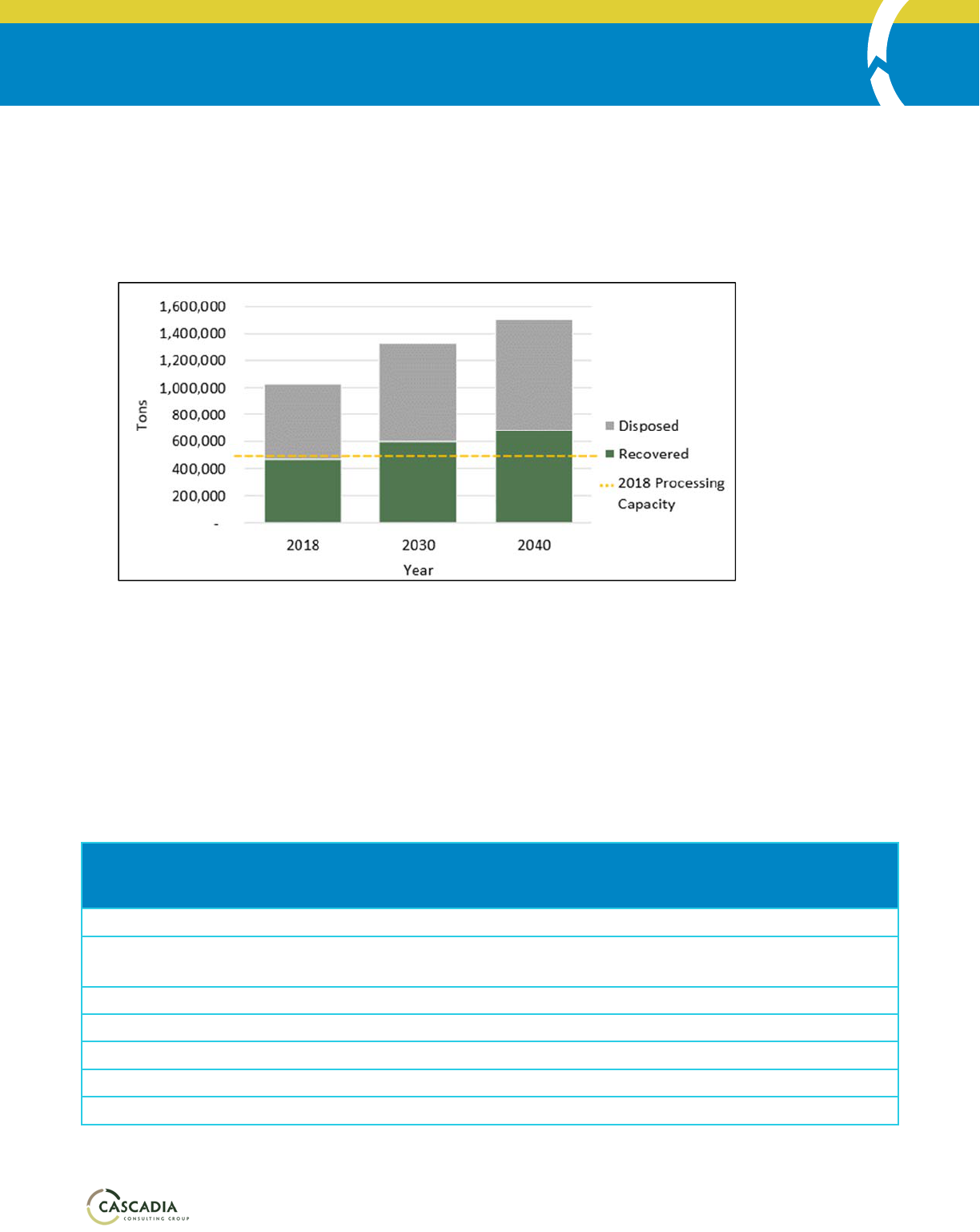
WASHINGTON STATE FOOD WASTE MANAGEMENT EVALUATION
32
permittedcapacityatthethreecompostersthatacceptmaterialfromKingCountyandthesu rroundingregion:
CedarGrove(Everett),CedarGrove(MapleValley),andLenz Enterprises.Accordingtotheseprojections,2018
permittedcapacitywillbeexceededby2030andfurthercapacitywillbenecessarytocapturerecoveredorganics.If
diversionrates
fromlandfilltocompostincreaseasexpected,theneedforadditionalcapacitywillbeevengreater
(CascadiaConsultingGroup,2019).
Figure8.Regionaldisposalandrecoveryprojectionsthrough2040inKingCounty,Seattle,andSnohomishCounty
(CascadiaConsultingGroup,2019)
Challenges
Amajorstatewidesurveyofrespondentsinrolesthroughouttheorganicsmanagementindustrynotedthreemain
challengestoexpandingcomposting:eliminatingcontamination,overcomingreluctancebyresidentstohavingnew
facilitiesneartheirhomes,andcontrollingodorsandairpollution(Waste2Resources,2016).Surveyresponses
collectedforthisevaluationechoed
thesechallenges,aslistedinTable8.Theseresponsessupportseveralknown
challengesforcompostfacilitiesthatanticipatereceivinganincreasedamountoffoodwaste,describedinthe
sectionsbelow.
Table8.ChallengesNotedbyComposterSurveyRespondents
SpecificChallenge
Commercial
Composters
(outof5respondents)
On-siteComposters
(outof3
respondents)
Total
Worriedaboutodor 3 1 4
Solidwastepermittingtoocostlytoobtainor
difficulttogetapprovalforfacilityimprovements
3 0 3
Contaminatedfeedstocks 3 0 3
Gettingloansfornewequipmentisdifficult 2 1 3
Needtoexpandmarkets 2 0 2
Acquiringfeedstocksischallenging 1 1 2
Spaceislimited 1 1 2
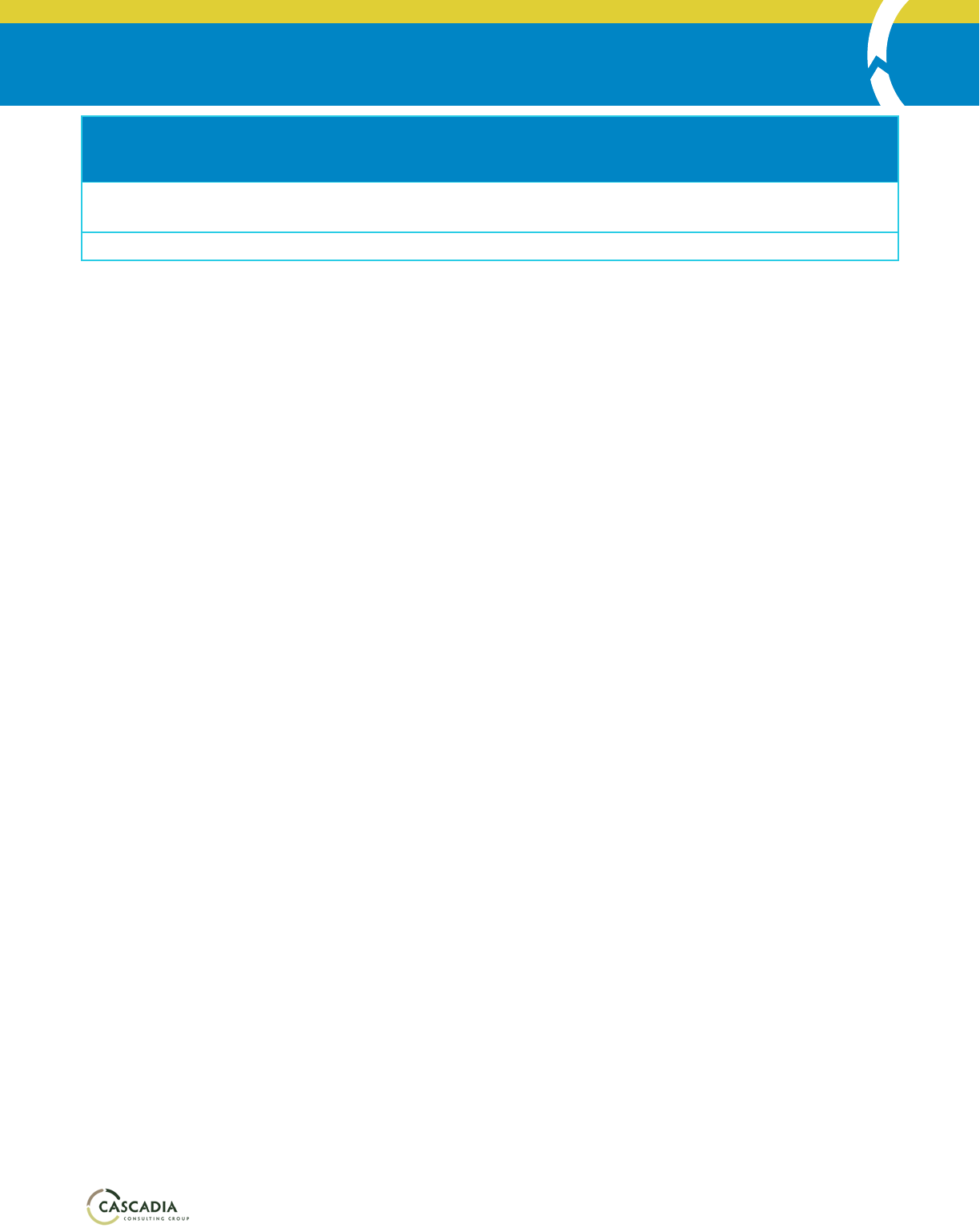
WASHINGTON STATE FOOD WASTE MANAGEMENT EVALUATION
33
SpecificChallenge
Commercial
Composters
(outof5respondents)
On-siteComposters
(outof3
respondents)
Total
Theavailabilityofcheapmulchmakesitharderto
sellcompost
0 1 1
Needfordifferenttypeoffeedstock 0 1 1
Permitting and Approval
Expandingcompostingprocessingcapacityischallengingforreasonsthatincludelanduserestrictionsforpotential
neworexpandedsites,thecostofland,concernsfromneighboringresidentsaboutodorsfromacompostfacility,
andwhatcouldbealengthytimeframetocompletepermitting(CascadiaConsultingGroup,2019).Three
composter
surveyrespondentsindicatedthatpermittingandapprovalsarebarrierstoexpansion.
Contamination
Threecommercialcomposters—60percentofcommercialsurveyrespondents—indicatedthatcontaminationisa
challengeforprocessingandsellingmorecompost.Contaminationreferstoitemsthatarenotcompostableand
shouldgotoadifferentwastestream.
Contaminationisapersistent
issueforcomposters.OfthematerialcollectedfororganicsprocessinginKingCounty
in2018,3.9percentbyweightwascontamination(CascadiaConsultingGroup,2019).Thiscontaminationincluded
non-compostableplastic,glass,andnon-compostablepapers,suchasaseptican dpolycoatedpapers.
While3.9percentisalowamountbyweight,it
isnoticeablevisuallyinfinishedcompostandimpactscustomer
perceptionsandavailablemarkets(CascadiaConsultingGroup,2019).TheWashingtonStateDepartmentof
Transportation(WSDOT),amajorcompostbuyerinWashington,hasvariabledemandforcompostbasedonthe
numberofroadprojectsinthestate,butsince2015,itsdemandhas
substantiallydecreasedandshiftedtofiner
composttominimizecontamination,sincecompostcontaminationonroadwayscanbeconsideredlitter(Maurer,
2020;Batjiaka,2016).
Increasedrecoveryoffoodwasteforcompostislinkedwithhigherlevelsofcontaminationincompost,asresidents
andcommercialbusinesses mischaracterizefoodwasteandincludecontaminants
withtheirscraps.Thirtyeight
percentoffacilitiessurveyedbyCalRecyclein2019indicatedthattheirmainstrategytominimizecontaminationis
avoidingacceptingfoodscraps(CalRecycle,2019).CompostfacilitiesintheBayArea,California,wherecurbside
compostcollectionismorewidespreadthaninotherpartsofthestate,facehigher
contaminationratesthanother
facilities.Becauseofthis,finishedcompostandmulchmakeupasmallerpercentageofoutputsfromcompost
facilitiesintheBayAreathanfromcompostfacilitiesinotherpartsofthestate.Approximately41percentof
productsfromfacilitiesintheBayAreaarenotcompost
ormulch,butratherbecomeAlternativeDailyCover(ADC)
atregionallandfills(CalRecycle,2019;CascadiaConsultingGroup,2019).Washingtoncompostersurvey
respondentsforthisevaluationreportedthathighpercentagesoftheirmainproductsarefinishedcompostand
mulch,butascompostcollectionexpandsandmorefoodwasteisrecoveredfromthe
landfillstream,
contaminationislikelytoremainanissu e.
Therearesomeavailablesolutionsforremovingcontamination,buttherearealsobarrierstoadoptingthem.Inthe
CalRecyclesurvey,50percentofrespondentsreportedusingscreensorotherequipmenttoremovecontamination,
and32percentreportedusingapickingline.
InKingCounty,composterscitedcostsandhesitancytoinvestin
unproventechnologiesascurrentbarrierstothesesolutions,andCascadiadidnotobtaindataontheeffectiveness

WASHINGTON STATE FOOD WASTE MANAGEMENT EVALUATION
34
orcostofthesesystems(CascadiaConsultingGroup,2019).Educatingresidentialandcommercialcustomersabout
whatitemscanandcannotbeplacedincurbsideorganicswillbecrucialtominimizingcontaminationupstream.At
thesametime,educationcanreassurebuyersofcompostthatverysmallam ountsofinertcontaminationare
expected,
allowedwithinspecifications,andnotdetrimental,therebyre-shapingbuyers’expectations(Cascadia
ConsultingGroup,2019).
Markets
MostofWashington’ scompostisproducedinthe westernpartofthestate,whichpresentschallengesformarkets
ineasternWashington.Thetoptenfacilities,whicharemainlyinwesternWashington,produce80percentof
finished
compost(Waste2Resources,2016;WADepartmentofEcology,2020).Agriculturalmarketsandpublic
projectsineasternWashingtoncouldabsorbmorecompost—agricultureonlymakesupfivepercentofthedemand
forcompostinWashingtonState—butthehighcostsoftransportingcompostfromwesterntoeasternWashington
andthedifficultyof
marketinginnon-localareasmaybeprohibitive.RepresentativesfromWSDOThavereported
thatcompostcancostuptotwotothreetimesmoreineasternWashingtonthanwesternWashington(Cascadia
ConsultingGroup,2019).Moreresearchintothisareaisneededtodeterminewhetherserv ingthismarketis
economicallyfeasible.
Anadditional
barriertotransportingcompostfromwesttoeastistheapplemaggot,aproblematiccontaminantin
westernWashingtongreenwaste.WSDArequiresspecialpermitsfororganizationswishingtotransportgreenwaste
andmunicipalsolidwasteoutofapplemaggotquarantineareasinwesternWashington.Thoseorganizationsmust
grindandheat
treatthegreenwasteandcleantrailersextensively.Permitsarealsorequiredforfacilitiesoutsideof
quarantineareaswishingtoreceivegreenwastefromapplemaggotquarantineareas.WhentheCityof
LeavenworthincentralWashington(attheeasternedgeoftheapplemaggotquarantinearea)founditselfnewly
insidethe
applemaggotquarantinearea,itfacedtheoptionofanarduousprocesstofigureouthowtotreatgreen
wasteandtransportittoapermittedeasternWashingtonfacilityorpayawesternWashingtoncompostfacility .The
citypreviouslypaid$8,000-12,000peryeartobringwastetoan easternWashington
facilitybutitsquotefor
compostinginwesternWashingtonaddedupto$85,000(WSDAW.D.,2018).
Odors and NIMBYism
AWashingtonsurveyofnearly300organicsmanagementprofessionalsfoundthattheothertwomostfrequently
citedbarrierstoorganicsmanagementwereNIMBYism(neighboropposition,sometimesreferredtobythis
acronymwhichstands
for“notinmybackyard”)andodors(Waste2Resources,2016).Threecompostersurvey
respondentsinourevaluationlistedodorsasaconcern.NIMBYismrelatedtocompostfacilitiesismostfrequently
associatedwithodors,ratherthananyotherrisks,sothesetwoissuesaremostappropriatelycombined(Waste2
Resources,
2016).
Concernsaboutodortendtoberelatedtocompostfacilitysizeandtheextenttowhichitmanagesfoodscrapsand
otherwetorganicmaterials.Someresearchersnotethatodorissueshave“grownmoreproblematicascompost
facilities,particularlythoseinmunicipalzones,arepushedtowardsthehigherflow
ratescontainingthemore
putrescentorganicmaterials(i.e.,foodscrapsandlawnclippings)thatresultfromincreaseddiversionprograms”
(Ma,Wilson,Zhao,Yorgey,&Frear,2013).
Opportunities
OurresearchshowsthattheamountoffoodwasteenteringcompostingfacilitiesinWashingtonStateisstill
dwarfedbytheamountenteringlandfillsand
waste-to-energy;thereissixtimesmorefoodwasteenteringlandfill
andwaste-to-energyfrommixedmunicipalsolidwastestreamsthanthereisbeingcomposted.Thissection

WASHINGTON STATE FOOD WASTE MANAGEMENT EVALUATION
35
describessomeofthegreatestareasofopportunityforincreasingtheamountoffoodwastebeingcompostedin
Washington.
Restaurants and Institutional Kitchens as Feedstock Source
Ouranalysisshowsthat,byfar,mostfoodwastefromresidentialcurbsidecollection,restaurants,andinstitutional
kitchensgoestolandfill.As afirststeptocapturemorefoodwastefromthese
streamswhileminimizing
contamination,werecommendresearchintocollectionprogramsforback-of-housecommercialstreamsthatcould
betterrecoverfoodwastefromrestaurantsandinstitutionalkitchens.Back-of-housewastetendstohavelower
levelsofcontaminationthanfront-of-housewasteandresidentialwaste,andsincecompostfacilitiesarewaryofthe
contaminationassociatedwith
collectingfoodwasteingeneral,thiscouldbeagoodplacetostart.Thiswaste
streamwouldbeappropriateforeithercompostorhigh-solidsanaerobicdigestion;sinceourresearchhasindicated
thatWashingtondoesnothaveplanstobuildahigh-solidsdigester,compostisthemostviableoptiontocapture
thiscurbsidewaste(Maurer,2020).
Integration of Anaerobic Digestion
Whenanaerobicdigestionandcompostarecombined,somesynergiesarecreatedthatimprovetheperformance
ofboth.Someoftheoutputsfromdigestionbecomeinputstothecompostingprocess,andviceversa,leadingtoa
processthatefficientlymanagesdifferenttypesoffeedstock,digestereffluent,
andbiogaswithminimalincreasein
facilityfootprint.Thistypeofsystemcouldmitigateodorsandcreatemorevaluableproducts,suchasrenewable
naturalgas,bioplastics,orflavorants,thanacompostfacilityalone(Waste2Resources,2016).
Therearesuccessfulcasestudiesofthisconcept,suchasJCBiomethaneinEugene,
Oregon,whichprocesses6,000
tonsoffoodprocessingwasteperyear,12,000tonsofcommercialfoodwasteperyear,andsmall amountsof
manure.ThefacilityusesawindrowcompostsystemandawetEntecdigestionsystem(BioCycle,2014).
Oneofthecompostersurveyrespondentsreportedthattheyuseanaerobic
digestionon-site,notingthat
negotiatedpermitconditions“madecompliancepossible.”Otherrespondentscommentedthatbarriersto
implementinganaerobicdigestionattheirfacilitiesincludeinsufficientfeedstockvolume,variablefeedstock
amountsandtypes,anticipatedodors,andthehighcostofinvestment.
Agricultural Markets
Agriculturalapplicationsrepresentasmallportionofcurrentcompostmarketsbut
havehighpotentialforgrowth.
Inthe2015KingCountyRecyclingMarketAssessment,sur veyedprocessorsstatedthatagriculturedemandfor
compostrangedfromfivetotenpercentoftheircompostsales.Residentialdemandreportedlyrangedfrom15to
50percentandtheremainderisusedbygovernmentagenciesorlandscapers(Cascadia
ConsultingGroup,2015).
TheCompostOutreachProject—aninitiativebytheWSUCooperativeExtensioninSnohomishCounty—has
collaboratedwithlocalcompostproducers,countyofficesandlocalconservationdistrictssince2011topromote
andevaluatetheuseofcommercialfoodscrapsandyardtrimmingsascompostonfarmsinSnohomishand
northern
KingCountythroughcompostusetrials;todate,thesetrialshavedemonstratedpositiveeffects.Areport
publishedontheprojectfoundthatagriculturalmarketsmadeuplessthanfivepercentofthetotalcompostmarket
inWashingtonState(Collins,Harness,&Bary,2016).Thereislikelytheopportunitytoexpandthisapproach,
particularlyforcompostapplicationinagriculturalareasincentralandeasternWashington,thoughmoreresearch
intotheeconomicsoftransportingcompostfromfacilitiesinwesternWashingtontotheseareasisneeded(Brown,
2019).AsurveyoffarmersinCaliforniafoundthatbarrierstoincreasedcompostuseinclude:costsof
compost
(includingtransportation);alackofunderstandingforhowcompostaffectsnutrientmanagementplans;andneed
forbetterenforcementaroundpathogenandweedmanagementinfinishedproduct(BioCycle,2018).

WASHINGTON STATE FOOD WASTE MANAGEMENT EVALUATION
36
Municipal Purchasing Programs
Thereareopportunitiestoincludecompostinmoremunicipalprojects,whichwouldprovidevaluablemarketsand
demonstratelocalleadership.Thereisinterestfromcompostfacilityrepresentativesinseeinglocalgovernments
leadintheuseoflocallyproducedcompostfromlocallygeneratedorganicwaste(CascadiaConsultingGroup,
2019).Twocompostersurvey
respondentsforthisevaluationindicatedthatmunicipalbuy-backofcompost
productswouldbenefittheircompostfacilities.Agencycontractsandprocurementpoliciescanstatespecifications
andpreferencesforlocallyproducedcompost(CascadiaCons ultingGroup,2019).
Publicprojectswiththepotentialforincreasedcompostuseincludegreeninfrastructureinstallationsandother
stormwater
managementanderosioncontr olprojects,habitatandsiterehabilitation,parklandscaping,andturf
andtreemaintenance(CascadiaConsultingGroup,2019;Waste2Resources,2016).
Carbon Sequestration and Other Environmental Benefits
Thereisagrowingbodyofresearchaboutthevalueofcomposttostorecarboninsoilintheformoforganicmatter,
tothebenefit
ofclimateactionandsoilhealth.Astheabilitytomapsoilandaccountforsoilcarboncontinuesto
systematize,itwillbecomeeasierforfarmers,ranchers,andopenspacestewardstojustifycompostapplicationin
certainamounts.Itisalsolikelytobecomemorecommonasabestpracticefor
stateandlocalgovernmentstoadd
compostapplicationintoclimateactionplanningandlandstewardshipplans,andforthecarbonoffsetsgainedin
compostapplicationeffortstobeindependentlyverifiedandtradedincarbonmarkets(Waste2Resources,2016).
TheMarinCarbonProjectinCaliforniahasalreadydevelopedacarbon
accountingprotocolforcompostuseon
grazedgrasslandsforcarbonsequestration,enablingrancherstohavetheirpracticesverifiedandgeneratecarbon
offsets(CascadiaConsultingGroup,2019).
Inadditiontocarbonsequestration,compostapplicationcanbenefitsoilbiodiversity,waterquality,nutrient
availability,pestmitigation,andresiliencetofireanddrought.Thesequalities
havebeenrecognizedandtracked
extensively,includingbyEcology(Waste2Resources,2016;U.S.PIRGandFrontierGroup,2019).KingCounty
alreadyusesthelensofclimatechangeasawaytoshowthebenefitsofusingLoop®b iosolids,estimatingthattheir
useoffsetsthemajorityofthegreenhousegas
emissionsfromtheWastewaterTreatmentDivision’soperations
(CascadiaConsultingGroup,2019).Continuingtocommunicateandquantifythesebenefitswillindirectlyexpand
marketsanduseofcompostinarangeofsettings.
Small-Scale and Community-Scale Compost
Small-scaleandcommunity-scalecompostsystemsprovidetheopportunitytomanagefoodwasteandother
residualsclosertothesource,
reducinggreenhousegasemissionsfromtransportationandprocessing,creating
opportunitiesforeducation,andeliminatingsomecosts.A2018reportbytheInstituteforLocalSelf-Reliancefound
thatnationally,forevery10,000householdscompostingathome,between1,400and5,000tonsperyearcouldbe
divertedfromcurbsidecollection,withpotentialsavings
inavoideddisposal costsalonerangingfrom$72,000to
$250,000(Platt&Fagundes,2018).Theymaybeespeciallywell-suitedfordemonstrationareasatschoolsandin
otherpublicspaces,whereeducationcanconnecttheproductsofcompostbacktotheirsource(U.S.PIRGand
FrontierGroup,2019).Campuscompostingprograms
canbeeff ectiveformsofenvironmentaleducationinschools
(AmericanSocietyforHorticulturalScience,2016).
Whilethebenefitsofsmall-andcommunity-scalecompostsystemshavebeendocumented,thereislittledata
aboutthequantityoforganicstheycurrentlymanageandtheextentoftheirgrowthpotentialisuncertain(Cascadia
ConsultingGroup,
2019).

WASHINGTON STATE FOOD WASTE MANAGEMENT EVALUATION
37
Recommendations for Filling Data Gaps
Conduct Barriers and Opportunities Study About Compost Program Participation
Amajordatagapisunderstandingthebarriersandopportunitiestoincreasingcompostingrates,especiallyamong
residential,restaurant,andinstitutionalgenerators.Limitedcapacityatcompostfacilitiesinthestateisoneknown
barrier,butadditionalfactorsincludethelackofcurbsidecollectionprogramsandlowparticipationratesamong
programs
thatexist.Curbsidecartstudiesandgeneratorstudiesaretoolsthatcouldbeusedtobetterunderstand
householdandcommercialsite-levelparticipationandrecoveryopportunities.Bothofthesety pesofstudieshave
beenusedinKing County–generatorstudiesin2017and2019,andacurbsidestudyin2018–
tobetter
understandregionalandsite-specifictrends(KingCountySolidWasteDivision,n.d.).Greaterinsightsinto
participationlevelsinorganicscollectionprogramswouldinformnextstepsrelatedtoincentivesand/ormandates
forcurbsideprogramsandeducationalinitiativesamongcompostcustomers.
Conduct Composter Feedstock Characterization Studies
Betterknowledgeofthecontentsofmaterialcollected,especiallyfrom
residentialandcustomer-facingbusinesses,
wouldbeusefultotracklevelsofcontaminationandthesuccessoffoodwastediversionprograms.Composter
surveyresponsesdidnotcontaininformationaboutquantitiesoffoodorcontaminationlevels.ThisInformationis
notreadilyavailabletocompostingfacilities,whiletheywilltypicallyhaveananecdotal
estimate.Amore
quantitativeapproach,suchasformalwastecharacterizationstudiestoquantifymaterialsenteringcompost
facilities,wouldprovidemorereliableinformationsourcesofcontaminationandquantitiesoffoodwaste.
Support Small- and Community-Scale Compost Systems
SomecitiesinwesternWashington,likeSeattle,haveimplementedprogramstogiveawayfreeordiscountedhome
compostbins,but
havesincestoppedthoseprogramsordiscontinuedtrackingthebins(Platt&Fagundes,2018).It
isimportanttonotethatsmall-scaleandcommunity-scalearevaluablefoodwasterecoverypathwaysandshould
stillbesupported.
Establish and Maintain Consistent Feedstock Reporting Categories
Werecommendmaintainingconsistentfeedstockcategoriesacrossreportingyearsandprovidingcleardefinitions
offeedstockcategories
toensurethatthereportingprocessisasclearaspossibleforcompostfacilities.Acategory
calledOther Food Waste wasincludedinreportingfrom2014-2017.AmountsoffeedstockreportedasOther Food
Waste grewsteadilyfrom2014-2017(WADepartmentofEcology,n.d.).In2018,whentheOther Food Waste
categorywasremoved,feedstocksreportedasPost‐consumer Food Waste
rosebyafactorof70,from906tonsto
63,492.47(WADepartmentofEcology,2020;WADepartmentofEcology,2019).Thesurveyresultscollectedduring
thisevaluationindicatethatmuchofthefoodwasteprocessedbycompostfacilitiesiscorrectlycategorizedasPost‐
consumer Food Waste.Theshiftinthefoodwaste
feedstockcategoriesusedinreportingindicatesthattheremay
beconfusionabouthowtoreportdifferentcategories,andthatsomesourcesoffoodwastemayprovidemorethan
onecategoryoffoodwaste.Werecommendreviewingthecategoriesprovidedandaddingcleardefinitionsofeach
forfacilitiestoreference.

WASHINGTON STATE FOOD WASTE MANAGEMENT EVALUATION
38
Industrial Uses
Summary of Entities
Industrialuses,forth epurposeofthisevaluation,referstoanaerobicdigestion.Othertypesofindustrialusesfor
foodwasteincludemanagementpathwaysforfats,oils,andgrease,suchasrenderingandbiodiesel.However,
theseareoutofscopeforthisevaluationbecausemanagementpathwaysforthemarewell-establishedand
specific,andthereisextremelylimitedopportunityforthemtoberecoveredforahigheruseintheEPAfoodwaste
hierarchy(U.S.EPA,n.d.).
TherearethreemaintypesofanaerobicdigestersinWashingtonState:on-farmdigesters,waterresourcerecovery
facility(WRRF)digesters,andsmaller,on-sitedigesters.On-farmdigestersand
small,on-sitedigestersarewithinthe
scopeofthisevaluation;WRRFdigestersarenotinscopeforquantificationpurposesbutwillbediscussedinthe
Opportunitiessection.
Therearefiveactiveon-farmanaerobicdigestersinWashingtonStatethatprocessfoodwasteoutofninetotal
dairydigesters.Onlytwoof
theseareoperatingasofthewritingofthisreport;theotherthreeareundergoing
facilityrepairs(Maurer,2020).Mostoftheon-farmdigesterswerebuiltin2012and2013andhavedonemostof
theanaerobicdigestioninWashingtonsincethen.Themajorityuseahybridplug-flowcompletemixdigester
system,whileoneusesacompletemixdigestersystem(DairyNutrientManagementProgram,WSDA,2011).Eight
dairiesinWashingtonusetheirbiogastoproducerenewableelectricity (WADepartmentofCommerceandWSU
EnergyProgram,2018).
Therearealsofoursmall-scale,on-siteanaerobicdigestersoperatedbyImpactBioenergyatabrewery,
cideryand
farm,commercialkitchen,andtofuproducer,respectively.Thesearepermit-exemptdigestersbuilttoprocess
materialsgeneratedateachsite.Theyarerelativelynew—thefirstwasbuiltin2016—andinthecomingyearsmay
providelessonsaroundfeasibilityandconsiderationsforreplicabilityofcommunity-scaledecentralizedanaerobic
digestionprojectsinWashington.
Therearecurrentlynohigh-solidsanaerobicdigestersinWashingtonStateandtherearenoplanstobuildone
(Maurer,2020).
Flow of Food
Anaerobicdigestersprocessedapproximately5,765tonsoffoodwastein2017(WADepartmentofEcology,2017).
Insubsequentyears,thisnumberhasfluctuatedduetodairydigesterclosuresforrepair
andthearrivalofImpact
Bioenergy’sVashonIslanddigester(Maurer,2020).
Thequantitiesoffoodwasteflowingthroughanaerobicdigestionthatareincludedinthisevaluationallcomefrom
on-farmdigestionbecausequantitiesoffoodwastedisposedbysmall-scaleanaerobicdigestersarenotknown.
Theyreceivedallfoodwasteinputs
fromthemanufacturingsector,asthisistheonlytypeoffoodwasteallowed
throughtheirpermits(WSDA,n.d.).Theyarealsoavaluablewayforfarmstoprocessmanure.
ImpactBioenergy’son-sitedigesterscameonlinebeginningin2013andarenowabletoprocessacombined1,637
tonsoffood
wasteperyear.MostofthatamountcomesfromthedigesteronVashonIsland,whichcanprocess
1,500tonsperyear,whichismorethansomedairydigestersinWashingtonState.Itoperatesusingpre-consumer
foodwastegeneratedon-siteatabrewery,commercialkitchen,cidery,andtofuprocessor(Kumar&
Patel,2020).
Outputsfromanaerobicdigestionincludeliquiddigestate,soliddigestate,biogas,andelectricitysales.Our
evaluationdidnottracethedestinationsofthedigestate,butgenerallytheliquidfractionofdigestatecanbe

WASHINGTON STATE FOOD WASTE MANAGEMENT EVALUATION
39
appliedtofieldsseasonallyasabiofertilizer,andthesolidfractioncanbeusedasbeddingforcows,composted,or
processedasadifferentsoilamendment.ImpactBioenergysellstheliquidasasoilamendmentproduct.Biogasis
themaineconomicbyproductandcanbeusedafewdifferentwaysdepending
onagivensite’seconomics(WA
DepartmentofCommerceandWSUEnergyProgram,2018),including:
Minimallytreatedandusedtogenerateheaton-site,offsettingnaturalgas
Treatedtoremovecontaminantsandfedintoanaturalgaspipeline
Treatedandconvertedtocompressednaturalgas(CNG)asa
renewablevehiclefuel
Convertedtoelectricityandheatwithacombinedheatandpower(CHP)system
Metrics and Reporting Protocols
On-farmanaerobicdigestersgenerallyprocess50percentormoreanimalmanureandupto30percentpre-
consumerorganicsnotcollectedviaasolidwastecollectionprogram.Thesedigestersmustsubmitreportsto
Ecology
thatincludetypeandquantityoffeedstocksandadigestateanalysisbutdonotrequiresolidwastepermits
(WSDA,n.d.).DairiesinWashingtonarerequiredtooperateunderanutrientmanagementplanandareregularly
inspectedbyWSDA.
Asofthewritingofthisreport,oneon-farmdigesterwasapplying
forasolidwastepermitinordertoprocessa
higherpercentageandgreaterdiversityoffoodwastefeedstocks.
Small-scaleanaerobicdigestersbelowathresholdof5,000gallonsor25cubicyardsofmaterialon-siteatanyone
timearenotrequiredtohavepermitsortoconductanyreporting(WSDA,
n.d.).
Capacity
ThethroughputofindividualdigestersisreportedtoEcologyannually;wewerenotabletoobtainaccesstothese
reportsforthisevaluation,soareunsurehowcloseeachcurrentlyoperatingdigesteristocapacity.Withthree
digestersthathavetheabilitytoacceptfoodwastecurrentlyoffline,as
awhole,dairydigestersinWashingtonare
operatingbelowcapacity(Maurer,2020).
Thereismuchremainingopportunitytobuildbothnewdairydigestersandnewsmall-scaledigestersinWashington
State,intermsofappropriatefoodwastefeedstocksandavailablesites(WADepartmentofCommerceandWSU
EnergyProgram,2018).
Washington
Statehas443commercialdairyfarms,totalingmorethan250,000dairycows.Roughly100ofthese
dairies,or23percent,canbeconsideredlargeproductionfacilitieswith700ormorematureanimals(Washington
StateUniversityExtension,2012).Sitingrequirementsarespecific,aspipelineinfrastructureislimitedandthereare
afinite
numberoflargeorganicsgeneratorsanddairyfarmswithinanallowableradius,butCommerceandthe
WSUEne rgyProgramhaveidentified27potentialdairysitesforrenewablenaturalgasthatcouldbegin
constructioninthenear-term(WADepartmentofCommerceandWSUEnergyProgram,2018).
Challenges
Therearemanyrecognizedbarriers
todevelopinganaerobicdigestionfacilitiesforf oodwasteprocessingand
biogasandrenewablenaturalgasuse.Majorbarriersdiscussedherearerelatedtocostsandmarkets.

WASHINGTON STATE FOOD WASTE MANAGEMENT EVALUATION
40
High Up-Front Costs
Highup-frontcostswerelistedalmostuniversallyamongintervieweesforthisevaluationandanaerobicdigestion
literatureasachallengetobuildinganaerobicdigesters.Nearly50percentofourcompostersurveyrespondents
listedhighcostsasthemainreasonwhytheyarenotconsideringaddingadigestertotheircompostfacility
sites.
RepresentativesatImpactBioenergylistedup-frontcapitalexpendituresasamajorchallengeforthecompany,
whichreliesongrantfundingformuchofitswork(Kumar&Patel,2020).
Coststobuilddigestersarevariedanddependonseveralfactorsincludingthesizeandtypeoftheproject,enduse
forbiogas,andownership.TheGeorgeDeRuyterandSonsdairydigesternearOutlook,Washingtonwascompleted
in2006andcost$3.9milliontobuild(Kennedy,2013),andithassinceundergonerepairsandimprovementsto
producerenewablenaturalgas(RNG).Thereport“PromotingRenewableNaturalGasinWashingtonState”in
2018
foundinitsanalysisthatadairydigesterproducingrefinedbiogasasRNGforpipelineinjectionwouldcost$7.5
millionup-frontforaprojectserving2,000cowsorover$18millionforadigesterjustovertwicethatsize(WA
DepartmentofCommerceandWSUEnergyProgram,2018).Overall,for
asetof27newdairydigestersacrossthe
state,thereportestimatedacapitalinvestmentof$400million(WADepartmentofCommerceandWSUEnergy
Program,2018).RNG-enableddigestersaremoreexpensivethanothertypes,suchasdigesterswithCombined
HeatandPower(CHP)systemsorboiler systems,but
typicallygeneratebetterreturns(WashingtonStateUniversity
Extension,2012).
Operations and Maintenance
Operatingcostsaresimilarlycrucialtotheprofitabilityofan anaerobicdigesterproject.DigestersproducingRNG
cancostupwardsof$300,000peryeartooperate(WashingtonStateUniversityExtension,2012).RNGsystemscan
benefitfromtheU.S.EPA’sRenewableFuelStandard
(RFS)credits,whichhelpsincreaserevenuetooffsetthecosts
(OregonDepartmentofEnergy,2018).
Oneparticularrepaireffort,replacingdigesterlids,hasbeenacostlyandtime-consumingeffortfordigestersin
Washington.Mostdairydigestersinthestatewereconstructedusingthesamedesignandwithinasimilartime
period,
startingin2004andendingin2013.In2018,thelidsondigestersbegantofailduetocorrosion;by2020,
fourhavefailedandonemoredigester ’soperationhasbeenpausedtoassessthelidandthecostofreplacingit.
Onelidsofarhasbeenreplacedand
therearefourdigestersoffline.Thelidsareexpensivetoreplace,especiallyin
aperiodwhenelectricityanddemandfordairyproductsarebothrelativelylow(Maurer,2020).
Unstable Renewable Natural Gas Markets
ForanaerobicdigestionprojectsproducingRNGinWashington,thevolatilityofnaturalgasmarketprices,utility
policies,andlowelectricitypricingmake
itchallengingtofinanceprojectsthatrequirestable,long-termcashflows
(Cirilli,etal.,2016;DairyNutrientManagementProgram,WSDA,2011;WADepartmentofCommerceandWSU
EnergyProgram,2018).AccordingtotheNorthwestGasAssociation’s2020GasOutlook,fossilfuelnaturalgas
pricesareprojectedtorisesteadilythroughthe
nextdecades,creatinganopportunityforRNG,sinceRNGcostsare
expectedtodecline.Intheshortterm,however,fossilfuelnaturalgaspricescanberemarkablyvolatile(Northwest
GasAssociation,2019).Aperceptionofriskduetothesefluctuatingcostsandunfamiliaritywiththetechnologycan
affectdigesters’ability
tosecurefinancing(OregonDepartmentofEnergy,2018).
Reluctant Markets for New Soil Amendments
AnintervieweefromImpactBioenergynotedthedifficultyofintroducingnewliquidfertilizerproductintothe
marketduetothecostoftestingtoproveitseffectivenessandthestrategizingrequiredtoeffectivelydifferentiate
theproductfromthemanyavailabletypesof
fertilizersandorganicsoilamendments(Kumar&Patel,2020).There
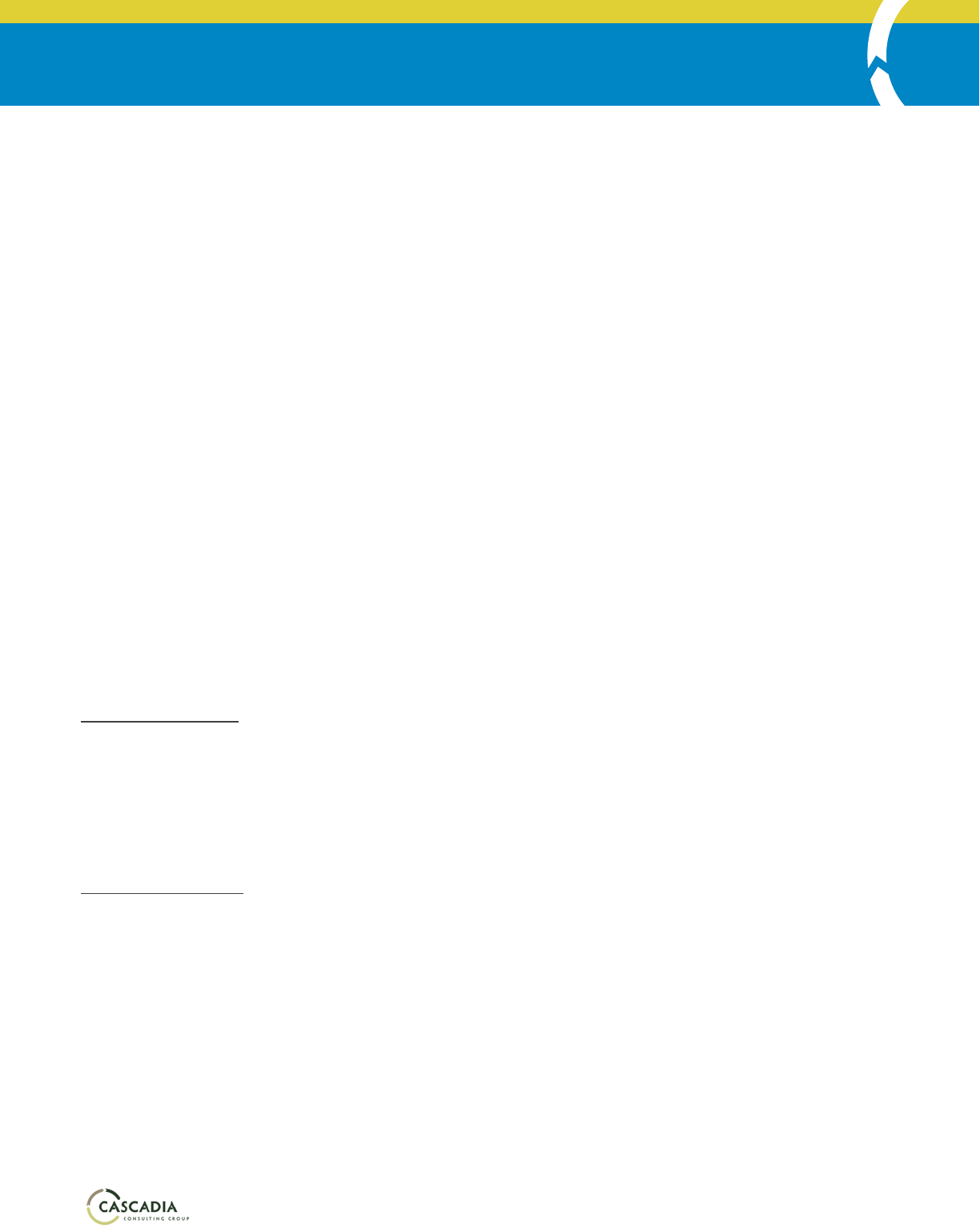
WASHINGTON STATE FOOD WASTE MANAGEMENT EVALUATION
41
aremanyorganicamendmentsonthemarket:bark,woodmulch,biochar,wormcastings,andengineeredhydro-
mulch,amongothers.Buyersareinundatedwithoptionstochoosefromandmaynotknowwhichamendmentis
bestforthem(CascadiaConsultingGroup,2019).
Opportunities
Thereismuchattentionfocusedondevelopinganaerobicdigestionin
Washington.WashingtonStateUniversityis
propellingtheseeffortsbycontinuingtosupportrobustresearchanddevelopmenteffortsaroundimproved
efficiencyofconversionatvariousscales,nutrientrecovery,biogasconditioning,andintegrationofotherorganic
wastes,especiallyfoodwasteandwastedfood.Theopportunitieslistedherearegroupedbytypeof
digester.
Small-scale Digesters
Small-scaledigestershavebeensuccessfuloutsideofWashington.HomeBiogas,locatedinIsrael,hasdevelopeda
digesterforhouseholdusethatcanprocesssixlitersoffoodwasteperdayandprovideenergyforcooking,heating,
andlighting.HomeBiogashasinstalledsystemsin90countriessince2015(BiogasWorld,2019).
LikeImpact
Bioenergyrepresentatives,HomeBiogasclientsseevalueinkeepingthebenefitsofanaerobicdigestionon-site.The
ciderythatImpactBioenergypartnerswithcanusethedigestateandthebiogascanbeusedasvehiclefueloron-
siteheating.ImpactBioenergyiscurrentlyplanningadigesterthatwouldsupporta
foodbankroofgarden,withthe
digesterprovidingfertilizer,savingwater,andprovidingavaluableeducationalopportunity(Kumar&Patel,2020).
ImpactBioenergyisdevelopingablockchainledgersystemtotrackdigesterinputsandoutputsthatcouldgreatly
benefittrackingandimpactmeasurementforsmall-scaledigesters.Thisnewsystemwouldmake
itpossibletotrack
feedstockvariablesandrespondtoproblemsinreal-time.Thedevelopmentofthissystemisanimportantlearning
opportunityfordistributeddigestersystemsand,ImpactBioenergyrepresentativeshope,willclearlyillustratethe
businesscasefordistributeddigesters(Kumar&Patel,2020).
Dairy Digesters
Solid Waste Processing
Oneon-farmdigesteriscurrentlyapplyingforasolidwastepermittoprocessahigherproportionoffoodwasteand
additionalfoodwastetypes (Maurer,2020).Wewerenotabletoobtainaccesstoindividualdigesterreports,sothe
realimpactofthischangeisnotclear.Dependingonthefood
wastesourcesthisdigesterwillprocess,itmayface
challengesofde-packagingfoodwasteandmaintainingaslurryconsistencywithinthedigester.Iftheapplicationis
successful,itmayresultinmorefoodwastebeingrecycledthroughanaerobicdigestionandprovidesomeuseful
learnings.
Renewable Natural Gas
Renewablenaturalgas(RNG)isapromisingopportunityfordairydigestersandothernewdigesters.RNGis
producedbyremovingcarbondioxide,othergases,andcontaminantsfromthebiogasoutputofanaerobic
digesters.Itcanbeusedasadirectsubstituteforfossilnaturalgasinapplicationsfrompowergenerationto
heating
andtransportation(WADepartmentofCommerceandWSUEnergyProgram,2018).
InWashington,RNGcanprovidebetterreturnstodigestersthanelectricit ysales,particularlyduetoRFScredits
(WashingtonStateUniversityExtension,2012).Inaddition,thereareseveralnewprogramsandincentivesto
supportdigestersproducingRNG,including:
AnewlyadoptedrequirementthatthefournaturalgasutilitiesinWashingtonoffervoluntary“green
gas”programstoretailcustomers,whichshouldspurthemarketforRNGfrommultiplesources.

WASHINGTON STATE FOOD WASTE MANAGEMENT EVALUATION
42
EnergyTransformationProjectsestablishedundertheCleanEnergyTransformationActofferadifferent
pathwayforobligatedelectricalutilitiestoinvestinRNGdevelopment.
Nutrient Recovery
Ananaerobicdigestionprojectisusuallymoresustainablewhenithasmultiplesourcesofrevenue,suchasenergy,
fiberandnutrients,andenvironmentalincentives(WashingtonStateUniversityExtension,2012).
WRRF Digesters
Anaerobicdigestionisawidespreadstandardwastewatertreatmentprotocolandisawell-developedtechnology
forwaterresourcerecoveryfacilities(WRRF).Some
WRRFsacceptfoodwastewithhighpotentialenergyorfats,
oils,andgreases(FOG)toincreasetheirproductionofbiogasandcollecttippingfeesfordisposingoforganicwaste
products,thoughnoneofWashington’sWRRFsareknowntodothis(OregonDepartmentofEnergy,2018).Our
researchdidnotidentifyany
organizeddataindicatinghowmanyWRRFsinWashingtonStatehaveanaerobic
digesters,butpreviousresearchindicatesthatthereareatleast37inthestate,mostlikelylocatedinlarger
communities(Moulton,2018).Nationwide,ReFEDestimatesthatthereareover1,200ADfacilitiesinstalledat
WRRFs(Cirilli,etal.,2016).
IncludingfoodwasteasaninputtoWRRFsisunderactiveexplorationinKingCounty.TheKingCountyWastewater
TreatmentDivisionestimatesthatco-digestingafoodwasteslurrywithwastewaterwouldincreaseenergy
productionbyabout50percent,enablingtheWastewaterTreatmentDivisiontooffsetalargerportionofitscurrent
energyusewithitsownbiogas(CascadiaConsultingGroup,2019).
AnaerobicdigestionoffoodwasteatWRRFsisapromisingsolutionfortheCityofTacomaaswell.Sinceitwould
reduceemissionsanddivertwasteusingexistinginfrastructure,theCitycommissionedanevaluation,which
showedthatfoodwastesent
toanaerobicdigestionattheWRRFcouldfuel50refusehaulersatnet-zerocost.A
demonstrationprojectwasperformedinwhichfoodwastewascollectedfrom66commercialgenerators,
processedwithade-packagertopulpthematerialandcreateaslurry,thendigested.Theprojectcreateda
digestateofnormalquality,
butitdidhighlightsomechallengesaroundcontaminationfrommetals,plastics,and
fibrousordenseorganicwaste(Cirilli,etal.,2016).Commercialfoodwastecollectedinth eCityofTacomanowgoes
eithertocompostortheWRRF(CityofTacoma,n.d.).
Recommendations for Filling Data Gaps
Conduct Interviews of On-Farm Anaerobic Digesters
Knowledgeofspecificsourcesoffoodwaste
inputstoon-farmdigestersandasummaryofchallengesand
opportunitiesatthedigesterlevelwouldaddclaritytotheoverallflowoffoodandfutureprojectionsrelatedto
digestion.Forinstance,itisunknownwhetherthefourdairydigesterscurrentlynotprocessingfoodwastemay
beginacceptingit(orin
somecases,resumeacceptingit)(Maurer,2020).OneEcologyrepresentativebelievesthat
somedairydigestersmaynotre-openatall,thoughothersassessthattheywilllikelycomebackonlinebecause
digestionisthemostcost-effectiveoptiondairieshaveformanagingexcessnutrients,especiallyforlargeoperations
inthesouth-central
partofthestate(Kennedy,2013).
Offer Voluntary Reporting for Small-Scale Digesters
ImpactBioenergy’smultip lefacilitiesprovideavaluablecasestudyofdigestersofvaryingsizes,fromoneprocessing
about25tonsperyeartooneprocessing1,500tonsperyear.However,ImpactBioenergyisstillarelativelynew

WASHINGTON STATE FOOD WASTE MANAGEMENT EVALUATION
43
companyandtheextentofothersmall-scaledigestersisnotknown.Werecommendofferingvoluntaryreporting
forsmall-scaledigesterstobeginestablishingadatasetforthisemergingfoodwastemanagementpathway.
EMERGING SOLUTIONS
Fertilizer Technologies
WISErgoffersasmall-scale,on-sitemanagementsystemforfoodwasteandnutrientrecoverybasedonfastaerobic
digestion.Thecompanyhasinstalledfoodwaste“harvesters”at13supermarketsinWashington.Supermarketstaff
addpre-consumerfoodwastetoeachharvester,andtheharvestermaintainsaconstanttemperatureandtracksthe
amountand
typeoffoodwasteenteringthesystematahighlevel.Thenthefoodwasteissenttoacentralized
facilityinRedmond,Washington,wheretheaerobicdigestionprocesstakesplaceandturnsthefoodwasteintoa
nutrient-densebiofertilizer.WISErgstaffdidnotdisclosetheamountoffoodwaste
processedeachyearand
predictedthatnoadditionalharvesterswillbeinstalledinWashingtoninthenear-term,butthecompanyhopesto
expandtodifferentregionsoftheUnitedStates.WISErg’sexistenceandsuccessinWashingtonspeakstothe
potentialforsimilaron-sitesolutionstospreadinWashington(Rehmat&Lugo,
2020).
Bio-Based Materials
Afewsmallcompaniesarebeginningtocreateplasticsandpackagingoutofanaerobicdigestionby-products.
Corumatisanearly-stagestartupcreatingpackagingmadefromsolidssourcedfromanaerobicdigesters,whichcan
thenbeplacedbackint oanaerobicdigestersforrecovery(CorumatInc.).MangoMaterialscreatesbiopolymersout
ofmethanefrom
WRRFdigesters,oxygen,andbacteria(Joyce,2019).Whenthebacteriafeedsonmethaneand
oxygen,itproducesPHAs(polyhydroxyalkoanoates),whichareseparatedfromthebacteriaandmadeintoplastics.
MaterialsproducedbyCorumatandMangoMaterialsarebiodegradableeveninmarineenvironments(Helmer,
2019).
Theseandothercompaniesarestill
workingtocommercializePHAs.Barriersincludecostsandinfrastructureto
producethematerials.PHAsarestillmoreexpensivetoproducethanconventionalplastics.Iftheydobecomemore
widespread,theymaypromotetheconceptofdistributed,small-scaledigesterstoproduceplastics.Iftheyareable
toscaleup,theycouldmake
asignificantimpactonplasticwasteintheenvironment(Helmer,2019).

WASHINGTON STATE FOOD WASTE MANAGEMENT EVALUATION
44
References
Ambroz,J.(2017,October30).The Next Frontier in Food Donation.RetrievedfromSecondHarvestHeartland:
https://www.2harvest.org/content_types/blog-posts/the-next-frontier-in-food.html#.Xs1S3EBFxYc
AmericanSocietyforHorticulturalScience.(2016,December27).Campus composting programs effective in
educating students.RetrievedfromPHYS.ORG:https://phys.org/news/2016-12-campus-composting-
effective-students.html
Anzilotti,E.(2020,February18).How a new approach to data is powering Feeding America's fight against hunger.
RetrievedfromTableau:https://www.tableau.com/about/bl og/2020/2/data-powering-feeding-america-
fight-hunger
Batjiaka,R.(2016,October).Compost Use by State DOTs.RetrievedfromBioCycle:
https://www.biocycle.net/2016/10/24/compost-use-state-dots/
Berkenkamp,J.,&Phillips,C.(2017).Modeling the Potential to Increase Food Rescue: Denver, New York City and
Nashville.NaturalResourcesDefenseCouncil.RetrievedMay12,2020,from
https://www.nrdc.org/sites/default/files/m odeling-potential-increase-food-rescue-report.pdf
Biernbaum,J.(n.d.).Compost for Small and Mid‐Sized Farms.MichiganStateUniversity.Retrievedfrom
https://www.canr.msu.edu/uploads/236/79117/Compost_for_Midsize_FarmsQuickCourse8pgs.pdf
BioCycle.(2014,November).Integrating Anaerobic Digestion with Composting.RetrievedfromBioCycle:
https://www.biocycle.net/2014/11/18/integrating-anaerobic-digestion-with-composting/
BioCycle.(2018).Compost & Digestate Volumes are Increasing ‐ Are California Markets Ready?Retrievedfrom
BioCycle:http://www.biocycle.net/wp-content/uploads/2018/08/BCWC18_Workshop.pdf
BiogasWorld.(2019,July12).What is the Future of Small‐Scale Anaerobic Digestion?RetrievedfromBiogasWorld:
https://www.biogasworld.com/news/future-small-scale-anaerobic-digestion/
Bolt,K.,Carter,L.,Casey,D.,Chan,N.,Chen,
R.,Jones-Smith,J.,...Yang,A.(2019).Healthy Food Availability & Food
Bank Network Report. Report for City of Seattle and Seattle City Council.Seattle.RetrievedMay11,2020,
from
https://www.seattle.gov/Documents/Departments/CityAuditor/auditreports/030519%20Corrected%20Heal
thy%20Food%20Availability%20Food%20Bank%20Network%20Report_FINAL.pdf
Brown,D.S.(2019).ValueofCompostinAgriculturalUses.King County Organics Recycling Summit Day 2.Retrieved
fromhttps://kingcounty.gov/depts/dnrp/solid-waste/programs/linkup/organics/summits.aspx
BSR.(2014).Food Waste Reduction Alliance (FWRA) Analysis of U.S. Food Waste Among Food Manufacturers,
Retailers, and Restaurants.
CalRecycle.(2019).SB 1383 Infrastructure and Market Analysis.RetrievedApril28,2020,from
https://www.calrecycle.ca.gov/docs/cr/climate/slcp/infrastructuredraft.pdf
CalRecycle.(2019).SB 1383 Infrastructure and Market Analysis: Contractor’s Report.Retrieved
from
https://www2.calrecycle.ca.gov/Publications/Details/1652

WASHINGTON STATE FOOD WASTE MANAGEMENT EVALUATION
45
CascadiaConsultingGroup.(2015).Market Assessment for Recyclable Materials.KingCountySolidWasteDivision.
Retrievedfromhttps://kingcounty.gov/~/media/depts/dnrp/solid-waste/about/documents/waste-
monitoring-market-assessment-2015.ashx?la=en
CascadiaConsultingGroup.(2018).WA Department of Ecology 2015‐2016 Washington Statewide Waste
Characterization Study.
CascadiaConsultingGroup.(2019).King County LinkUp: Organic Materials Management in King County.KingCounty
SolidWasteDivision.Retrievedfromhttps://kingcounty.gov/~/media/depts/dnrp/solid-
waste/linkup/documents/organics-materials-market-assessment.ashx
CascadiaConsultingGroup.(2019).StopWaste Prepared Food Rescue Study Project Summary.Oakland,CA.
CascadiaConsultingGroup.(2020).Food Rescue Innovation Initiative Executive Summary.Seattle:SeattlePublic
Utilities.
Cascadia
ConsultingGroup.(2020).Mayor's Innovation Advisory Council Food Rescue Project Approach.
CascadiaConsultingGroup.(2020).PCC Community Markets & Seattle Public Utilities Food Rescue Partnership
Proposal .Seattle.
Cirilli,M.,Briggs,J.,Rein,A.,Tanger,K.,Matheson,S.,Chom,B.,...Serafino,M.(2016).A Roadmap to Reduce U.S.
Food Waste by 20 Percent.ReFED.RetrievedMay16,2020,from
https://www.refed.com/downloads/ReFED_Report_2016.pdf
CityofTacoma.(n.d.).Commercial Food Waste.RetrievedfromCityofTacoma:
https://cityoftacoma.org/cms/One.aspx?portalId=169&pageId=121013
Collins,D.,Harness,H.,&Bary,A.(2016).Commercial Compost Application on Western Washington Farms.
WashingtonStateUniversity.Retrievedfromhttps://snohomishcd.org/blog/2016/7/8/commercial-compost-
application-on-westernwashington-farms
Corumat Inc.(n.d.).RetrievedfromEntrepreneurshipWorldCup:
https://entrepreneurshipworldcup.com/startup/corumat-inc/
DairyNutrientManagementProgram,WSDA.(2011).Washington Dairies and Digesters.WSDA.Retrievedfrom
http://northwestchptap.org/NwChpDocs/343-WashingtonDairiesAndDigesters-web.pdf
FeedingAm erica.(n.d.).Delivering Food and Services.RetrievedfromFeedingAmerica:
https://www.feedingamerica.org/our-work/food-bank-network
FoodLifeline.(2020,April).
FoodLifelineFY19Year-EndStatistics.
FoodLifeline.(2019).FoodBankFY19ActivityReport.WA.
FoodWasteReductionAlliance.(2013).Analysis of U.S. Food Waste Among Food Manufacturers, Retailers, and
Wholesalers.
Forshee,S.(2015,July6).Washington’s small distilleries, brewers and vintners get a boost on extending big federal
tax break .RetrievedfromSeattleTimes:https://www.bizjournals.com/seattle/blog/2015/07/washington-
states-breweries-double-capacity-in-4.html

WASHINGTON STATE FOOD WASTE MANAGEMENT EVALUATION
46
FWRA.(2016).Food Waste Reduction Alliance (FWRA) 2016 Analysis of U.S. Food Waste Among Food
Manufacturers, Retailers, and Restaurants.
Guarente,G.(2020,April7).Washington Rushes to Relieve Food Banks, Which Could Be Fully Depleted in Two
Weeks.RetrievedfromEATERSeattle:https://seattle.eater.com/2020/4/7/21212770/washington-food-
banks-coronavirus-need-more-supplies-funding
HarvestAgainstHunger.(2020).2019FarmtoPantry .WSDA.Retrievedfrom
https://cms.agr.wa.gov/WSDAKentico/Documents/Pubs/749-FarmToFoodPantryHAHAnnualReport-2019.pdf
Hecht,A.A.,&Neff,R.A.(2019,November27).FoodRescueInterventionEvaluations:ASystematicReview .MDPI,
11(6718).doi:10.3390/su11236718
Helmer,J.(2019,
November5).Can Food Waste be Transformed into Biodegradable Plastic?Retrievedfrom
FoodPrint:https://foodprint.org/blog/biodegradable-plastic-food-waste/
Joyce,C.(2019,June17).Replacing Plastic: Can Bacteria Help Us Break the Habit? .RetrievedfromNPR:
https://www.npr.org/2019/06/17/728599455/replacing-plastic-can-bacteria-help-us-break-the-habit
Kennedy,N.(2013,November).Economics of Dairy Digesters in Washington State.RetrievedfromBioCycle:
https://www.biocycle.net/2013/11/18/economics-of-dairy-digesters-in-washington-state/
Kim,S.(2020,April22).Washington Lockdown Exit Plan Revealed by Gov. Jay Inslee as Stay‐at‐Home Order Due to
Be Extended Beyond May 4.RetrievedfromNewsweek:https://www.newsweek.com/coronavirus-update-
washington-stay-home-extended-lockdown-exit-plan-1499386
KingCountyDept.ofNaturalResourcesandParks.(2019).
Organic Materials Management in King County.Retrieved
April28,2020,fromhttps://kingcounty. gov/~/media/depts/dnrp/solid-waste/linkup/documents/organics-
materials-market-assessment.ashx
KingCountySolidWasteDivision.(n.d.).Documents ‐ waste monitoring & surveys.RetrievedfromKingCounty:
https://kingcounty.gov/depts/dnrp/solid-waste/about/waste-monitoring/waste-documents.aspx
Krainick,L.(2020,March23).UsingFoodWasteasAnimalFeed.(M.Seibert,Interviewer)
Kumar,S.,&Patel,K.(2020,May6).ImpactBioenergy'sAnaerobicDigesters.(M.Seibert,Interviewer)
Ma,J.,Wilson,K.,Zhao,Q.,Yorgey,G.,&Frear,C.(2013).Odor in Commercial Scale Compost: Literature Review and
Critical Analysis.WashingtonStateDepartmentofEcology.
Maurer,D.M.(2020,March19).AnaerobicDigestioninWashingtonState.(M.Seibert,Interviewer)
MAZON.(2018).A Tipping Point: Leveraging Opportunities to Improve the Nutritional Quality of Food Bank
Inventory.MAZON.RetrievedMay15,2020,fromhttps://mazon.org/assets/download-files/MAZON-
TippingPointReport-FINAL.pdf
Moulton,P. (2018).RNG-WWTP_2018-0827_allranked
+sitelocations.List of Wastewater Treatment Plans with
Anaerobic Digesters.
NaturalResourcesDefenseCouncil.(2017).ModelingthePotentialtoIncreaseFoodRescue:Denver,NewYorkCity,
andNashville.RetrievedApril28,2020,fromhttps://www.nrdc.org/sites/default/files/modeling-potential-
increase-food-rescue-report.pdf

WASHINGTON STATE FOOD WASTE MANAGEMENT EVALUATION
47
NorthwestGasAssociation.(2019).2020 Gas Outlook.NorthwestGasAssociation.RetrievedMay20,2020,from
https://www.nwga.org/gas-outlook/2020-outlook-study/
NorthwestHarvest.(2019).AnnualReport,2017-18.RetrievedApril28,2020,from
https://ww w.northwestharvest.org/financials
NutritionPolicyInstitute,UniversityofCalifornia.(2017).Needs Assessment of the Rural and Remote Member Food
Banks of the California Association of Food Banks.UniversityofCalifornia.
OregonDepartmentofEnergy.(2018).Biogas and Renewable Natural Gas Inventory SB 334 (2017): 2018 Report to
the Oregon Legislature.OregonDepartmentofEnergy.Retrievedfrom
https://www.oregon. gov/energy/Data-and-Reports/Documents/2018-RNG-Inventory-Report.pdf
Otten,J.,Diedrich,S.,Getts,K.,&Benson,C.(2015).Food Waste Prevention and Recovery Assessment 2015 Report.
Seattle:SeattlePublicUtilitiesandTheCityofSeattle'sOfficeofSustainabilityandEnvironment.
Phillips-Donaldson,D.(2019,November3).How pet food can reduce waste, use more ingredients.Retrievedfrom
PetfoodIndustry.com:https://www.petfoodindustry.com/articles/8571-how-pet-food-can-reduce-food-
waste-use-more-ingredients?v=preview
Platt,B.,&Fagundes,C.(2018).Yes! In My Backyard: A Home Composting Guide for Local Government.Institutefor
LocalSelf-Reliance.Retrievedfromhttps://ilsr.org/yimby -compost/
Pope,S.(2014,June20).Going Against The Grain: FDA Threatens Brewers' Feed For Farmers.RetrievedfromNPR:
TheSalt:https://www.npr.org/sections/thesalt/2014/06/20/323957894/going-against-the-grain-fda-
threatens-brewers-feed-for-farmers
ReFED.(2020,April15).BetterTogether:FoodSystemBestPracticesforNavigatingCOVID-19:Logistics.Retrieved
fromhttps://www.refed.com/content-hub/better-together-food-system-best-practices-for-navigating-covid-
19/?mc_cid=0db465ae49&mc_eid=d6362b0b35
Rehmat,S.,&Lugo,J.(2020,April24).WISErgandCascadiaPhoneCall.(M.Seibert,&A.Lumper,Interviewers)
Rotary
FirstHarvest.(2018).2018F2FPReport.WA.RetrievedApril28,2020,from
https://www .firstharvest.org/farm-to-food-pantry/
SecondHarvest.(2019).Second Harvest Accountability Report.
SecondHarvest.(n.d.).GetFoodAssistance.Retrievedfromhttps://2-harvest.org /i-need-food-assistance/
U.S.EPA.(2019).Excess Food Opportunities Map Version 2.0 ‐ supporting data files.
U.S.EPA.(n.d.).Industrial Uses for Wasted Food.RetrievedMay22,2020,fromhttps://www.epa.gov/sustainable-
management-food/industrial-uses-wasted-food
U.S.PIRGandFrontierGroup.(2019).Composting in America: A Path to Eliminate Waste, Revitalize Soil and Tackle
Global Warming.
Retrievedfromhttps://uspirg.org/reports/usp/composting-america
USDANationalAgriculturalStatisticsService.(2012).CensusofAgriculture:2012CensusVolume1,Chapter1:State
LevelData.RetrievedApril28,2020,from
https://www.nass.usda.gov/Publications/AgCensus/2012/Full_Report/Volume_1,_Chapter_1_State_Level/
Washington/

WASHINGTON STATE FOOD WASTE MANAGEMENT EVALUATION
48
WADepartmentofCommerceandWSUEnergyProgram.(2018).Promoting Renewable Natural Gas in Washington
State.RetrievedApril28,2020,fromhttps://www.commerce.wa.gov/wp-
content/uploads/2019/02/COMMERCE-RNG.pdf
WADepartmentofEcology.(2017).SolidWasteGeneratedandRecoveredinWashington-Tons,PerCapita,
RecoveryRate.Retrievedfromhttps://ecology.wa.gov/Regulations-Permits/Plans-policies/Washington-
state-waste-plan/Progress-report/Solid-waste-generation
WADepartmentofEcology.(2019).WAStateCompostedMaterialsfor2017(updated
11.14.19).
WADepartmentofEcology.(2020,Jan9).2018WACompostedMaterials(tons)Lastupdated01/09/20.
WADepartmentofEcology.(n.d.).Compost.RetrievedfromDepartmentofEcology,StateofWashington:
https://ecology.wa.gov/Waste-Toxics/Reducing-recycling-waste/Organic-materials/Managing-organics-
compost
WAStateCompostedMaterialsfor201 8.(2020,April28).WA:WADepartmentofEcology.
WashingtonStateLegislature.(2018).Chapter 173‐
350 WAC: Solid Waste Handling Standards.RetrievedMay14,
2020,fromWashingtonStateLegislature:https://apps.leg.wa.gov/wac/default.aspx?cite=173-350
WashingtonStateOrganicsContaminationReductionWorkgroup.(2017).Report and Toolkit.Retrievedfrom
https://static1.squarespace.com/static/585c2db75016e175c9d685b7/t/59932c0be4fcb58c9335fec5/15028
17295485/Washington+State+Organics+Contamination+Reduction+Workgroup_FINAL.pdf
WashingtonStateUniversityEnergyProgram.(2018).Promoting Renewable Natural Gas in Washington State: A
Report to the Washington State Legislature.DepartmentofCommerce,StateofWashington.Retrievedfrom
https://www.commerce.wa.gov/wp-content/uploads/2019/01/Energy-Promoting-RNG-in-Washington-
State.pdf
WashingtonStateUniversityExtension.(2012).Anaerobic Digester Project and System Modifications: An Economic
Analysis.WSUExtension.Retrievedfrom
https://research.libraries.wsu.edu:8443/xmlui/bitstream/handle/2376/5268/EM090E.pdf;sequence=2
Waste2Resources.(2016).Advancing Organics Management in Washington State: The Waste to Fuels Technology
Partnership.Olympia,Washington:WADepartmentofEcologyandWashingtonStateUniversity.Retrieved
fromhttps://fortress.wa.gov/ecy/publications/SummaryPages/1607008.html
Waste2Resources.(2018).Advancing Organics Management in Washington State: The Waste to Fuels Technology
Partnership 2015‐2017 Biennium.RetrievedMay25,2020,from
https://fortress.wa.gov/ecy/publications/documents/1807010.pdf
WSDA-DairyNutrientManagementProgram.(2018,June5).Washington Dairy Farms ‐ 2018.Retrievedfrom
WSDA:https://www.arcgis.com/apps/webappviewer/index.html?id=5d59ea6756c7430c803e58441cdf34e1
WSDA.(2018).
Association of American Feed Control Officials (AAFCO) Official Publication (OP), 2018 Defined
Ingredient Categories.RetrievedfromAnimalFeedProgram:
https://cms.agr.wa.gov/WSDAKentico/Documents/Pubs/766-AAFCO-OPDefinedIngred.pdf?/766-AAFCO-
OPDefinedIngred
WSDA.(2019).AnimalFeedDistributorsLicensees(In-state).WA.

WASHINGTON STATE FOOD WASTE MANAGEMENT EVALUATION
49
WSDA.(2019).ListofEFAPandTEFAPContractorsandSubcontractors.WA.
WSDA.(2019).Running a Successful Farm Business: Licensing.RetrievedfromWSDA:
https://cms.agr.wa.gov/WSDAKentico/Documents/DO/RM/RM/5_Licenses.pdf
WSDA.(2020).AnimalfeeddistributionintonsJuly'18-June'19.
WSDA.(2020,May11).Commercial Feed Licensing General Information.RetrievedfromWSDA:
https://agr.wa.gov/departments/animals-livestock-and-pets/animal-feed/commercial-feed-general-
information
WSDA.(2020).Spreadsheet:18-19ContractorsandSubs.
WSDA.(n.d.).Anaerobic Digesters.RetrievedfromWashington
StateLegislature:
https://apps.leg.wa.gov/wac/default.aspx?cite=173-350-250
WSDA.(n.d.).General Information about Commercial Feeds Licenses.RetrievedfromWSDA:
https://agr.wa.gov/departments/animals-livestock-and-pets/animal-feed/commercial-feed-general-
information
WSDA.(n.d.).Pet & Specialty Pet Food Product Registration.RetrievedMay20,2020,fromWSDA:
https://agr.wa.gov/departments/animals-livestock-and-pets/animal-feed/pet-food-registration
WSDA,W.D.(2018).Options for the Processing and Disposal of Municipal Yard Waste Generated in Apple Maggot
Quarantine Areas.Retrievedfromhttps://fortress.wa.gov/ecy/publications/documents/1807026.pdf
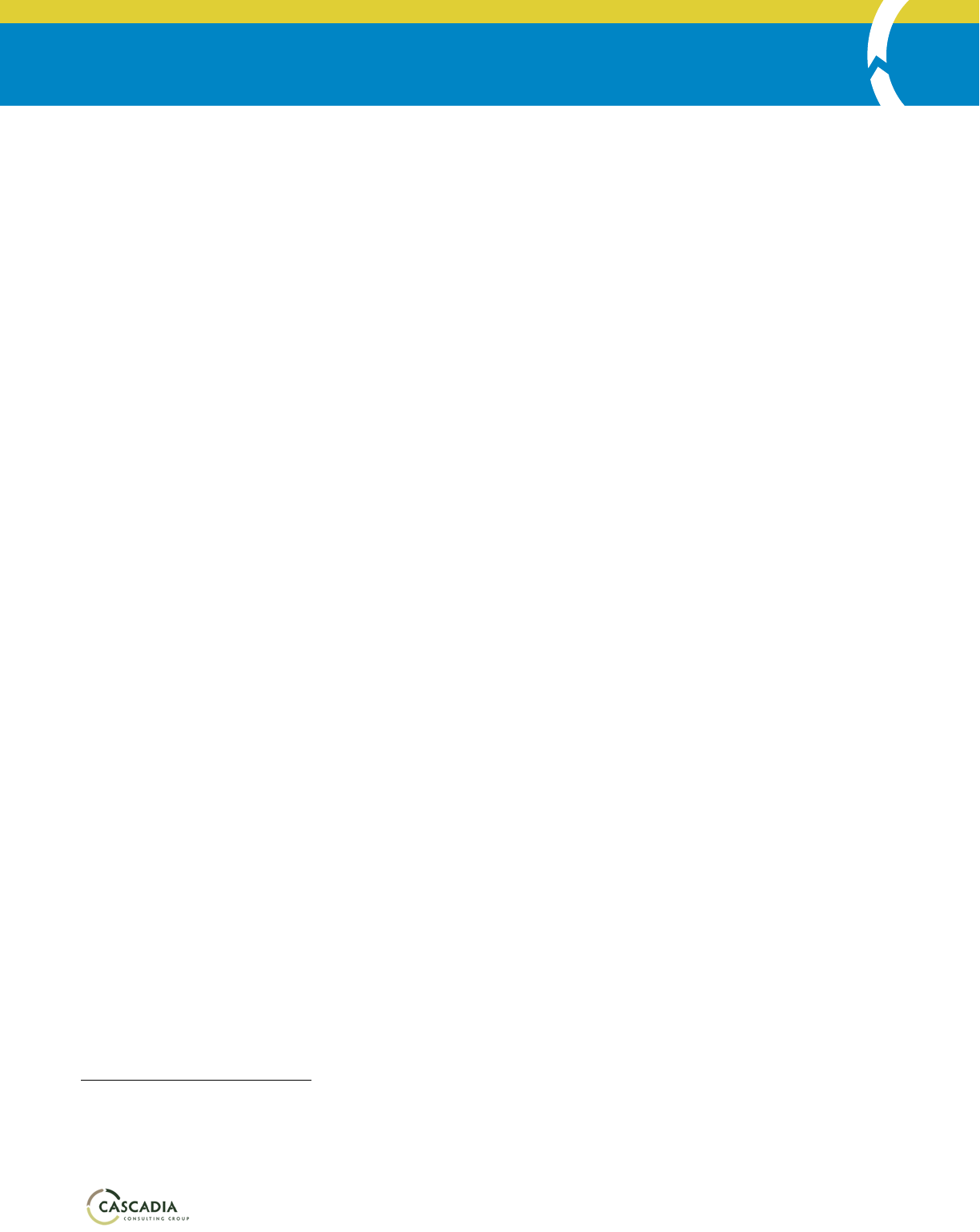
WASHINGTON STATE FOOD WASTE MANAGEMENT EVALUATION
50
APPENDICES
Appendix A: Washington State Food Waste Flow Model Methodology
WrittenbyFranklinAssociates,ADivisionofERG(EasternResearchGroup)
Model Introduction
AMicrosoftExcel-basedspreadsheetmodelwasdevelopedtoestimatethequantityoffoodwasteandwasted
foodthatisrecoveredanddisposedinWashingtonState,termedfoodwastemanagementpathways.Theprimary
goalofthemodelistoquantify
theamountoffoodwasteandwastedfoodthatisorcouldbedivertedfrom
disposalinlandfillsandcombustionfacilit ies.Twelvepotentialgeneratorsoffoodwasteareincludedinthemodel
2
:
Food Waste Generators
Farms
Manufacturing
Residences
Consumer-facingbusinesses
o Institutionsofhighereducation
o Hospitals
o Hotelsandmotels
o K-12schools
o Nursinghomes
o Prisons
o Restaurants
o Supermarkets
3
o Wholesaledistributors
Generatedfoodwasteandwastedfoodisallocatedamongtwodisposalandsevenrecoverypathways.Asmall
portionofnon-edibledonatedfood,approximately1.4percent,isultimatelydistribu tedamongtheothereight
disposal/recoverypathways.
Recovery
Donation
Agricultureproducts
Anaerobicdigestion
Animalfeed
2
Othergeneratorsoffoodwaste,expectedtobeminorcontributorstoStatetotals,werenotincludedinthe
analysis.Suchpotentialgeneratorsincludeofficebuildings,sportsvenues,etc.
3
Supermarketsincludebothsupermarketsandsupercenters.

WASHINGTON STATE FOOD WASTE MANAGEMENT EVALUATION
51
Bio-basedmaterials
Composting
Landapplication
Disposal
Landfill
Waste-to-energycombustion
TheanalysisisintendedtohelpWashingtonStateassessopportunitiesforexpandedfoodwasterecoveryandto
targeteffortsatspecificgeneratorswithlowfoodwasterecoveryrates.
Methods
Totheextentpossible,themodelrelieson
dataspecifictofoodwasterecoveryanddisposalintheStateof
Washington.Statespecificdata wasavailableforsevenoftheninemanagementpathwaysshownab ove.Recovery
offoodwasteviaagriculturalandbio-basedproductsrecoverypathwayswasestimatedbasedonnationalrecovery
statisticsformanufacturers,restaurants,supermarketsand
wholesaledistributors.Themostrecentlyavailabledata
wereusedforallestimates.Modelresultsestimateannualfoodwastegeneration,recoveryanddisposalin
WashingtonStateforarepresentativeperiodbetween2016and2019.
WashingtonStatedatagenerallyprovidesestimatesoffoodwasterecoveryanddisposalviaindividualpathways
(i.e.landfill,compost,
etc.).Nationalsamplingstudyestimatesoffoodwastegeneration,recoveryanddisposal
providemoredetailandinsightintothegenerationoffoodwasteforthefollowinggeneratingsectors:higher
education,hospitals,hotels,K-12schools,nursinghomes,prisons,restaurants,supermarketsandwholesale
distributors.WashingtonStatedatawasuseddirectlytosupply
foodwastegenerationestimatesforfarmsand
residences.AmixtureofnationalsamplingestimatesandWashingtonStatedatawasusedforthemanufacturing
sector.Theseestimationmethodsareindependentoffoodwastedisposalstatisticsanddonotperfectlymatch
reporteddatatotalsforWashingtonState.Aniterativeprocesswasusedto
facilitateconvergenceofthefood
wastemodelwithWashing tonStatedatatotalsoffoodwastemanaged.
Thefollowingsub-sectionsdescribeavailabledataandproceduresusedtoestimatethequantityoffoodwaste
processedbyeachoftheninerecoveryanddisposalpathways.Aseparatesub-sectionisprovidedforeachof
the
twelvegenerationsectors,describingrelationshipstorecovery/disposalpathwaysandproceduresusedtoestimate
sectorfoodwastegenerationwhenStatespecificdatawasnotavailable.
Donation
Statespecificdatawasidentifiedforthreeoftheprimaryfooddonationdistributionnetworksoperatingin
WashingtonState.Reportedquantitiesofdonatedfoodfromthese
organizationsincludefoodsourcedfromall
generationsectors,purchasedfoodandfoodfromfederalcommodityprograms.Foodpurchasesandfoodfrom
federalcommoditiesprogramsisoutsidethescopeofthisprojectandwasexcludedfromtheanalysis.The
distributioninTableA-1wasusedtoallocatedonatedfoodwasteamong
thevariousgeneratingsectorsbasedon
datareportedbyFoodLifelineand2
nd
Harvest.Thesamedistributionwasappliedtoallthreedistribution
organizations.1.4percentofdonatedfoodwasassumedtobecompostedordisposedofbasedonaveragefood
lossesreportedbyFoodLifelineand2ndHarvest(U.S.EPA,2019a).Generatedfoodwastewasallocatedtothe
threecommonroutesof
municipalfoodwastedisposal(compost,combustionandlandfill)basedontotalfood
wastedisposalviathesethreepathwaysinWashingtonState.
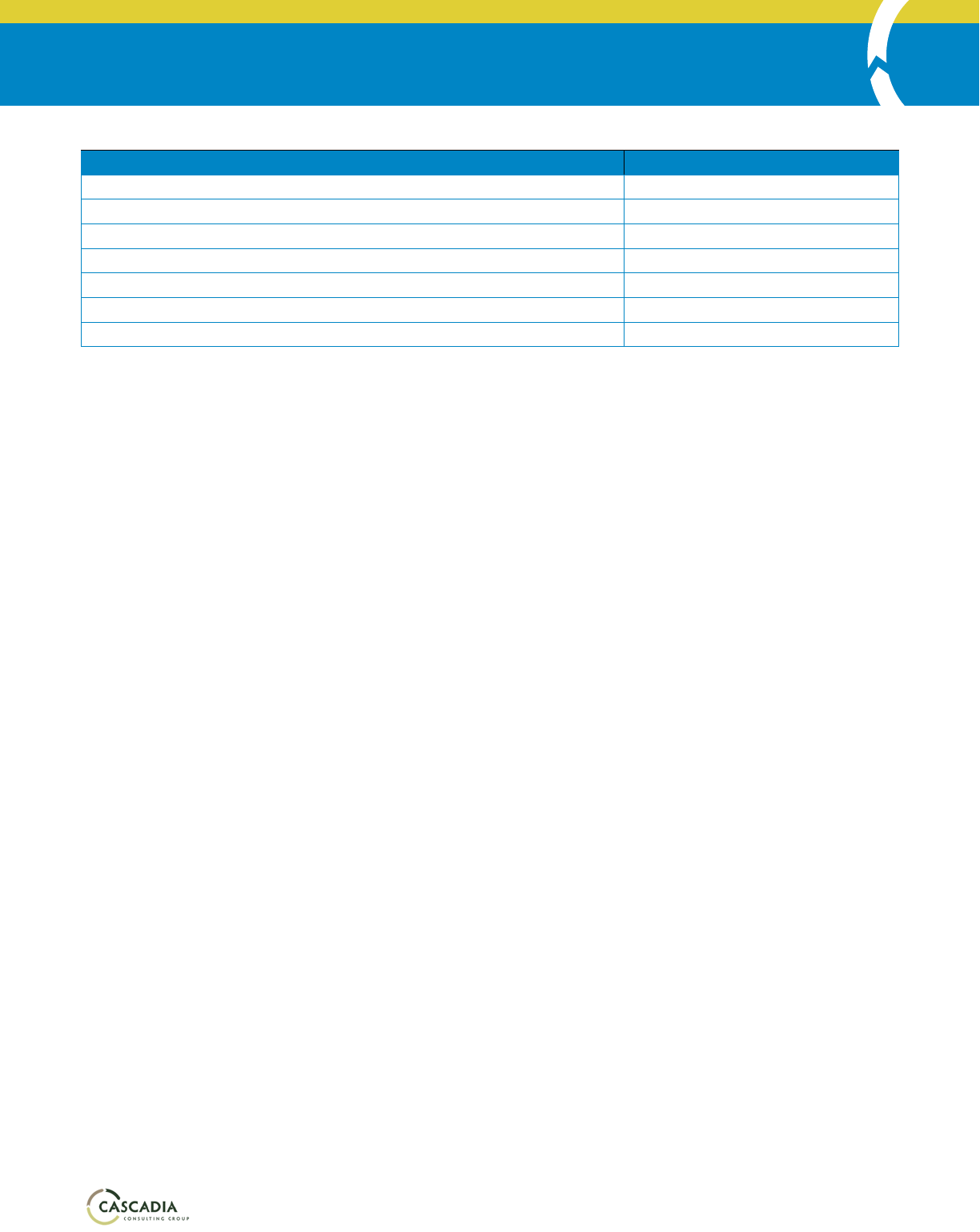
WASHINGTON STATE FOOD WASTE MANAGEMENT EVALUATION
52
TableA-1.SourcesofDonatedFood
SourceofDonatedFood Shareoftotalincomingfood
Grocerystore
1
45%
RestaurantsandRetail 17%
Farmers 11%
Manufacturers 11%
FederalCommodities(TEFAP) 11%
Purchases 5%
Total 100%
1
Fooddonationfromgrocerystoresisassumedtoincludefooddonatedbywholesaledistributors.
Landfill
RecordsoflandfillMSWdisposalinWashingtonStatewereavailablefor2017.AWashingtonStatewaste
characterizationstudyfor2015-2016wasusedtoestimatethequantityoffoodwastepresentindisposedMSW.
Thewastecharacterizationstudyind icatesthatfoodwastecomprises17.3percentofMSWbymass.Thewaste
characterizationstudydocumentsthequantityofdisposedfoodwastefromresi dentialandcommercialgenerators
andself-hauling.Self-hauledwastecompriseslessthan5percentoftotalMSWdisposedandwasassumedtoshare
thesamesplitbetweenresidentialandcommercialgenerators asmunicipallyhauledMSW.InWashingtonState51
percentof
landfilldisposedfoodwasteisfromcommercialsources(includingmanufacturing)withtheremainder
fromresidences(CCG,2018).
Nationalstatisticswereusedtoseparateoutthequantityoflan dfilledfoodwastefromthemanufacturingsector.
Only3.4percentoffoodwastefromthemanufacturingsectorisestimateddisposedofinlandfills(BSR,
2014;
FWRA,2016).
Waste-to-Energy Combustion
RecordsofMSWcombustioninWashingtonStatewereavailablefor2017.TheWashingtonStatewaste
characterizationstudyfrom2015-2016wasusedtoestimatethequantityoffoodwastepresentincombusted
MSW.Thewastecharacterizationstudyindicatesthatfoodwastecomprises16.2percentofMSWby
massin
EasternWashington,wherethecombustionfacilityislocated.InEasternWashingtonState49.6percentoflandfill
disposedfoodwasteisfromcommercialsources(includingmanufacturing)withtheremainderfromresidences
(CCG,2018).
Nationalstatisticswereusedtoseparateoutthequantityofcombustedfoodwastefromthemanufacturingsector.
Only0.68percentoffoodwastefromthemanufacturingsectorisestimatedcombusted(BSR,2014;FWRA,2016).
Composting
WashingtonStatecollectsdataonfoodprocessingwaste,post-consumerfoodwaste and yarddebris/foodscraps
senttopermittedcompostingfacilities.Data fortheyear2018wasusedinthisanalysis.Foodwaste
fromout-of-
statesourceswasexcluded fromtheanalysis.Foodprocessingwast ewasassumedtobeproducedbythe
manufacturingsector.Post-consumerfoodwasteandyarddebris/foodscrapswereallocatedamongresidential
andcommercialgeneratorsbasedondataprovidedbytheWashingtonStateDepartmentofEcology.Thequantity
offoodwaste
presentinmixedyarddebris/foodscrapswasassumedtobe10percentw/wbasedonlimited
compostfacilitysurveydataprovidedbytheCedarGroveCompostingCompany.

WASHINGTON STATE FOOD WASTE MANAGEMENT EVALUATION
53
Animal Feed
TheWashingtonStateDepartmentofAgriculturecollectsdataonwasteproductsthatserveasinputstoanimal
feedproduction.Datafortheyear2019wasusedinthisanalysis.Thefollowingwastecategorieswereincludedin
theanalysis:animalproducts,brewerswaste,distillerswaste,screeningsandhumanfoodby-products.National
statisticswereusedtoestimatetheportionoffoodwastegoingtoanimalfeedfromrestaurants,wholesale
distributorsandsupermarkets.Theremainderoffoodwastegoingtoanimalfeedwasassumedtobegeneratedby
themanufacturingsector.
Anaerobic Digestion
TheDepartmentofEcologytracksthequantityoffoodprocessingwaste
(pre-consumer)thatisanaerobically
digestedinthestate.Datafortheyear2017wasusedintheanalysis.Themanufacturingsectorwasassumedtobe
thesolesourceofthiswastestream,whichcomprises0.36percentoftotalmanufacturingfoodwaste.
Land Application
TheWashingtonStateDepartmentofEcologytracksthequantity
offoodprocessingwastethatislandappliedin
thestate.Datafortheyear2017wasusedinthean alysis.Themanufacturingsectorwasassumedtobeth esole
sourceofthiswastestream,whichcomprises0.17percentoftotalmanufacturingfoodwaste.
Agricultural Products
Nationalstatisticsonfoodwaste
recoveryformanufacturing,restaurants,supermarketsandwholesaledistributors
wereusedtoestimatethequantityoffoodwasterecoveredinagriculturalproducts(BSR,2014;FWRA,2016).No
dataspecifictoWashingtonStatewasavailabletoquantifyfoodrecoveredviathispathway.WISErg,aWashington-
basedfertilizercompany,isknowntouserecovered
foodwasteintheproductionofagriculturalinputs(WISErg,
2018).
Bio-based Products
Nationalstatisticsonfoodwasterecoveryfor manufacturing,restaurants,supermarketsandwholesaledistributors
wereusedtoestimatethequantityoffoodwasterecoveredinbio-basedproducts(BSR,2014;FWRA,2016).
Farms
Excessfarmproductiondonatedtofoodbanks,foodpantries
andotherdonation-baseddistributionprogramsis
theonlysourceoffoodwasteproducedbythefarmingsectorthatisconsideredinthisanalysis.Otherfarm-based
foodwastewilltypicallybecompostedonsiteordirectlyincorporatedbackintoagriculturallandsandhasnot
historicallybeendisposedofinlandfills.Thiswaste
fallsoutsidethescopeoftheMSWdisposalsystem.The
donationdistributionlistedinTableA-1wasusedtoallocat edrecordsoffooddistributiontothefarmingsector
basedon2019datafromFoodLifeline.
Manufacturing
ManufacturingfoodwastegenerationisbasedpartlyonWashingtonStatedisposal/recoverydata,withdatagaps
filledinusingrelevantnationalstatisticsonfoodwastedisposalinthemanufacturingsector.WashingtonState
reporteddatawasusedforanaerobicdigestion,animalfeed,composting,donationsandlandapplication.National
disposalstatisticswereusedtoestimaterecovery/disposalviabio-basedmaterials,agriculturalproducts,controlled
combustionandlandfill(BSR,2014;FWRA,
2016).

WASHINGTON STATE FOOD WASTE MANAGEMENT EVALUATION
54
Institutions of Higher Education
FoodwastegeneratedbyinstitutionsofhighereducationwasestimatedusingEPAestimatesforpoundsoffood
wastedisposedofpermealservedinpost-secondar yschools,0.4lbs/meal(U.S.EPA,2019b).Thenumberof
studentsenrolledinpost-secondaryinstitutionsinWashingtonStatewasdrawnfromnationaleducationstatistics
(NCES,2018).
Thenumberofmealsconsumed perstudentwasbasedon2017foodsalesfromtheUniversityof
Washington(HFSUW,2018)assuminganaveragepriceof$9permeal(Mathewson,2017).Foodsalesat the
UniversityofWashingtonwereassumedtoberepresentativeofotherstateinstitutionsonaperstudent
basis.
Generatedfoodwastewasallocatedtothethreecommonroutesofmunicipalfoodwastedisposal(compost,
combustionandlandfill)basedontotalfoodwastedis p osalviathesethreepathwaysinWashingtonState.
Hospitals
Foodwastegeneratedbyhospitalswasestimatedbasedonaveragefoodwasteproductionperhospitalbed,
653
lbs/bed/year(U.S.EPA,2019b).TheDepartmentofHomelandSecurityreportsthattherewere15,657bedsat
openfacilitiesinWashingtonStatein2017(DHS,2019a).Ofthe124openfacilitiesinWashingtonStatetendidnot
includeabedcountinDHSstatistics.Themedianbedcount,77,offacilities
reportingbednumberswasassumed
forthesetenfacilitiesandwasaddedtothereportedtotal.Generatedfoodwastewasallocatedtothethree
commonroutesofmunicipalfoodwastedisposal(compost,combustionandlandfill)basedontotalfoodwaste
disposalviathesethreepathwaysinWashingtonState.
Hotels and Motels
Food
wastegeneratedbyhotelsandmotelswasestimatedbasedonaveragefoodwastegeneratedperemployee
athotelsandmotels,1138lbs/empl oyee/year(U.S.EPA,2019b).TheUSEconomicCensusreportsthat40,554
personswereemployedinhotelsandmotelsinWashingtonStatein2017(USCensus,n.d.).Theemployeecount
includes
casinohotels.Generatedfoodwastewasallocatedtothethreecommonroutesofmunicipalfoodwaste
disposal(compost,c ombus tionandlandfill)basedontotalfoodwastedisposalviathesethreepathwaysin
WashingtonState.
K-12 Schools
FoodwastegeneratedinK-12schoolswasestimatedusinganannualestimateoffoodwaste
producedperstudent
inWashingtonState,43.7lbs/student/year(limitedsurvey)(WWF,2019).WashingtonStateenrollmentrecords
indicatethat1,102,695studentswereenrolledinK-12institutionsduringthe2018-2019schoolyear (Wa State,
2020).Generatedfoodwastewasallocatedtothethreecommonroutesofmunicipalfoodwastedisposal
(compost,combustionand
landfill)basedontotalfoodwastedisposalviathesethreepathwaysinWashington
State.
Analternatemethodofestimatingsectorfoodwastegeneratedwascalculatedbased onfoodwastegeneration
permeal(0.52lbs/meal)andthenumberofmealsservedannuallyatK-12institutions.Theestimationbasedonthe
number
ofstudentswaspreferredasboththenumberofstudentsandthewastegenerationfactorarespecificto
WashingtonState.Thealternatemethodreliesonnationalstatistics.Bothmethodsarepresentedforcomparison
intheaccompanyingExcelmodel.
Nursing Homes
Foodwastegeneratedinnursinghomeswasestimatedbasedonaverag efood
wastegeneratedperbedatnursing
andassistedlivingfacilities,1.8lb/bed/day(Draper/LennonInc.,2002).TheDepartmentofHomelandSecurity
reportsthattherewere36,654bedsavailableinnursinghomesandassistedlivingfacilitiesinWashington Statein

WASHINGTON STATE FOOD WASTE MANAGEMENT EVALUATION
55
2017(DHS,2019b).Generatedfoodwastewasallocatedtothethreecommon routesofmunicipalfoodwaste
disposal(compost,c ombus tionandlandfill)basedontotalfoodwastedisposalviathesethreepathwaysin
WashingtonState.
Prisons
Foodwastegeneratedinprisonswasestimatedbasedonaveragefoodwastegeneratedperinmate
atWashington
Statecorrectionalfacilities,1.12lbs/inmate /day(U.S.EPA2019b).Theaveragenumberofinmatesinfederaland
statecorrectionalfacilitieswasdeterminedtobe19,590inmatesfortheperiodfrom2017-2018(Bronson&
Carson,2019;Carson,2020).ThenumberofinmatesinlocalandcityjailsinWashingtonState
(11,254persons)
wasestimatedbasedonthenumberofindividualsinsuchfacilitiesnationallyas sumingsimilarincarcerationratios
(Washington/National)acrossfacilitytypes.SeetheaccompanyingExcelworkbookforfurther details.
Restaurants
Foodwastegeneratedinrestaurantswasestimatedusingfoodwastegenerationfactorsbasedonthenumberof
employeesatfull
andlimitedservicerestaurantsinWashingtonState.Foodwastegenerationatfullandlimited
servicerestaurantsis3,392and2,494lbs/employee/year,respectively(CCG,2006).TheUSEconomicCensus
indicatesthat116,957and108,063personswereemployedatfullandlimitedservicerestaurantsinWashington
Statein2017(USCensus,n.d.).
Nationalstatisticsonfoodwastedisposalpathwaysfortherestaurantsector were
usedtoallocategeneratedfoodwasteamongthepotentialdisposal/recoverypathways(BSR,2014;FWRA,2016).
AdjustmentsweremadetothenationalstatisticsbasedonWashingtonspecificdata,asdescribedonthe
RestaurantstabintheaccompanyingExcelworkbook.
An
alternatemethodofestimatingsectorfoodwastegeneratedwascalculatedbasedonsectorrevenue.The
estimationbasedonthenu mberofemployeeswaspreferredasitdifferentiatesbetweenlimitedandfull-service
restaurants.
Supermarkets
Foodwastegeneratedinsupermarketswasestimatedusingtheaverageoftwomethodsbasedonsectorrevenue
andsectoremployees.Foodwastegenerationperunitrevenuewasassumedtobe0.01lbs/dollar/year(BSR,
2014).Foodwastegenerationperemployeeisdifferentiatedbetweensupermarketsandsupercentersbeing2.0
and0.39tons/employee/yearrespectively(U.S.EPA,2019b).TheUSEconomicCensusindicatesthat111,776
personswereemployedatfoodretailersand
supercentersin2017.Totalrevenuefortheassociated
establishmentswas34.9billiondollars(USCensus,n.d.).
Thequantityoffooddonatedbysupermarketswasderivedfromdataavailableforfooddistributionagenciesin
WashingtonState.Theestimationoffooddonationsmadebysupermarketsisexpectedtoincludefoodfrom
wholesale
distributors.Allocationoffoodwastetootherdisposalandrecoveryrouteswasbasedonnationalsurvey
data(BSR,2014;FWRA,2016),whichwereadjustedtoestimatedisposalbasedonassumptionsdescribedonthe
SupermarketstaboftheaccompanyingExcelworkbook.
Analternatemethodwasconsideredforfoodwastegenerationbasedon
foodwasteproducedperestablishment
peryear.Duetothewidevariabilityinthesizeofretailestablishmentsthismethodwasnotconsideredinthefinal
calculation.
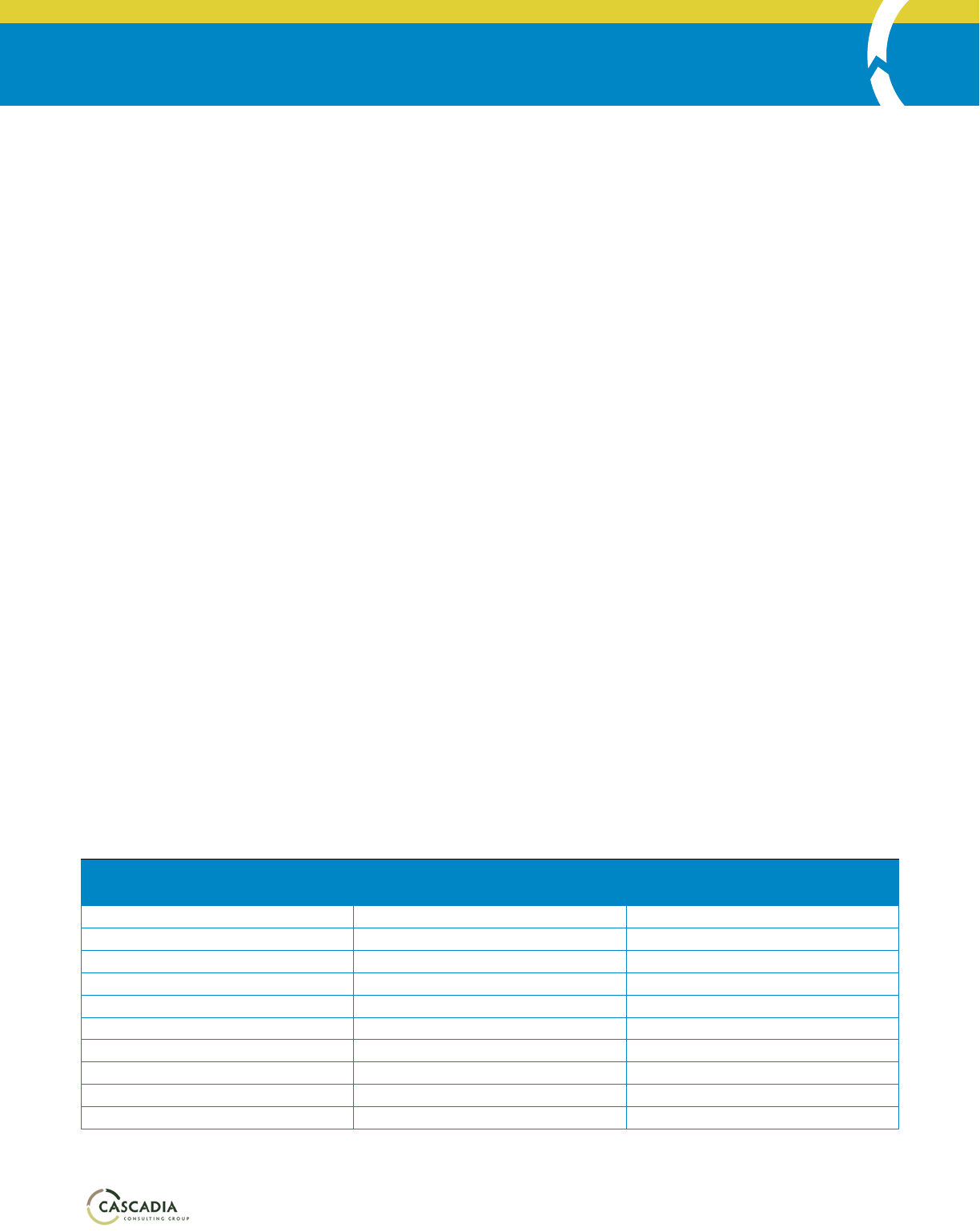
WASHINGTON STATE FOOD WASTE MANAGEMENT EVALUATION
56
Wholesale Distributors
Foodwastegeneratedbywholesaledistributorswasestimatedbasedonannualrevenueassuming0.01lbsfood
waste/dollar/year(U.S.EPA,2019b).TheUSEconomicCensusindicatesWashingtonwholesaledistributorshada
totalrevenueof29.3billiondollarsin2017(USCensus,n.d.).Allocationoffoodwastetootherdisposaland
recoveryrouteswasbasedonnationalsurveydata(BSR,2014;FWRA,2016),whichwereadjustedtoestimate
disposalbasedonassumptionsdescribedontheWholesaleDistributorstaboftheaccompanyingExcelworkbook.
Residential
FoodwastedisposalfromresidentialgeneratorsisbasedonWashingtonStaterecordsofwastedisposedat
landfills,controlled
combustionfacilitiesandcompostingsites.
Model Fitting Procedure
Thesectionsaboveonfoodwastegeneratorsandrecovery/disposalpathwaysdescribesecondarydataand
nationalsamplingstudyestimationproceduresusedtoestimatefoodwastegeneratedinWashingtonStateandthe
recoveryanddisposalrout es currentlyusedtomanagethatfoodwaste.Nationalsamplingstudy
estimation
proceduresareindependentofWashington
Staterecordsoffoodwastedisposalanddonotperfectlymatchtheavailablerecords.Aniterativemodelfitting
procedurewasusedtocorrectthisestimationoffoodwastemanagedtofittheavailabledataforWashington
State.
Excludingagriculturalproductsandbio-basedmaterialrecoverypathways,
forwhichnoWashingtonStatedata
wereavailable,thenationalsamplingestimationmethodsindicatethat2,755,752tonsoffoodwastewillbe
generatedinWashingtonStateannuallyduringtheperiodfrom2016-2019.Thisvaluehasapercentdifferenceof
2.6percentwhencomparedtothequantityofwasterepresentedin
WashingtonStaterecords(2,683,971
tons/year).
Sectorspecificestimatesoffoodwastegenerationbasedonnationalsamplingcalculationswereadjust ed
downwardstoaccountforthedifferencebetweenreportedandestimatedfoodwastegenerationasshow nin
TableA-2.Theadjustmentisequivalenttoatenpercentdecreaseinsectorfood
wastegenerationforeachofthe
listedsectors.
TableA-2.AdjustmentsMadetoBottom-UpFoodWasteGenerationEstimates,SectorTotals
SectorName
FoodWasteGeneration,Original
Estimate
FoodWasteGeneration,Adjusted
Estimate
Highereducation 5,721 5,148
Hospitals 5,364 4,828
Hotels 23,075 20,766
K‐12schools 24,094 21,682
Nursinghomes 12,049 10,843
Prisons 6,290 5,660
Restaurants 333,114 299,774
Supermarkets 160,564 144,494
Wholesaledistributors 146,924 132,219
Total 717,196 645,414
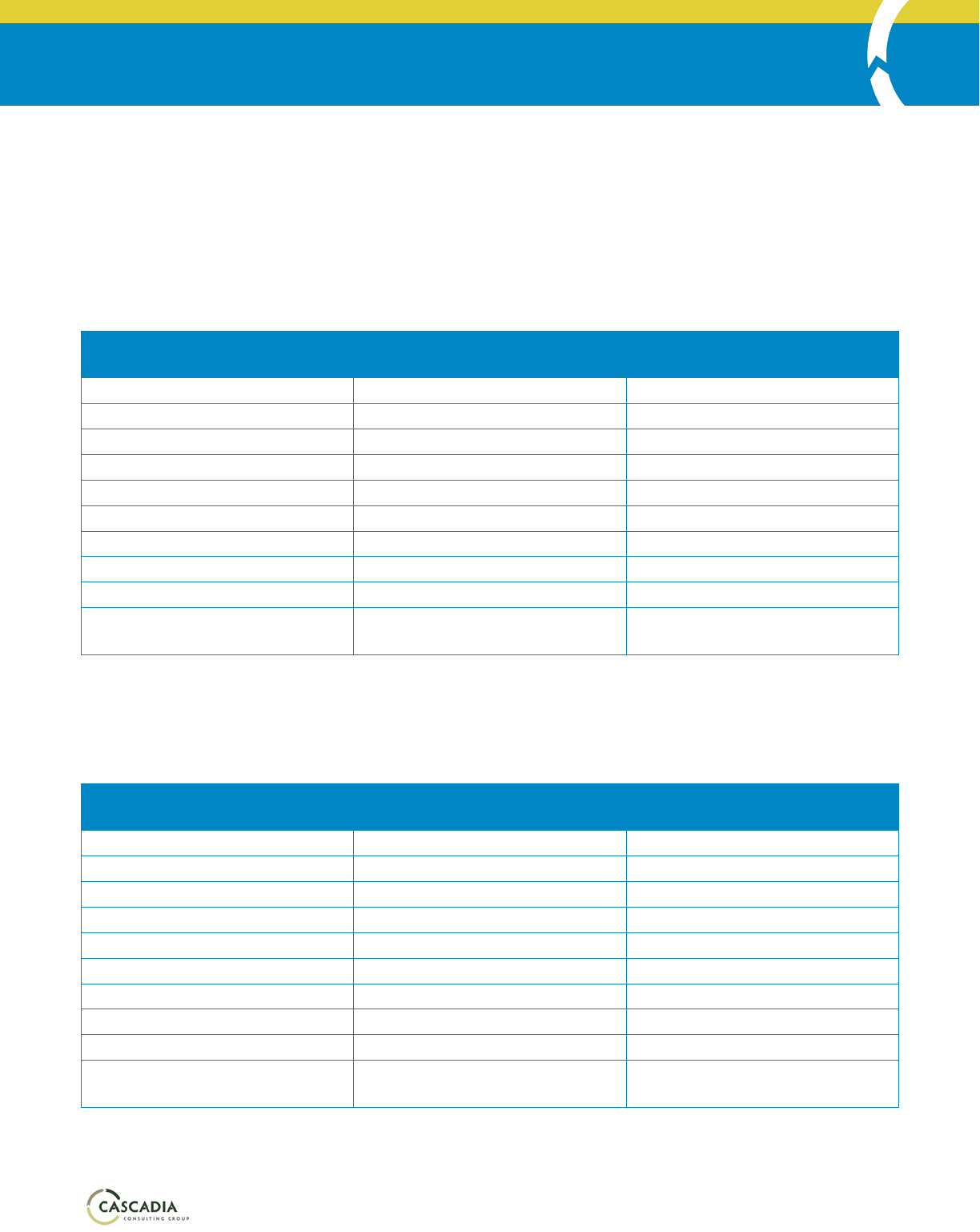
WASHINGTON STATE FOOD WASTE MANAGEMENT EVALUATION
57
Followingtheseadjustments,thepercentdifferencebetweenestimatedandrecordedfoodwastegenerationin
WashingtonStatewasreducedto0.2percent.TableA-3showsestimatedrecoveryanddisposaltotalsforeach
pathwayandcomparesthemagainsttotalsfromWashingtonStatedatasources.Useofnationalstatisticsaccounts
forthediscrepancies.
Basedonnationalstatisticsrecoveryanddisposalviaanaerobicdigestion,controlled
combustionandlandapplicationareoverestimated,whileanimalfeed,compostingandlandfillare
underestimated.Nationalstatisticalprofilesforfoodwastedisposalandrecoverywereredistributedtocorrectfor
thenoteddifferences.Detailsandlinkedcalculationscanbefoundin
theaccompanyingExcelworkbook.
TableA-3.Disp osalan dRecoveryRouteEstimatesfollowingAdjustmentofSectorTotalFoodWasteGeneration
Recovery/DisposalPathway
RecoveryandDisposalTotals,
Estimated
RecoveryandDisposalTotals,WA
Data
Agricultureproducts 2,928 NA
Anaerobicdigestion 21,368 5,765
Animalfeed 1,489,363 1,494,807
Bio‐basedmaterials 48,576 NA
Composting 135,754 159,574
Controlledcombustion 58,830 40,833
Fooddonation 49,082 49,082
Landfill 927,287 931,293
Landapplication 7,105 2,618
Totals,excludingagriculture and
bio-basedmaterials
2,688,790 2,683,971
TableA-
4
presentsasimilartabletothatincludedinTableA-3followingtheredistribution.Furtheriterationcould
bringthefiguresintocloseralignmentbutwouldyieldlittleornoadditionalinsight.
TableA-4.FinalDisposalandRecoveryRouteEstimationsfollowingModelFitting
Route
RecoveryandDisposalTotals,
ModelEstimate
RecoveryandDisposalTotals,WA
Data
Agricultureproducts 2,914 NA
Anaerobicdigestion 5,765 5,765
Animalfeed 1,494,582 1,494,807
Bio‐basedmaterials 48,414 NA
Composting 164,198 159,574
Controlledcombustion 39,792 40,833
Fooddonation 49,082 49,082
Landfill 930,254 931,293
Landapplication 2,618 2,618
Totals,excludingagriculture and
bio-basedmaterials
2,686,291 2,683,971

WASHINGTON STATE FOOD WASTE MANAGEMENT EVALUATION
58
Summary Model Interpretation and Limitations
Wherepossible,themodelprioritizesuseofdataspecifictowasterecoveryanddisposalinWashingtonState.The
modelfittingproceduredescribedconstrainsthemodelsuchthatsectorspecificestimatesoffoodwaste
generationbasedonnationalorWashington-basedstatisticsandfoodwastegenerationfactorsarenotallowedto
produce
estimatesthatexceedreportedfoodwasterecoveryanddisposaltotalsavailableforWashingtonState.
Priortothemodelfittingprocedure,estimatio noffoodwastegenerationintheStateofWas hingtonwas
overestimatedby2.7percent.Themodelfittingprocessreducedfoodwastegenerationestimatesbringing
estimatedquantitiesinlinewith
reporteddata.Nationalsamplingestimatesforspecificdisposalandrecovery
routeswereredistributedtomatchtheavailabledata,adjustingquantitiesestimatedforotherdisposaland
recoverypathwayssuchthat100percentofwastewasaccountedfor.
Themodelfittingprocedurealsoensuresthat100percentofreportedfoodwastedisposalreported
for
WashingtonStateisaccountedforinthegenerationestimatesproducedbythetwelvegenerationsectors.Food
wastegeneratedbyotherminorsources,notexp licitlyincludedinthemodel,isdistributed amongthetwelve
includedgenerators.Basedonthemodel’sstructure,themajorityofthiswasteisexpectedtobe
distributed
amongthenineconsumerfacingbusinesses,potentiallyoverestimatingfoodwastegeneratedbythesenine
sources.Giventhequalityofthematchbetweentheoriginalestim ationandreporteddataforWashingtonState,
priortomodelfitting,distortionsinmodelresultscausedbythisprocedureareexpectedtobeminor.
Itis
believedthatthemodelfittingprocedurereasonablyallocatesknownfoodwastegenerationintheStateof
Washingtonamongstthe12primarygeneratingsectors.Amendednationalstatisticalprofilesoffoodwaste
recoveryanddisposalfor manufacturing,supermarkets,restaurantsandwholesaledistributorswereamendedto
reflecttheavailabledisposaldataforWashington
State,fillingindatagapswithreasonablenationalvalues.
Aswithallmodels,thismodelislimitedbythequalityofthedatauponwhichitisbased.Asdescribedabove,
priorityisgiventorecordsorestimatesoffoodwasterecoveryanddisposalinWashingtonState.Theserecordsare
deemed
tobeofhighquality.Themodelestimatesveryspecificvaluesbutshouldonlybeviewedasestimateswith
oneortwosignificantfigures.Reviewoftheaccompanyingspreadsheetmodel,particularlytherangein
documentedfoodwastegenerationfactors,estimationprocedu r esandmanagementpathwaydistributionswill
helpgivecontextto
thecertaintyoruncertaintywithwhichindividualsectorestimatesshouldbeviewed.
Model References
Bronson&Carson.(2019).AppendixTable2.Prisonersunderjurisdictionofstateorfederalcorrectionalauthorities,
byraceandHispanicorigin,December31,2017.BureauofJusticeStatistics.
BSR.(2014).Analysis of U.S. Food Waste Among Food Manufacturers, Retailers and Restaurants(p.34).FoodWaste
ReductionAlliance.
Carson.
(2020).AppendixTable2:Prisonersunderjurisdictionofstateorfederalcorrectionalauthorit ies,by
jurisdictionandraceorethnicity,December31,2018.BureauofJusticeStatistics.
CCG.(2006).Waste Disposal and Diversion Findings for Selected Industry Groups(No.341–06006).California
IntegratedWasteManagementBoard.https://www2.calrecycle.ca.gov/Publications/Download/787
CCG.(2018).2015‐2016 Washington Statewide Waste Characterization Study(No.16-07–032;p.157).Stateof
WashingtonDepartmentofEcology.
https://fortress.wa.gov/ecy/publications/documents/1607032.pdf
DHS.(2019a).Hospitals. Washington 2017‐2018 Data download.DepartmentofHomelandSecurity.https://hifld-
geoplatform.opendata.arcgis.com/datasets/hospitals

WASHINGTON STATE FOOD WASTE MANAGEMENT EVALUATION
59
DHS.(2019b).Nursing Home / Assisted Care. Washington 2017‐2018 Data download.DepartmentofHomeland
Security.https://hifld-geoplatform.opendata.arcgis.com/datasets/78c58035fb3942ba82af991bb4476f13_0
Draper/LennonInc.(2002).Identification, Characterization, and Mapping of Food Waste and Food Waste
Generators in Massachusetts.MassachusettsDepartmentofEnvironmentalProtection.
https://recyclingworksma.com/food-waste-estimation-guide/#SourcesForBusinessSectorEstimates
FWRA.(2016).Analysis of U.S. Food Waste Among Food Manufacturers, Retailers and Restaurants(p.51).Food
WasteReductionAlliance.
HFSUW.(2018).Housing & Food Services. Resource Guide 2017‐2018.Housing&FoodServices.
https://hfs.uw.edu/HFSExtranet/media/Header-Footer/HFS-Resource-2017.pdf
Mathewson,T.R.(2017,January18).Atough-to-swallowreasoncollege
keepscostingmore:Thepriceofmeal
plans.The Hechinger Report.https://hechingerreport.org/tough-swallow-reason-college-keeps-costing-
price-meal-plans/
NCES.(2018).Total fall enrollment in degree‐granting postsecondary institutions, by state or jurisdiction: Selected
years, 1970 through 2017[NationalCenterforEducationStatistics].
https://nces.ed.gov/programs/digest/d18/tables/dt18_304.10.asp
USCensus.(n.d.).Economic Census Tables 2017[U.S.CensusBureau].RetrievedMay5,2020,from
https://www.census. gov/programs-surveys/economic-census/data/tables.html
U.S.EPA.(2019a).Excess Food Opportunities Map Version 2.0—Direct Download Data Files(No.EPA530-R-19–001).
U.S.EnvironmentalProtectionAgency.
https://edg.epa.gov/data/PUBLIC/R9/ExcessFoodPublic_USTer_2020_R9.gdb.zip
U.S.EPA.(2019b).
Excess Food Opportunities Map Version 2.0—Technical Methodology(No.EPA530-R-19–001). U.S.
EnvironmentalProtectionAgency.https://www.epa.gov/sustainable-management-food/technical-
methodology-excess-food-opportunities-map
WAState.(2020).Report Card Enrollment 2018‐19 School Year.StateofWashington.
https://data.wa.gov/Education/Report-Card-Enrollment-2018-19-School-Year/u4gd-6wxx
WISErg.(2018).WISErg: About Us.https://wiserg.com/about/
WWF. (2019).Food Waste Warriors: A deep dive into food waste in US schools(p.53).WorldWildlifeFund.

WASHINGTON STATE FOOD WASTE MANAGEMENT EVALUATION
60
Appendix B: Hunger Relief Interview Guide
ThisinterviewguidereceivedrevisionsfromKatieRains(WSDA),KyleMerslich(WSDA),andTrishTwomey(WAFood
Coalition)inFebruary2020.DuetodisruptionscausedbytheCOVID-19pandemicduringthisevaluation’s
timeframe,itwasneveradministered.Thegoalbehindcreatingthisguidewastocollectinformationaboutthe
threecore
researchareasofthisevaluationfromasampleofhungerrelieforganizationsofeachfunction(food
bank,foodpantry,andmealprogram)andgeography(urbanandrural,eastandwest)inWashingtonState.Itis
intendedtobeadministereddigitallyasanemailattachmentorverballyasaphonesurvey.
Background
TheStateofWashingtonispreparingaWastedFoodReductionandFoodWasteDiversionPlan.Myteamishelping
withanevaluationofthesurplusfoodandfoodwastelandscapetoinformthatplan.Forthisevaluation,we’re
studyingdifferenttypesofbusinessesandorganizationsthatmanagefoodafterits
primaryintendedconsumption
point.Theseincludehungerrelieforganizations,anaerobicdigestersandotherindustrialprocessors,compost
facilities,andanimalfeedoperations.
We’restudyingthreemainareastobuildapictureofthestate’sfoodwastemanagementsystem:
FlowofFood:Howmuchfoodiscurrentlyflowingthroughfacilitiesin
thefoodwastemanagementsystem,
i.e.,hungerrelief,animalfeed,compost,andindustrialuses?
Metrics&Protocols:Whatisbeingmeasuredandhowisitbeingmeasured?Whatopportunitiesexistto
harmonizemetricsandprotocolsacrossthesystem?
SystemCapacity:Whatisthecapacityofeachentity?What
arethebarrierstoincreasingcapacityofeach
entity?
Respondent Information
Name:Business/OrgName:
Role:Business/OrgLocation:
Questions
Flow of Food and Metrics Questions
I’mgoingtostartoutbyaskingyouaboutwhereyourfoodcomesfrom,whatyoudowithit,andtheend
destinationswhereitgoes.Thiswillhelpusgetapictureof
currentfoodwastepathwaysandthefactorsthat
matterindeterminingwherefoodwasteendsup.
1. Howmanypoundsoffooddoesyourorganizationreceiveintotal,fromallsourcesincludingTEFAP?
Poundsoffood:
Timeframe:
2. Howwhatamountofthatfoodisdonatedtoyou,and
howmuchisfoodyoubuy?

WASHINGTON STATE FOOD WASTE MANAGEMENT EVALUATION
61
Donatedpoundsorpercent:
Boughtpoundsorpercent:
3. Besidesthenumberofpounds,whattypeofinformationdoyoutrackaboutthefoodyoureceive?
o Preparedfoodvs.othertypes?
o Packagingtype?
o Proportion ofusablefood?
o Other?
4. Whatspecificsourcesdoesyourfood(donatedand
purchased,ifapplicable)comefrom?Ex.Fromfood
banks,grocerydonations,individualdonations,gleaning ,wholesalepurchasingagreements,etc.
Source1:__________________________ __________
i. Whatpounds(or%)offoodcomesfromthissource?____________________________________
ii. Overwhattimeframe–perweek,month,year,etc.?__________________ ___________________
iii. Whattype(s)offood
comefromthissource?
_____________________________________________ _______________________________
iv. Howdoyouhandlefoodfromthissource?_____________________________________________
Source2:__________________________ __________
i. Whatpounds(or%)offoodcomesfromthissource?____________________________________
ii. Overwhattimeframe–perweek,month,year,etc.?__________________ ___________________
iii. Whattype(s)offoodcomefromthissource?
_______________________________________________________________ _____________
iv. Howdoyouhandlefoodfromthissource?_____________________________________________
Source3:__________________________ __________
i. Whatpounds(or%)offoodcomesfromthissource?____________________________________
ii. Overwhattimeframe–perweek,month,year,etc.?__________________ ___________________
iii. Whattype(s)offoodcomefromthissource?
_______________________________________________________________ ____________
iv. How
doyouhandlefoodfromthissource?_________________________________________ ____
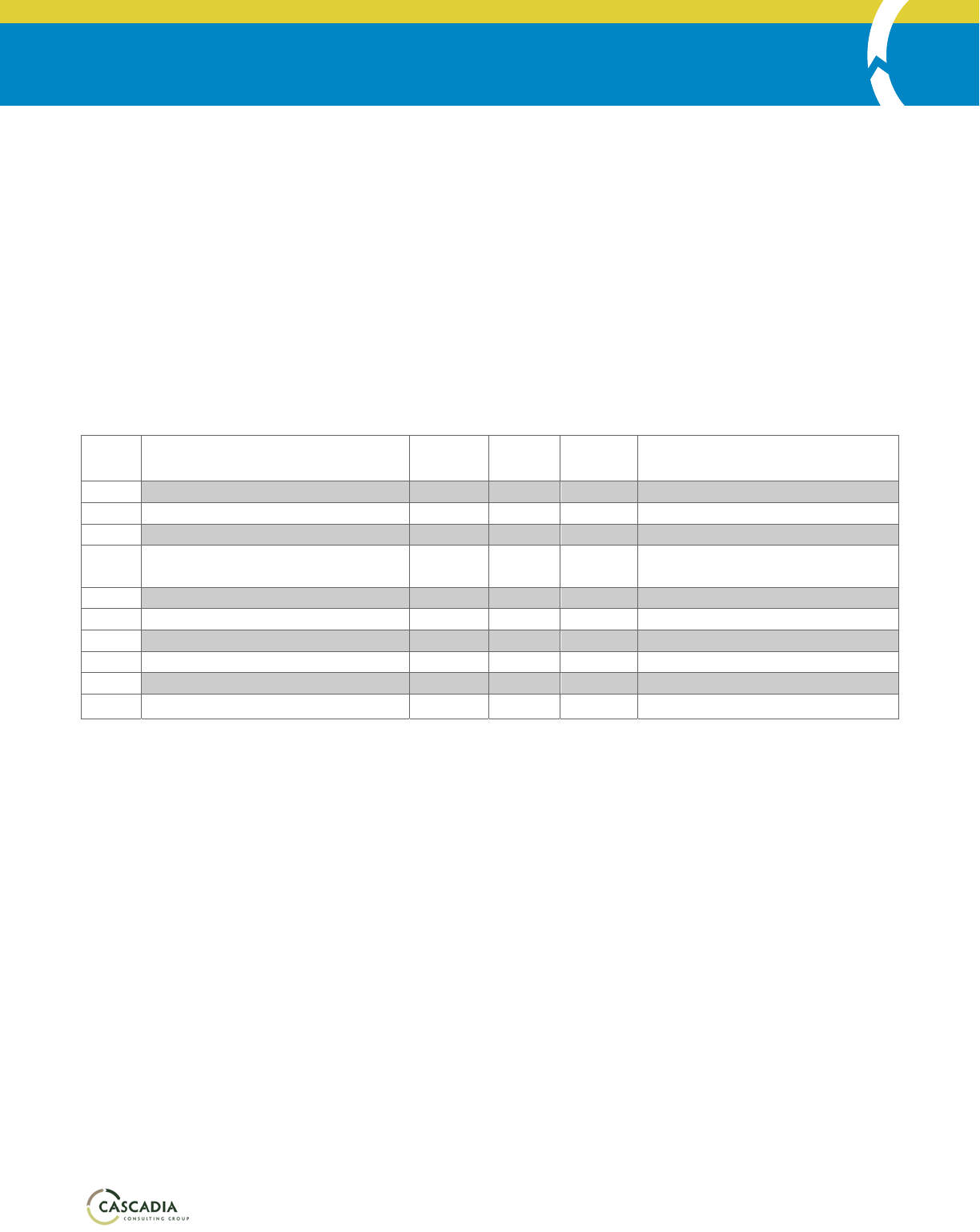
WASHINGTON STATE FOOD WASTE MANAGEMENT EVALUATION
62
Source4:__________________________ __________
i. Whatpounds(or%)offoodcomesfromthissource?____________________________________
ii. Overwhattimeframe–perweek,month,year,etc.?__________________ ___________________
iii. Whattype(s)offoodcomefromthissource?
_______________________________________________________________ ____________
iv. Howdoyouhandlefoodfromthissource?_____________________________________________
5. Isfoodhandled
thesamewayfromallsources,ordoesfoodfromsomesourcesgetprocesseddifferently?
6. Destinations:Wheredoesthefoodgowhenyou’redonehandlingit?
Check
box
Destination Quantity
offood
Percent
offood
Time
frame
Notes
□
Mealsserved(mealprogram)
□
Foodgiventoclientsorcustomers
□
Otherfoodgivendirectlytopeople
□
Donated/senttoanotherfood
program
□
Compost(on‐site)
□
Compost(of
f
‐site)
□
Animalfeed
□
Anaerobicdigestion
□
Landfill
□
Other
7. Arethereanyotherwaysinwhichyoutrackthefooddonationsthatcomeintoandoutofyour
organization?
Capacity Questions
Next,I’mgoingtoasksomequestionsaboutyourcapacityandtheb arriersandopportunitiesforyourorganization
toexpandyourwork.Irecognizethatyourabilitytoprocess
ahighervolumeoffoodisnottheonlyimportant
factorhereandthatweneedtomaintainahighqualityoffoodandhighlevelofrespectforrecipients.Withthatin
mind…
8. Doestheamountoffooddonationsflowingthroughyourprogramrepresentthemaximumyoucanhandle
withyourcurrentresources?Whyorwhynot?
9. Doyouanticipateanyupcomingopportunitiestoincreaseyourcapacity,suchasnewfunding,specific
policies,oranythingelse?Ifso,whatarethey?
10. Whatfactorslimittheamountoffoodyoucandistributetoclientsorcustomers?
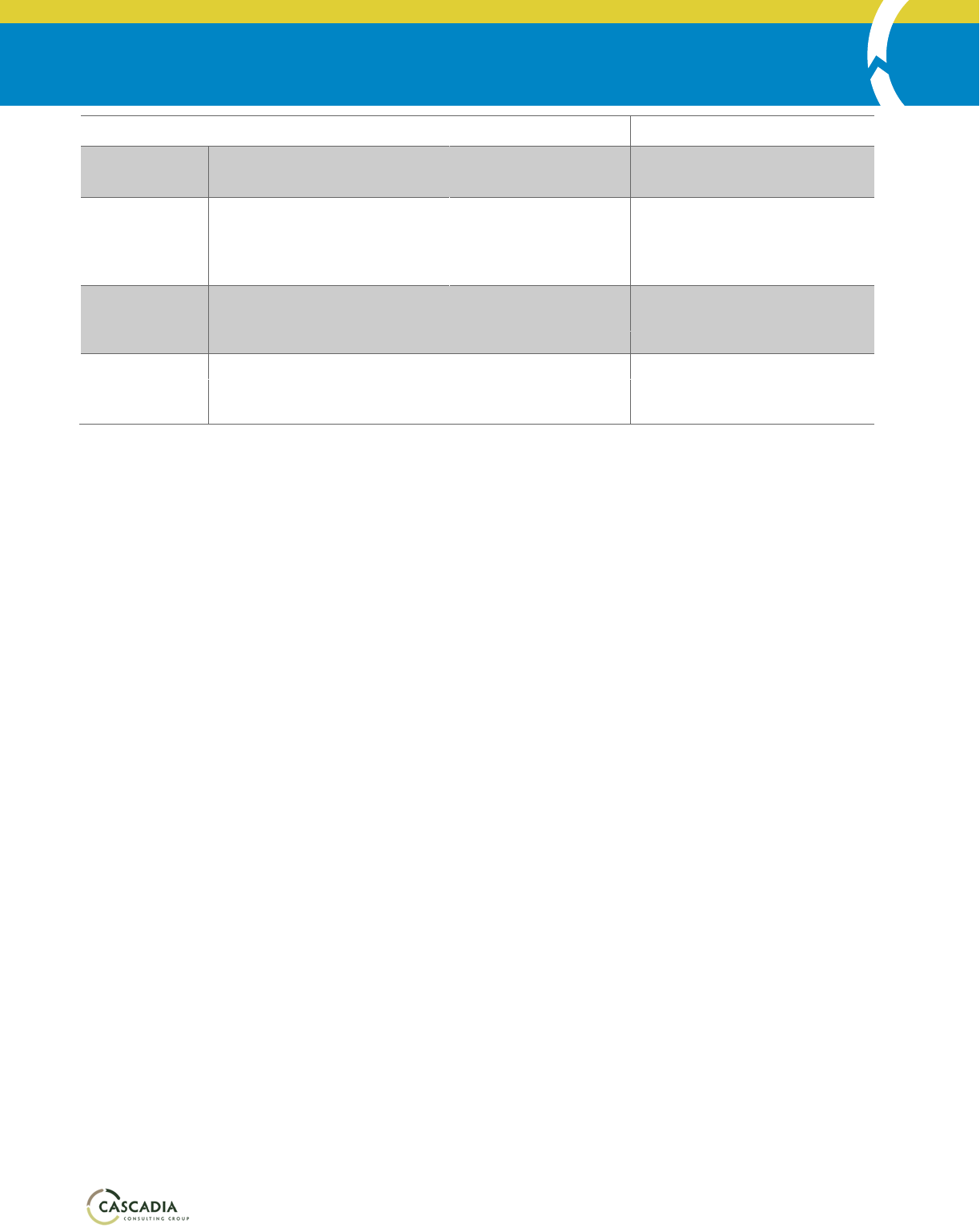
WASHINGTON STATE FOOD WASTE MANAGEMENT EVALUATION
63
Barriers Notes
Administrative □Schedulingdifficulties
□Stafftimeoncertaintasks
□Other
Limited
resources
□Funds
□Space–refrigerated
□Space–other
□Space–equipment
□Time
□Space–freezer
□Other
Staffing
challenges
□Highturnover
□Lowmotivation
□Trainingchallenges
□Other
□Relianceonvolunteers:inconsistency
Other
□Needformoreinformation □Other
□Needfordifferenttypeoffoods
□Needfordifferenttechnologyorequipment
11. Whichofthosefactorsarethemostsignificantforyou?
12. Ifyoucouldaskfor1or2thingsthatwouldenableyourorganizationtoexpandthevolumeoffood(waste)
youcanhandle,whatwouldtheybe?
13. Thegoalofthisinterviewistoprovidea
pictureofsurplusfoodandfoodwastemanagementsystemsto
informastateplantopreventandmanagefoodwaste.
Giventhatgoal,isthereanythingelseyouwouldliketosharewithus?

WASHINGTON STATE FOOD WASTE MANAGEMENT EVALUATION
64
Appendix C: Compost Facility Interview Guide
ThisinterviewguidereceivedrevisionsfromMaryHarrington(Ecology)inApril2020.Thegoalbehindcreatingthis
guidewastocollectinformationaboutthethreecoreresearchareasofthisevaluationfromallpermittedcompost
facilitiesprocessingfoodwaste(includingFood Processing Waste, Post‐consumer Food Waste, and Yard Debris/Food
Waste)inWashingtonState.Itwassenttocomposters
asanemailattachmenttobecompleteddigitally,withthe
optionofcallingthecontactinformationlistedbyphonetocompletethesurveyverbally.Cascadiapre-filledthe
previousyear’sreportingtotalsineachcategorywithinthesurvey.
Letter of Introduction
TheStateofWashingtonispreparingaWastedFoodReductionandFoodWaste
DiversionPlan.Aspartofthis
evaluation,we’rereachingouttodifferenttypesofbusinessesandorganizationsthatmanagefoodafteritsprimary
intendedconsumptionpoint.Theseincludehungerrelieforganizations,anaerobicdigestersandotherindustrial
processors,compostfacilities,andanimalfeedoperations.
We’restudyingthreemainareastobuild
apictureofthestate’sfoodwastemanagementsystem:
FlowofFood:Howmuchfoodwasteiscurrentlyflowingthroughfacilitiesinthefoodmanagementsystem,
includingcompostfacilities?
Metrics&Protocols:Whatisbeingmeasuredandhowisitbeingmeasured?Whatopportunitiesexistto
harmonizemetrics
andprotocolsacrossthesystem?
SystemCapacity:Whatistheavailablecapacityofeachentity?Whatarethebarrierstoincreasingcapacity
ofeachentity?
Participatinginthisstudyisvoluntary.Thestudyteamwillnotpublishyourfacility’snameoraddressoranystaff
namesinourreport.
Thereportwillbenefitstatedecision-makingaroundfoodwastemanagementplanning.
Ifyoucan,pleasehelpusbyfillingoutthesurveyonthefollowingpages.Itshouldonlytakeupto15minutesto
complete.Wecanalsoscheduleaphonecallsothatyoucantalkthroughyour
answersifyou’dlike.
Forquestionsand scheduling,pleasecontact<insertcontactinformation>.
Thankyou,
<insertsignatureblock>
Respondent Information
Name:
Position:
BusinessName:
BusinessLocation:
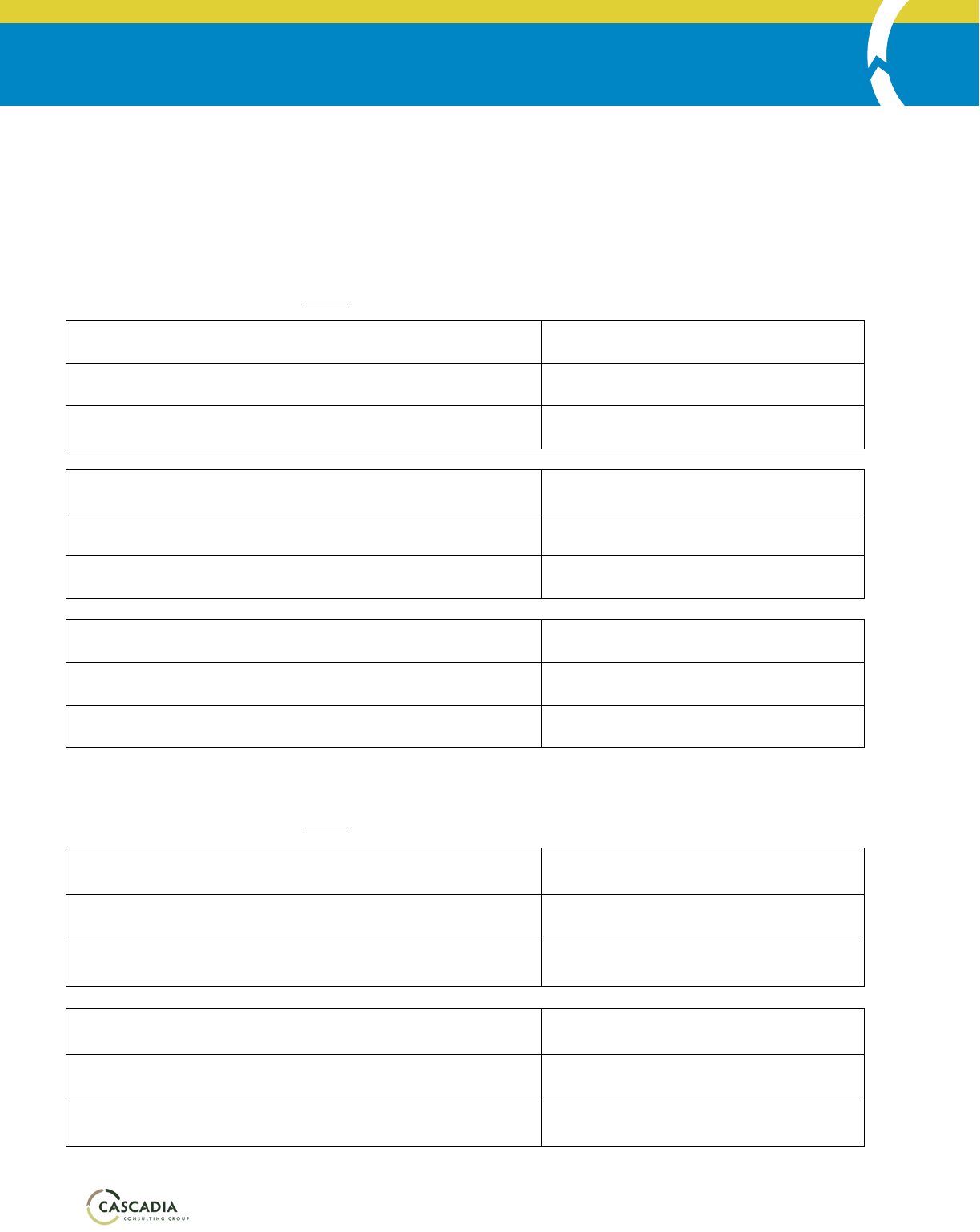
WASHINGTON STATE FOOD WASTE MANAGEMENT EVALUATION
65
Questions
1. Pleasefilloutthetablesbelow,whicharebasedonDepartmentofEcologyreportingcategories.
Whatarethesourcesofyourfoodwastefeedstocks(ex.foodprocessors,grocery,farms,curbside
collection)?
Food processing waste
In2018,yourfacilityreported:_____tonsoffoodprocessingwaste
Foodprocessingwastesource1:
Whatpercentoffoodprocessingwastecomesfromthissource? ____________%
Whattypesofitemsareinfeedstockfromthissource?
Foodprocessingwastesource2:
Whatpercentoffoodprocessingwastecomesfromthissource? ____________%
Whattypesofitemsareinfeedstockfromthissource?
Foodprocessingwastesource3:
Whatpercentoffoodprocessingwastecomesfromthissource? ____________%
Whattypesofitemsareinfeedstockfromthissource?
Post-consumer food waste
In2018,yourfacilityreported:_____tonsofpost-consumerfoodwaste
Post-consumerfoodwastesource1:
Whatpercentofpost-consumerfoodwastecomesfromthis
source?
____________%
Whattypesofitemsareinfeedstockfromthissource?
Post-consumerfoodwastesource2:
Whatpercentofpost-consumerfoodwastecomesfromthis
source?
____________%
Whattypesofitemsareinfeedstockfromthissource?
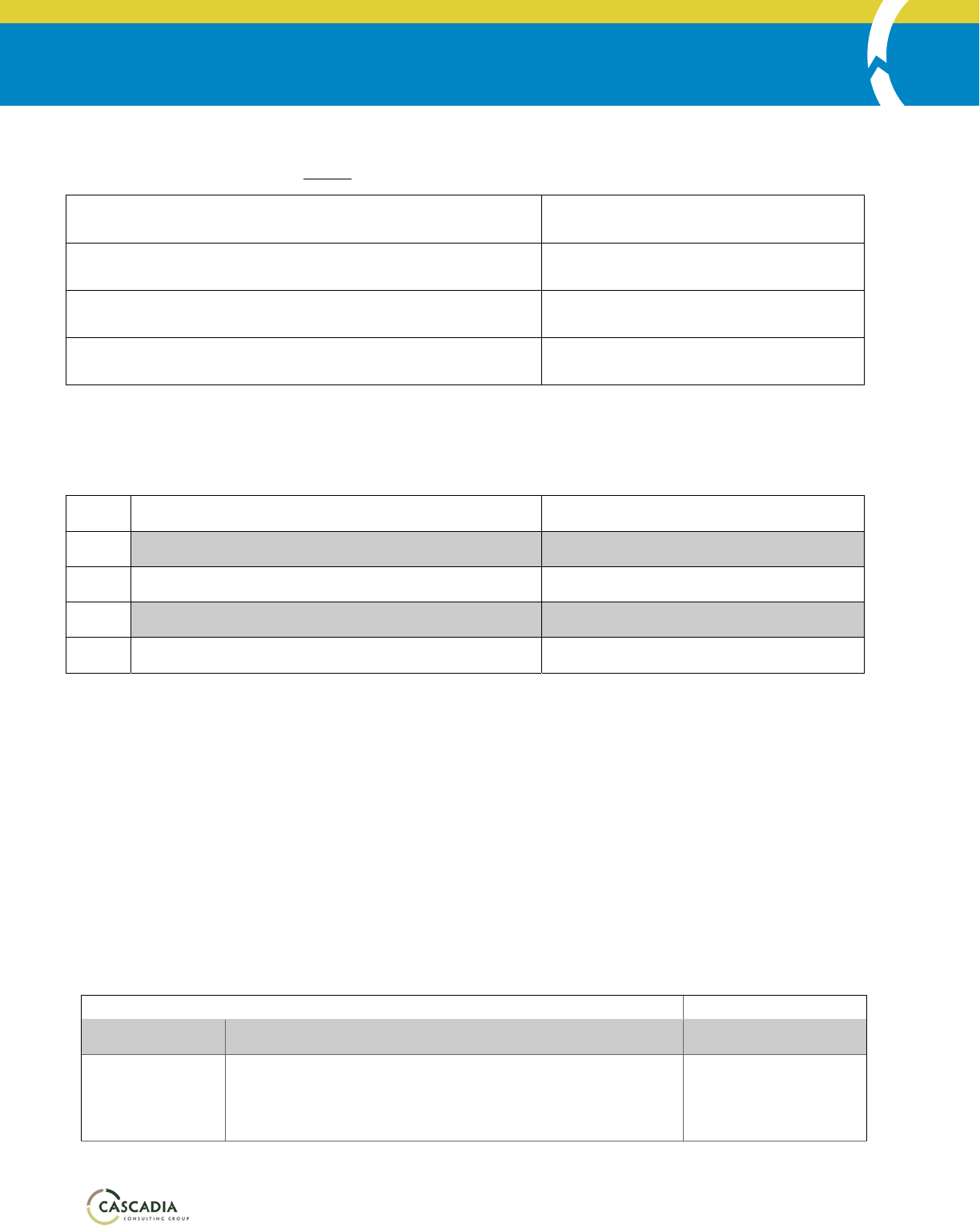
WASHINGTON STATE FOOD WASTE MANAGEMENT EVALUATION
66
Yard debris/food waste
In2018,yourfacilityreported:_____tonsofyarddebris/foodwaste
Yarddebris/foodwastesource1:
Whatpercentofyarddebris/foodwastecomesfromthis
source?
____________%
Whatpercentageofthiscategoryisyarddebrisvs.foodwaste? ______%yarddebris_____%foodwaste
Whatothertypesofitemsareinfeedstockfromthissource,if
any?
2. Whatqualitiesoffoodwastefeedstocksdoyoutrackatyourfacility ,ifany?Ex.levelofcontamination.
3. Whatareyourfacility’smainoutputs?
Check Typeofoutput Quantity/ %oftotaloutput
□ Finishedcompost
□ Mulch
□ Landfill:ADC
□ Other(pleasespecify)
Capacity Questions
4. Whatisyourfacility’spermittedcapacity?
5. Couldyourfacilityprocessmoretotalfeedstockthanitdoescurrently?
6. Couldyourfacilityprocessmorefoodscrapsthanitdoescurrently?
7. Doyouhaveanyplanstoexpandyourfacilityortobuildanewone?
8. Haveyou
consideredaddinganaerobicdigestionon-site?Whyorwhynot?
9. Whatfactorslimityourabilitytoprocessadditionalfoodscraps?
Barriers Notes
Regulatory □Solidwastepermingtoocostlytoobtain □Other
Economic
□Acquiringfeedstocksischallenging
□Compeonfromotherfacilies
□Hardtogetloansfornewequipment
□Other
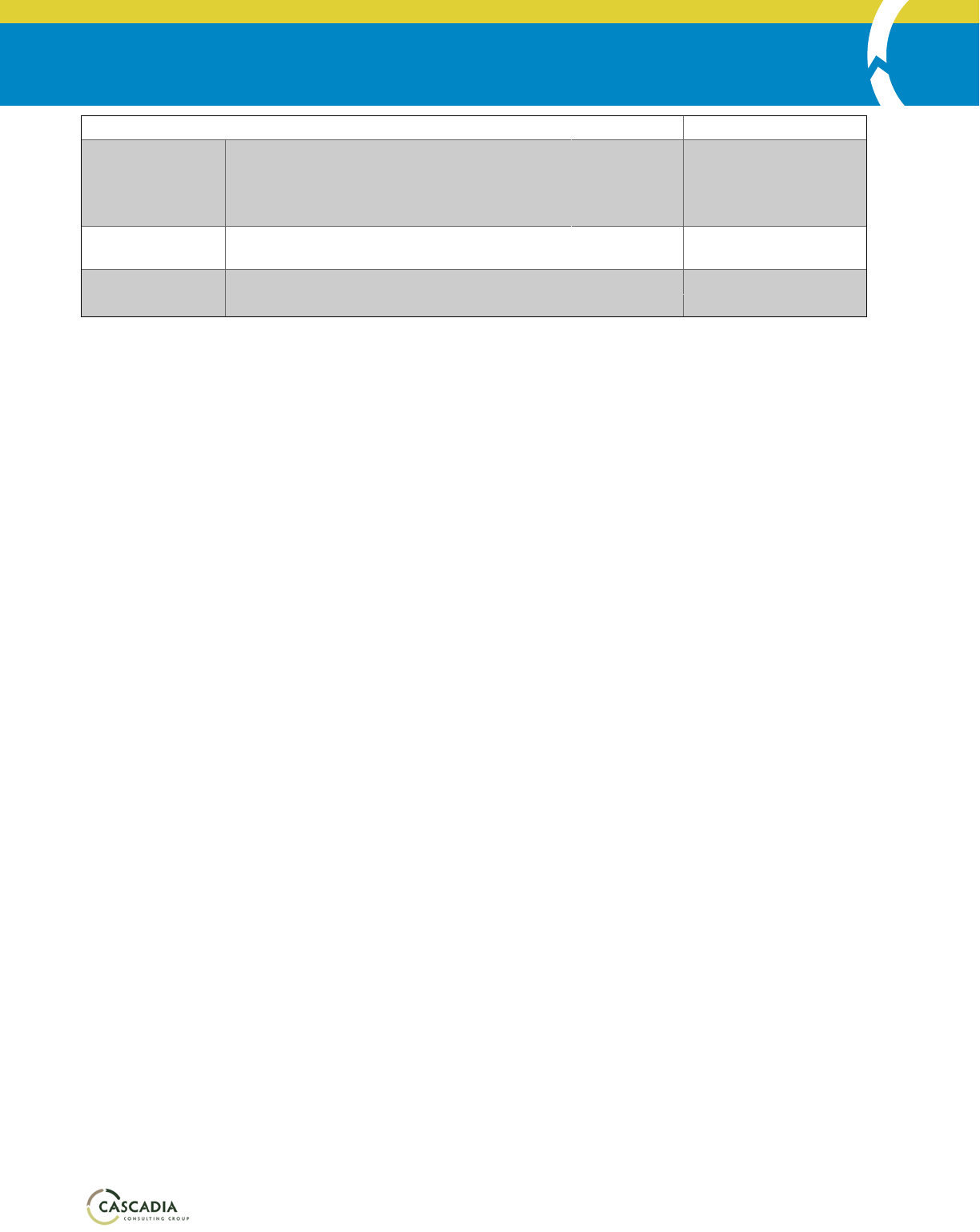
WASHINGTON STATE FOOD WASTE MANAGEMENT EVALUATION
67
Barriers Notes
Markets
□Needtoexpandmarkets
□Contaminatedfeedstocks
□Availabilityofcheapmulch
□Limitedmarketsforcontaminatedproducts
□Other
Landuse
□Noavailableland
□Costoflandtoohigh
□Other
Other
□Needfordifferenttypeoffeedstock
□Worriedaboutodor □Other
10. Whichofthosefactorsarethemostsignificantforyou?
11. Ifyoucouldwaveamagicwandan dwishfor1or2thingsthatwouldhelpyoubeabletohandlemorefood
wastefeedstocks,whatwouldtheybe,ifdifferentthanabove?
12. Thegoal
ofthisinterviewistoprovideapictureoffoodwastemanagementsystemstoinformastateplan
tomanagefoodwaste.
Giventhatgoal,isthereanythingelseyouwouldliketosharewithus?

WASHINGTON STATE FOOD WASTE MANAGEMENT EVALUATION
68
Appendix D: Compost Facility Survey Responses
Outof22facilitieswesentthesurveytoinApril2020,8responded.Theirresponsesarebelow.
Cedar Grove (Everett)

WASHINGTON STATE FOOD WASTE MANAGEMENT EVALUATION
69
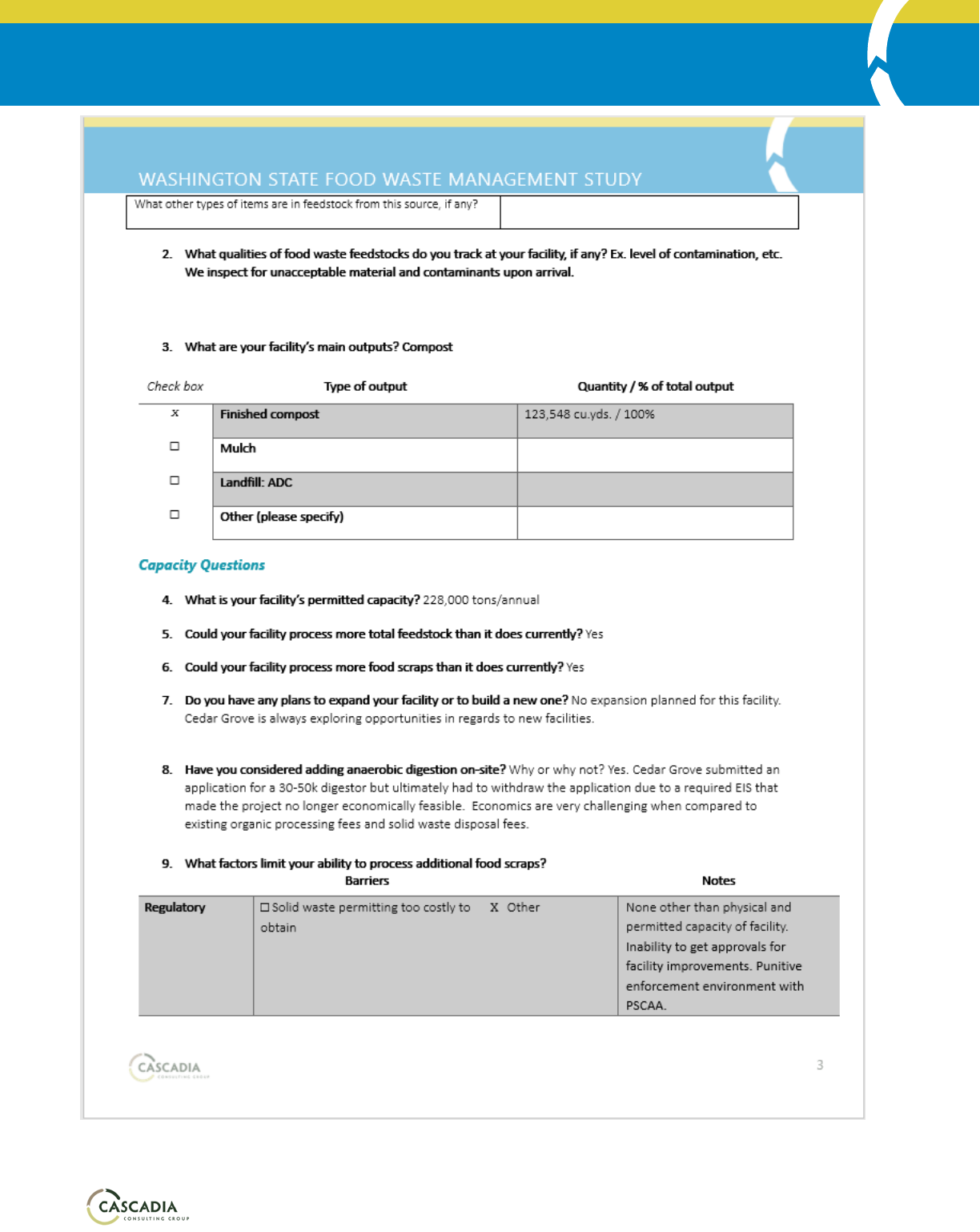
WASHINGTON STATE FOOD WASTE MANAGEMENT EVALUATION
70
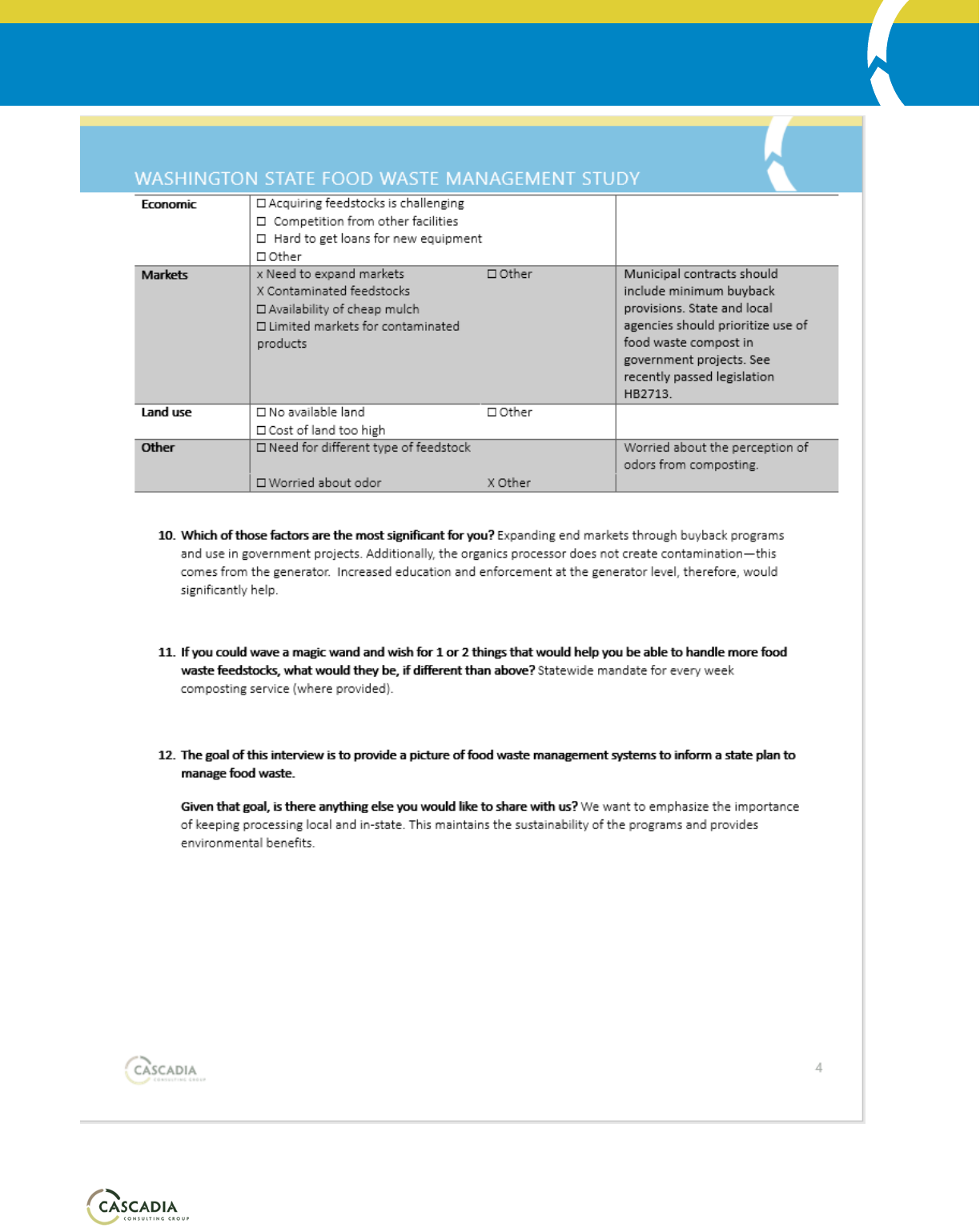
WASHINGTON STATE FOOD WASTE MANAGEMENT EVALUATION
71
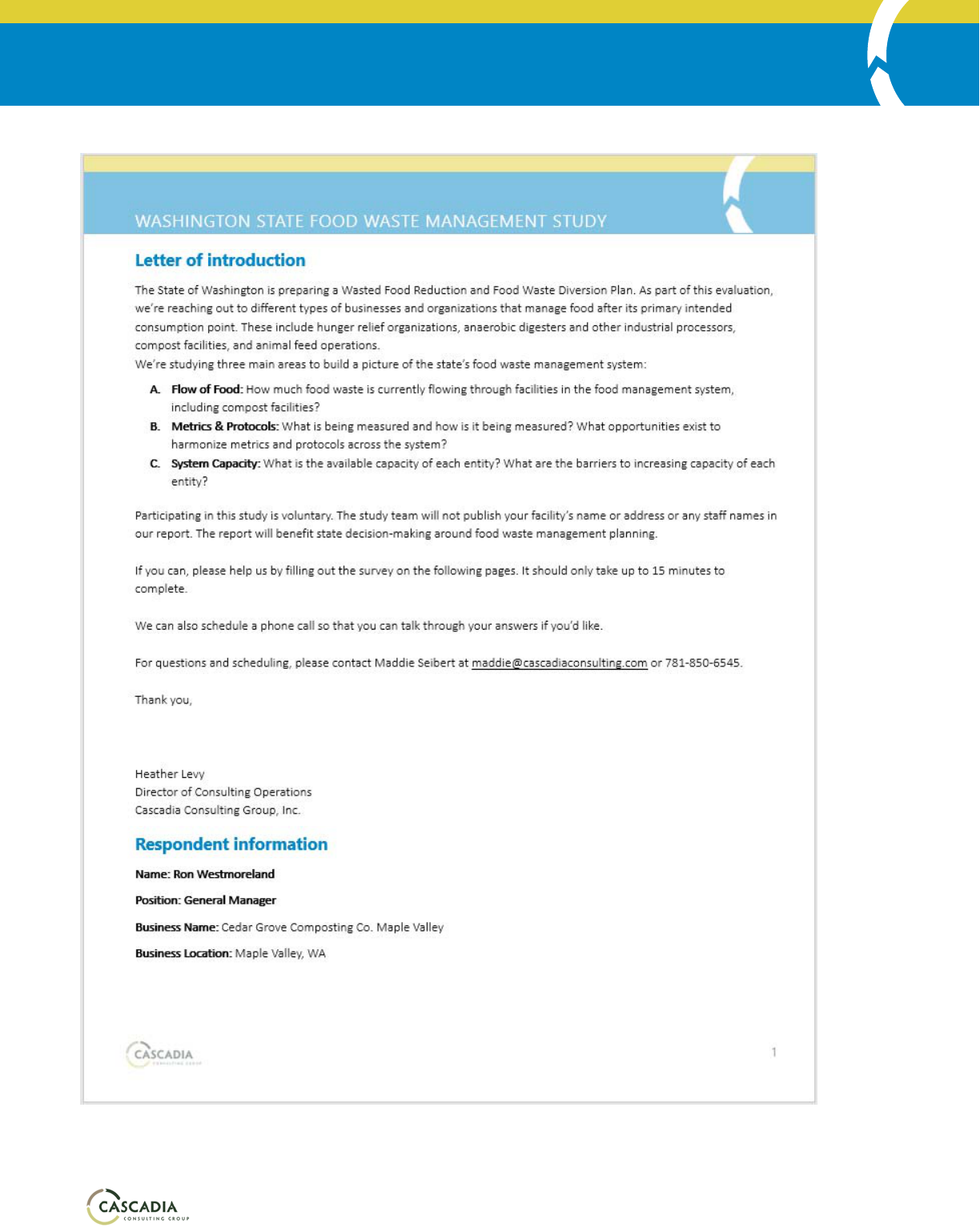
WASHINGTON STATE FOOD WASTE MANAGEMENT EVALUATION
72
Cedar Grove (Maple Valley)
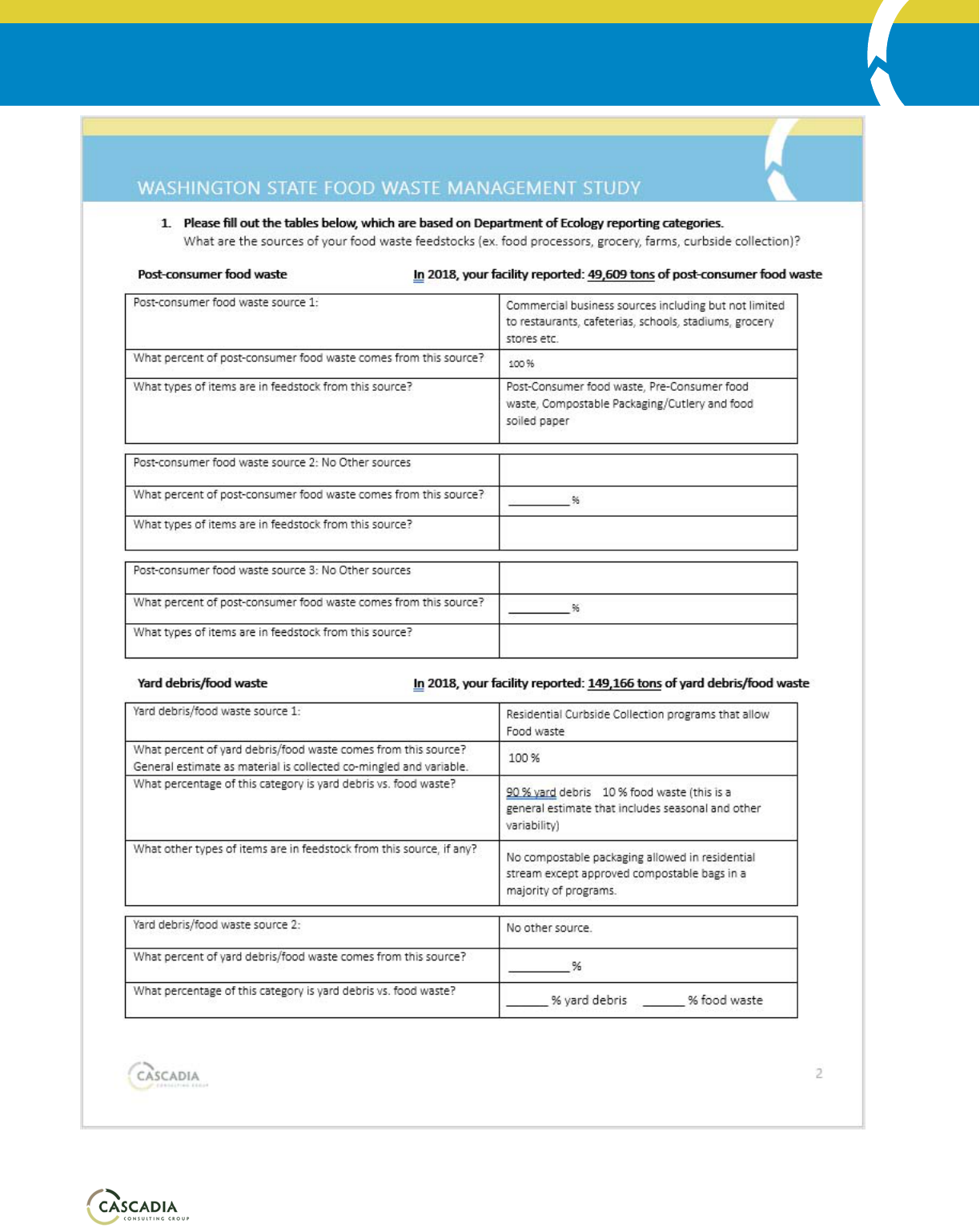
WASHINGTON STATE FOOD WASTE MANAGEMENT EVALUATION
73
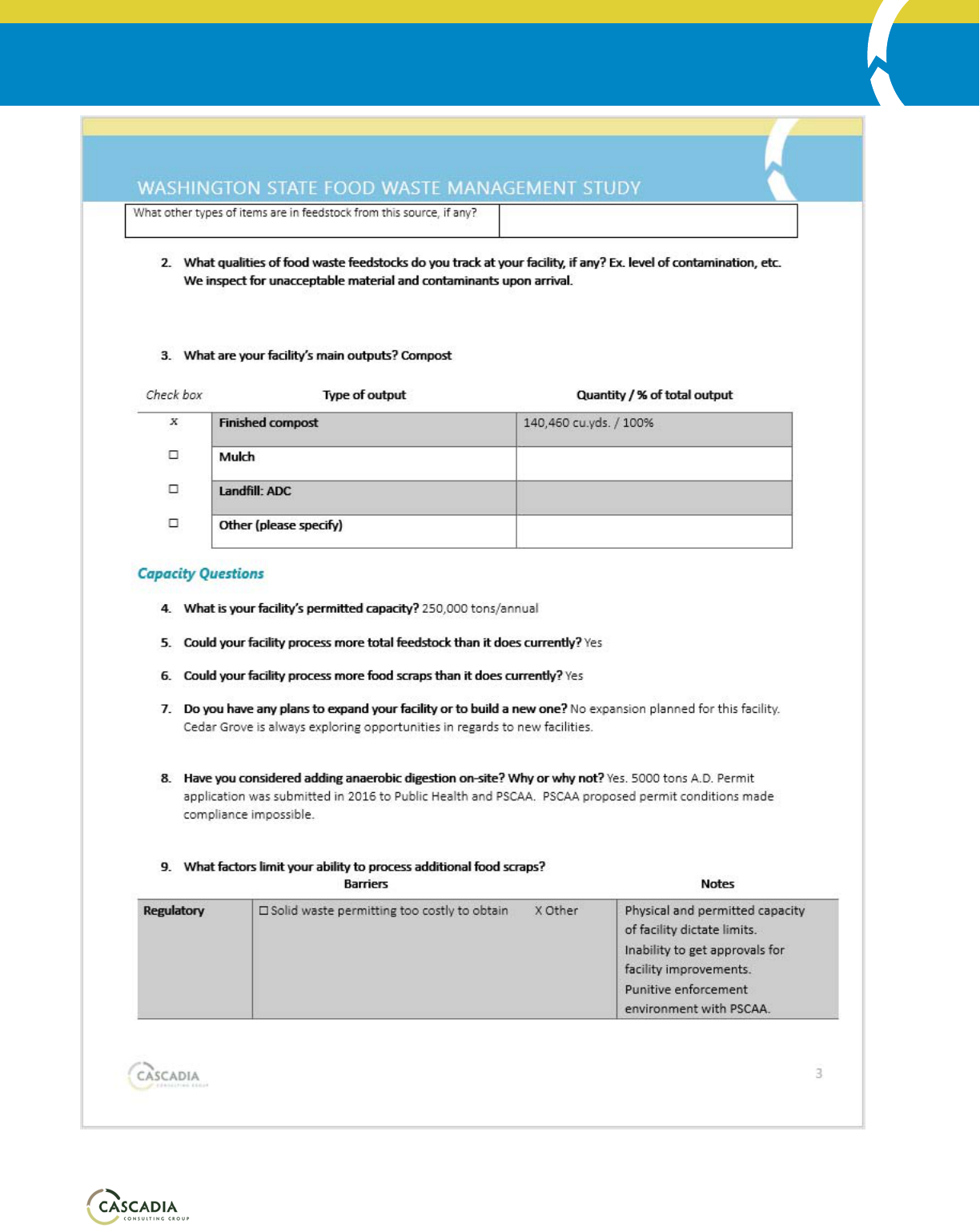
WASHINGTON STATE FOOD WASTE MANAGEMENT EVALUATION
74
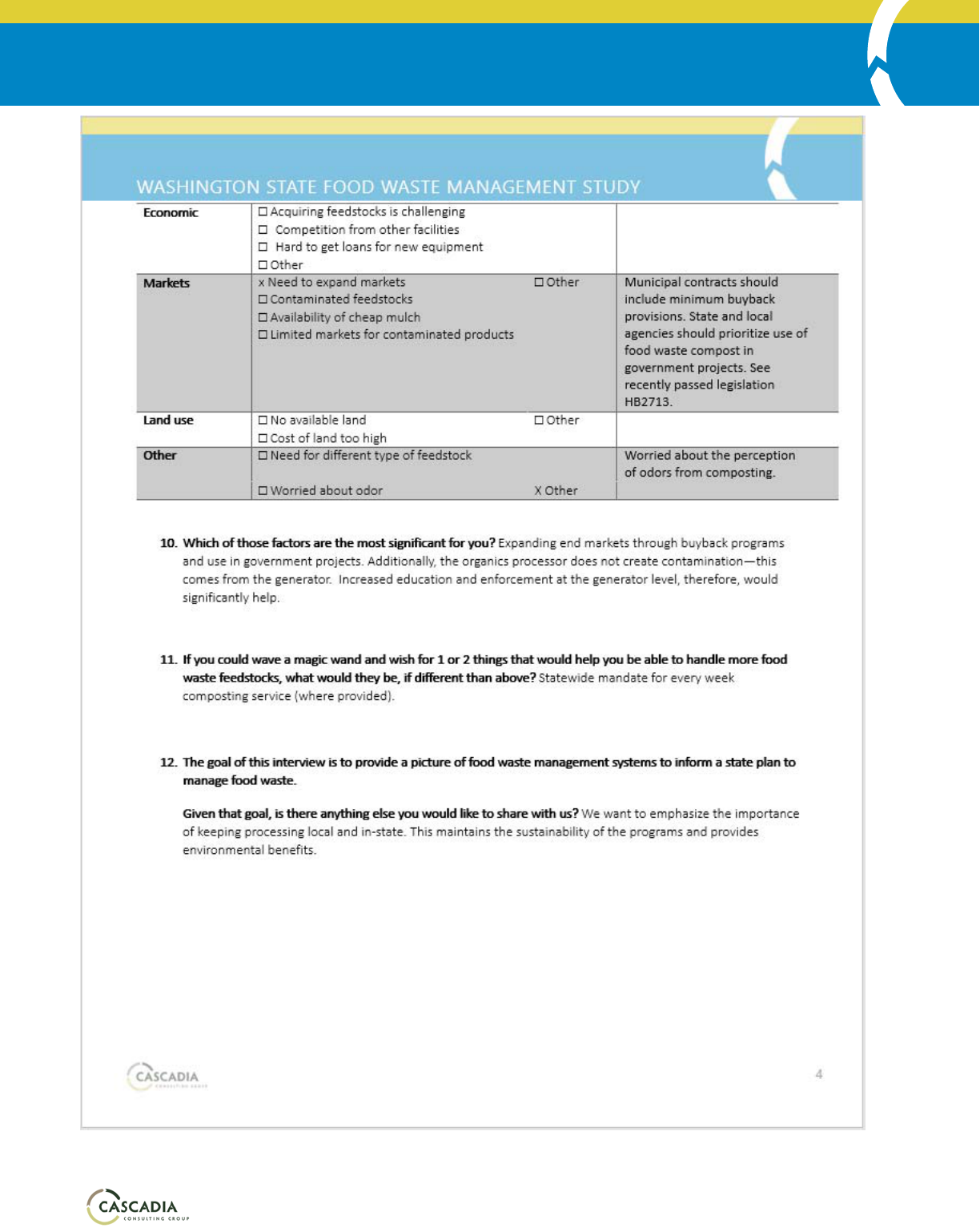
WASHINGTON STATE FOOD WASTE MANAGEMENT EVALUATION
75
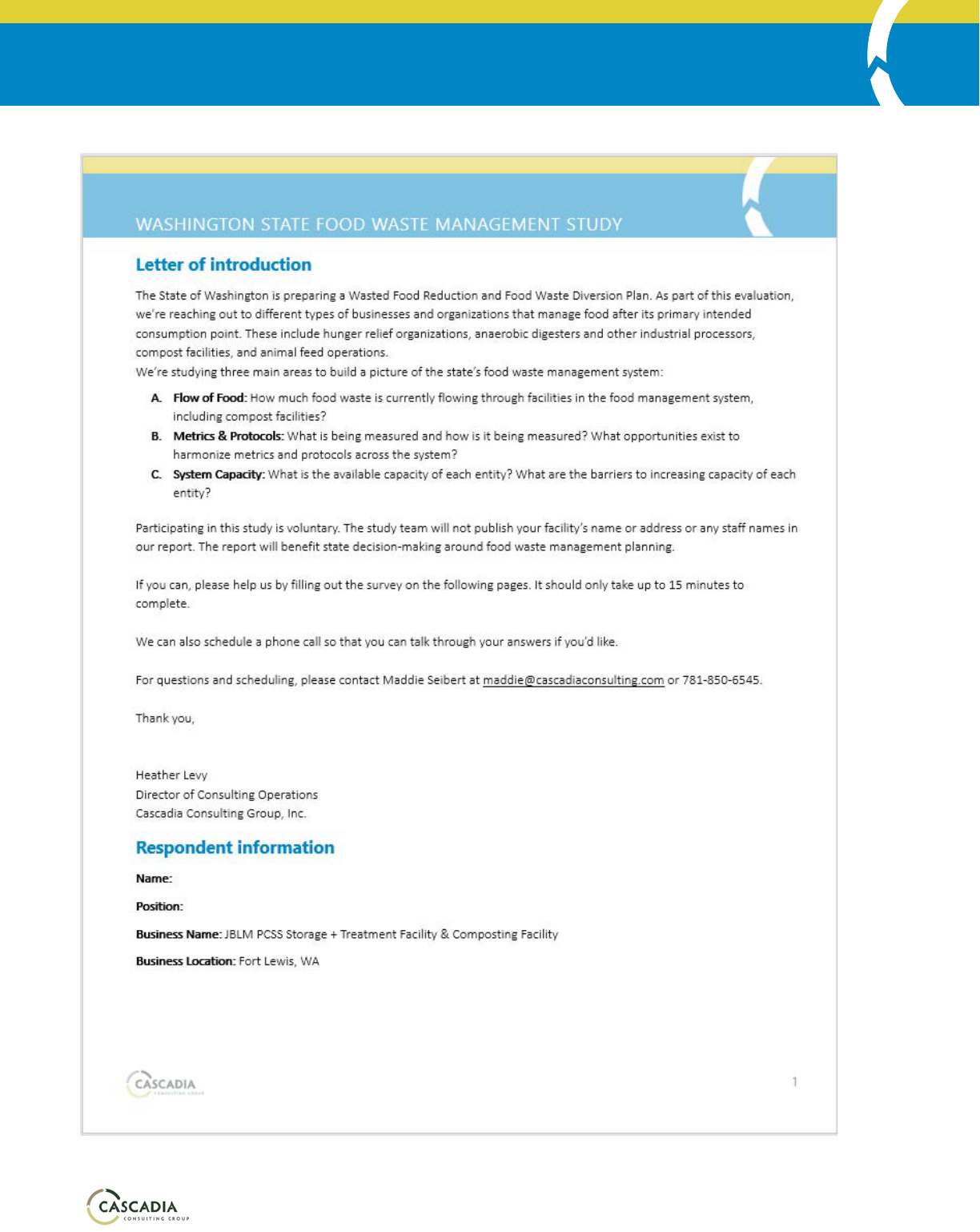
WASHINGTON STATE FOOD WASTE MANAGEMENT EVALUATION
76
JBLM Composting
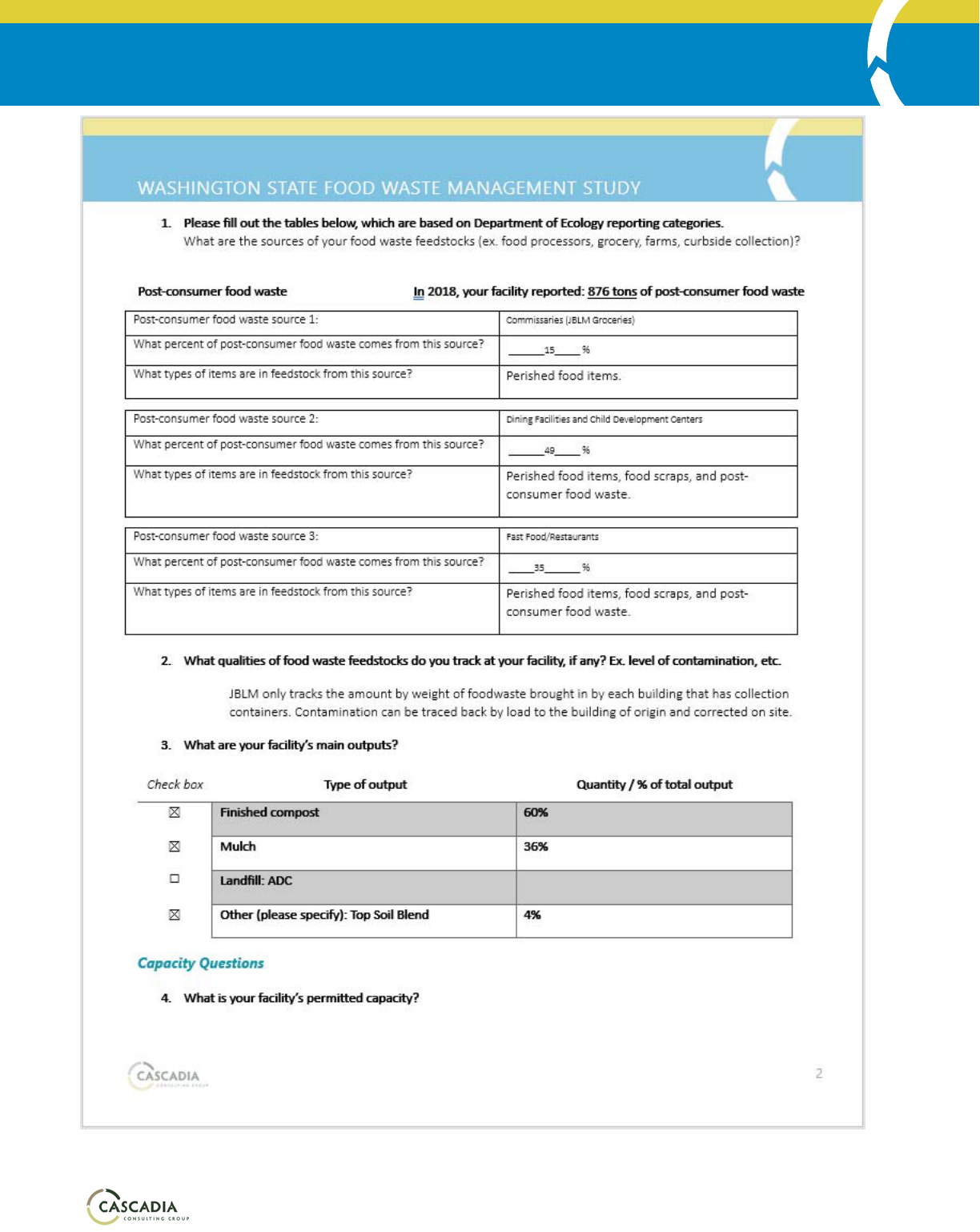
WASHINGTON STATE FOOD WASTE MANAGEMENT EVALUATION
77
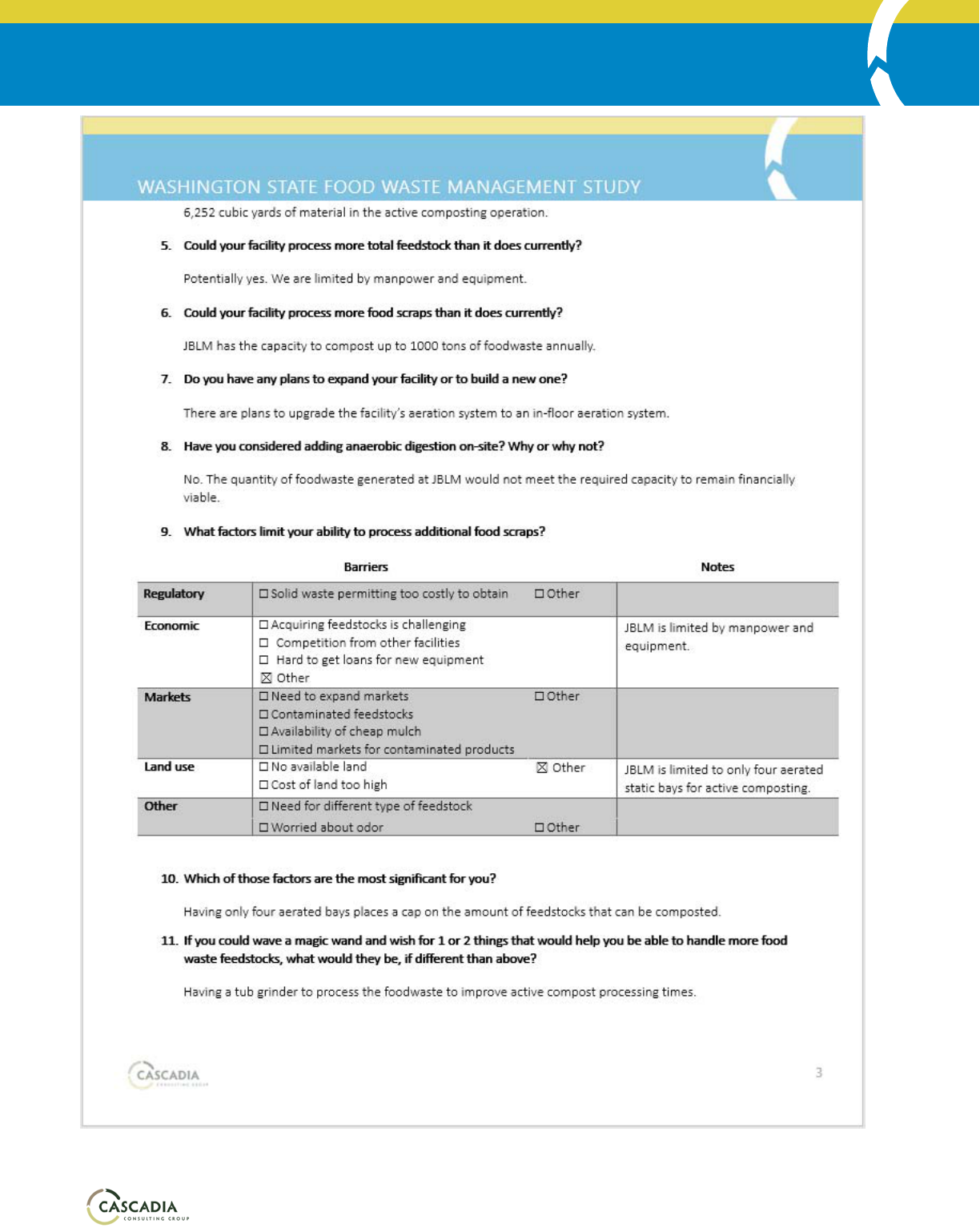
WASHINGTON STATE FOOD WASTE MANAGEMENT EVALUATION
78
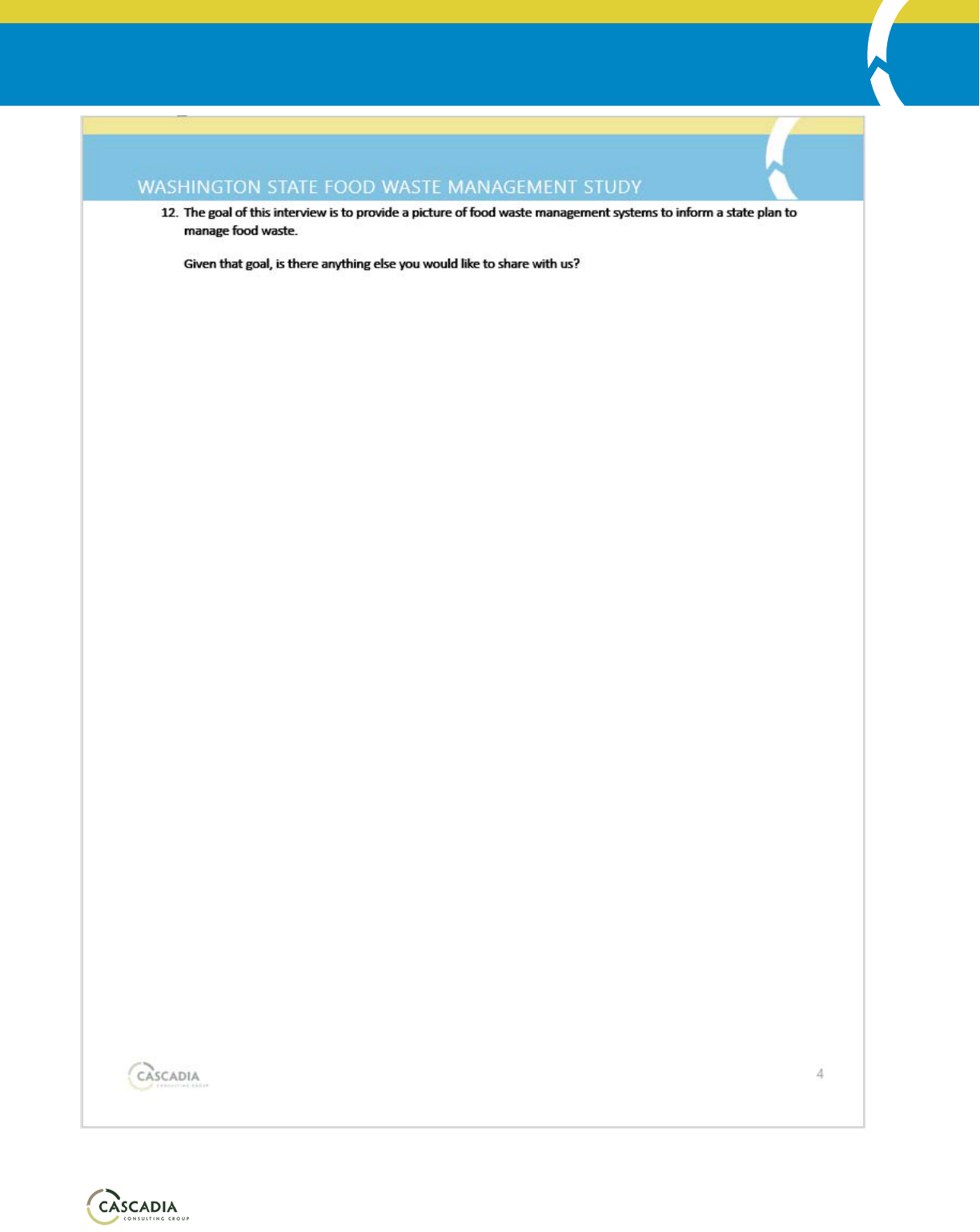
WASHINGTON STATE FOOD WASTE MANAGEMENT EVALUATION
79
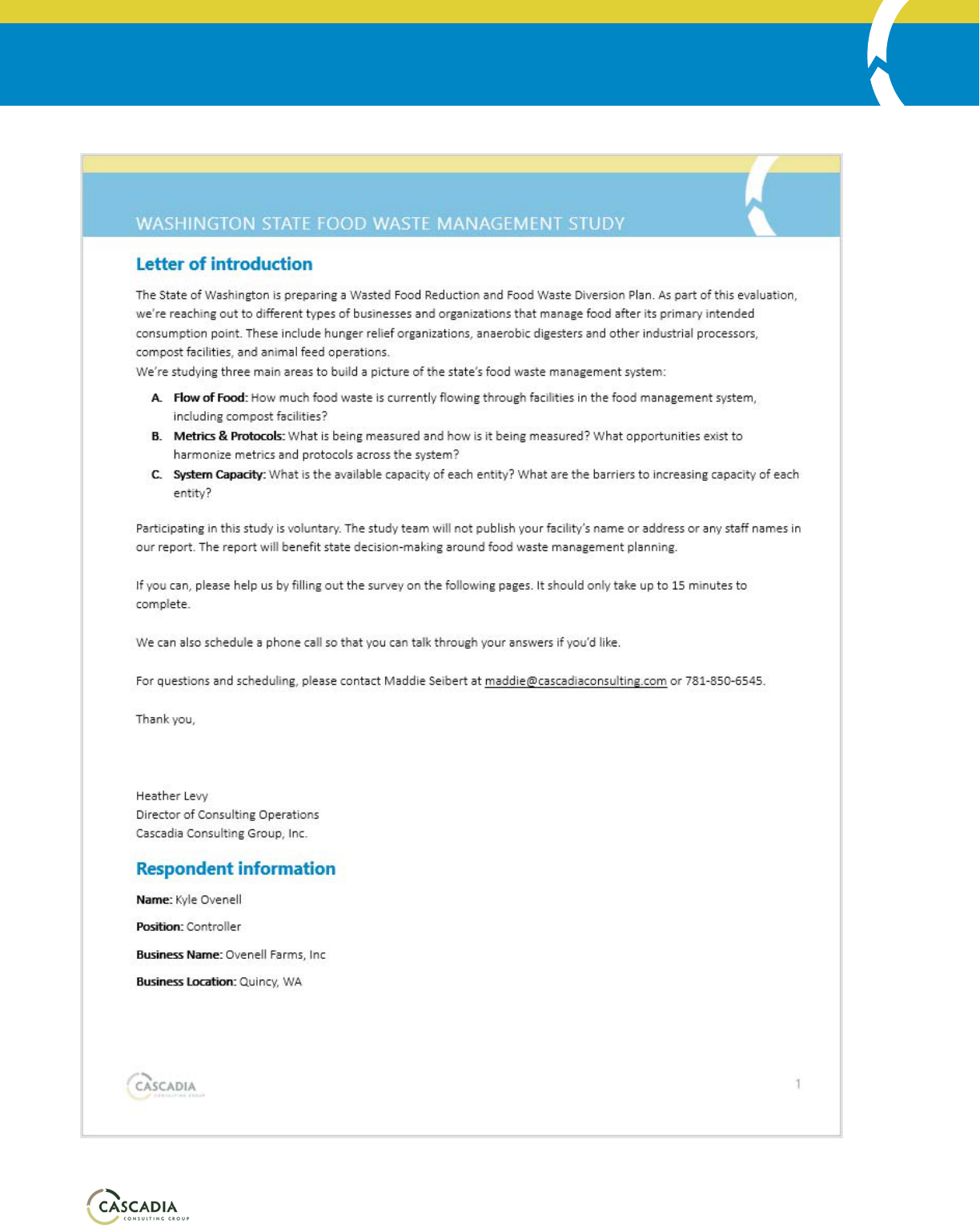
WASHINGTON STATE FOOD WASTE MANAGEMENT EVALUATION
80
Ovenell Farms
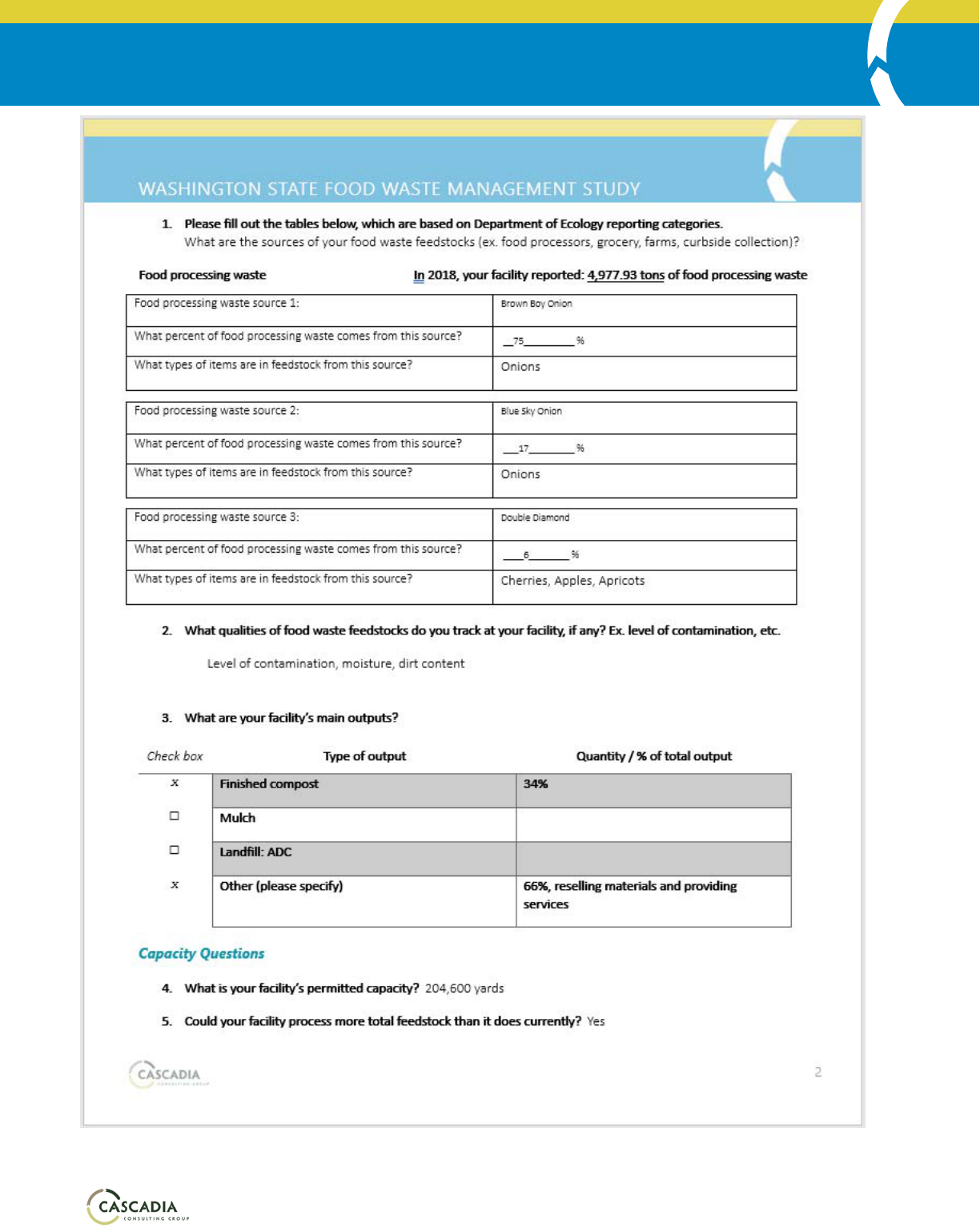
WASHINGTON STATE FOOD WASTE MANAGEMENT EVALUATION
81
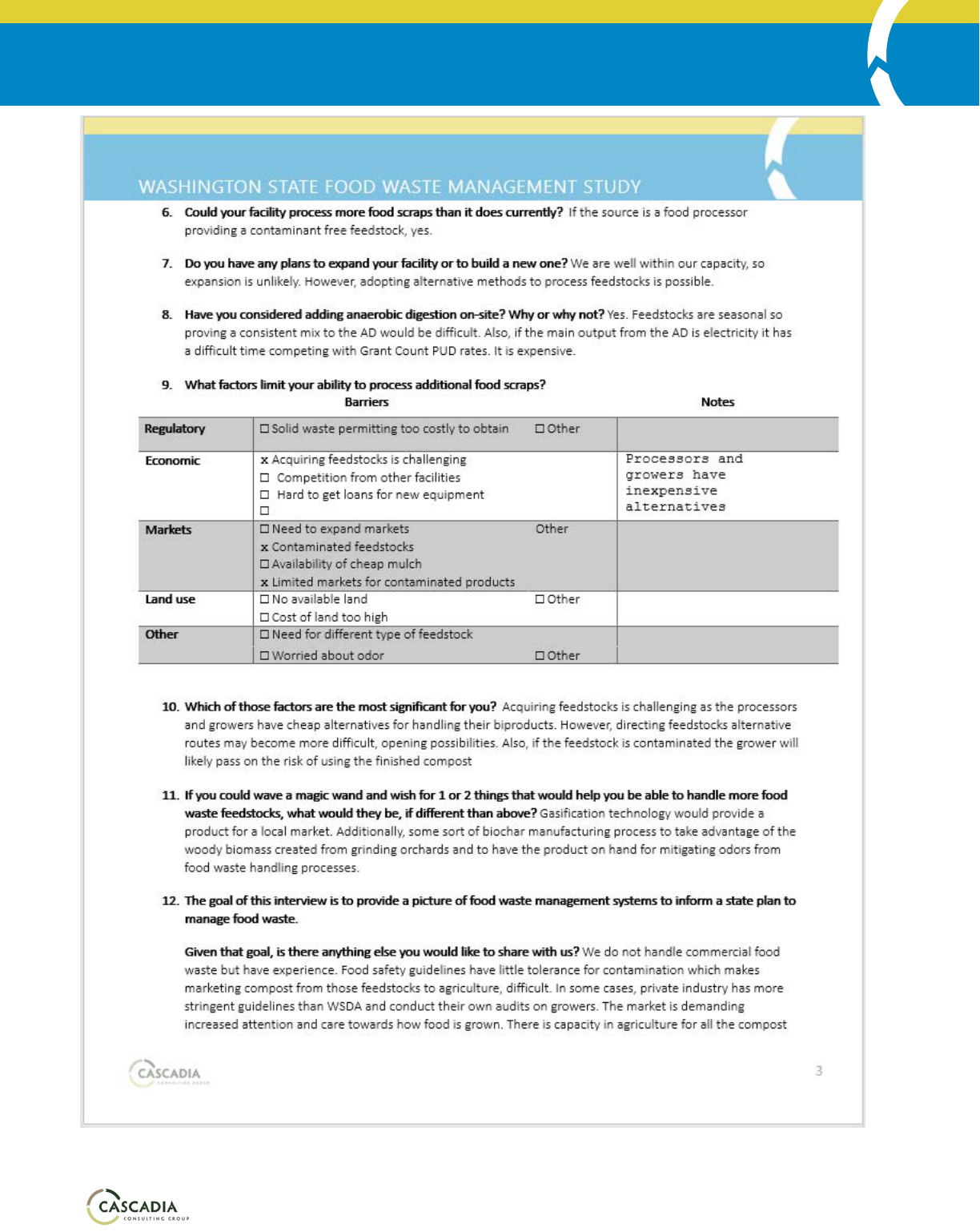
WASHINGTON STATE FOOD WASTE MANAGEMENT EVALUATION
82
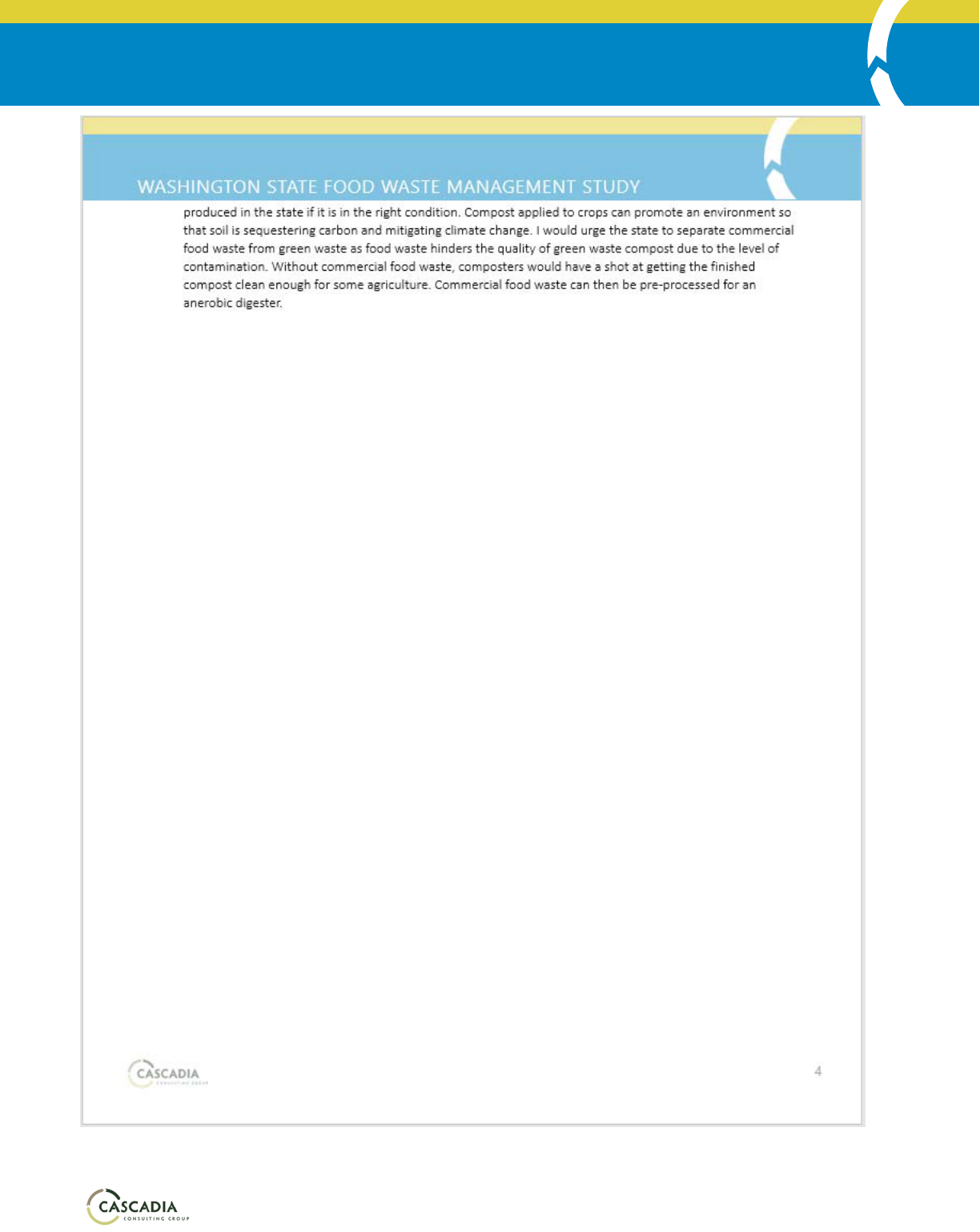
WASHINGTON STATE FOOD WASTE MANAGEMENT EVALUATION
83
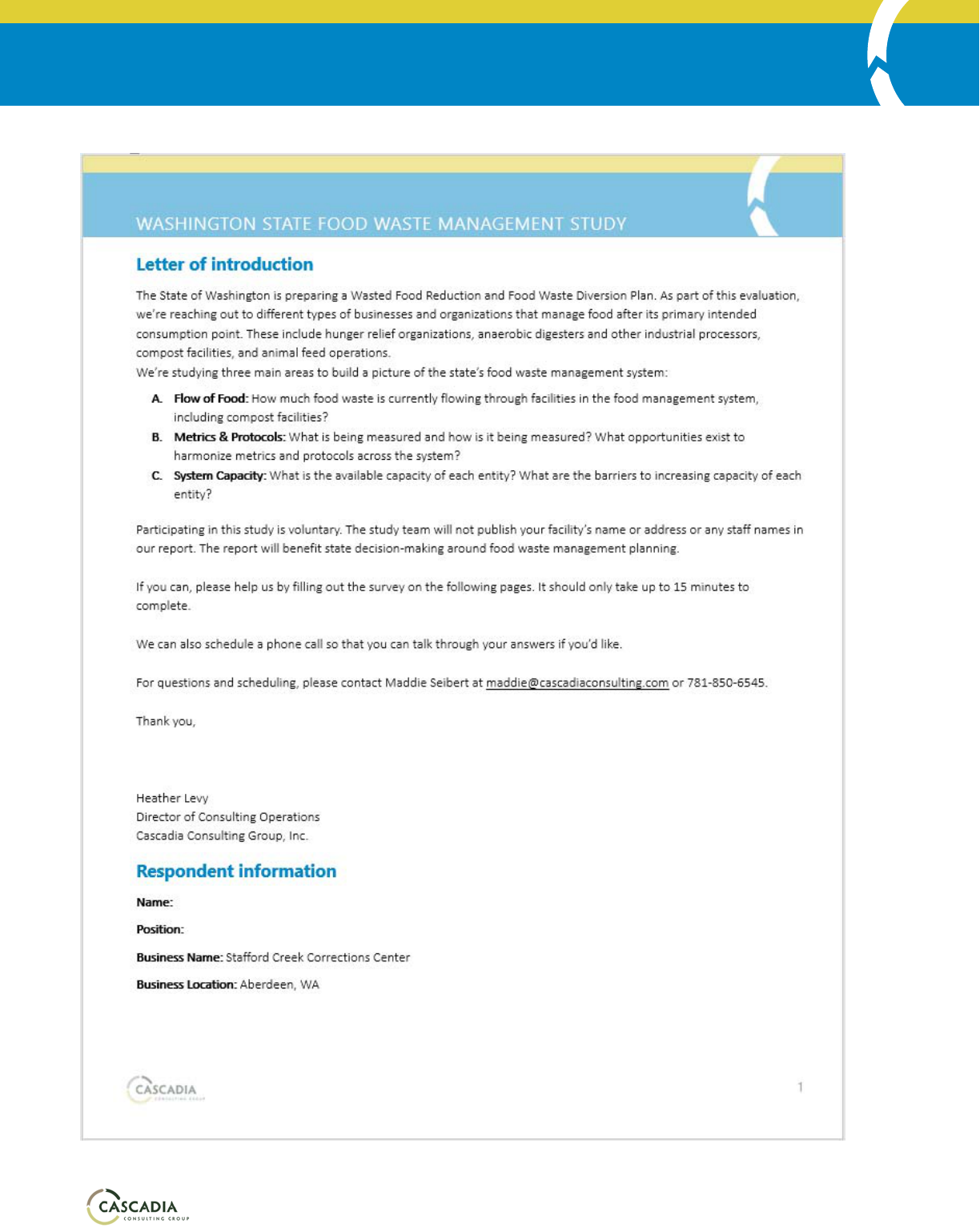
WASHINGTON STATE FOOD WASTE MANAGEMENT EVALUATION
84
Stafford Creek Corrections Center
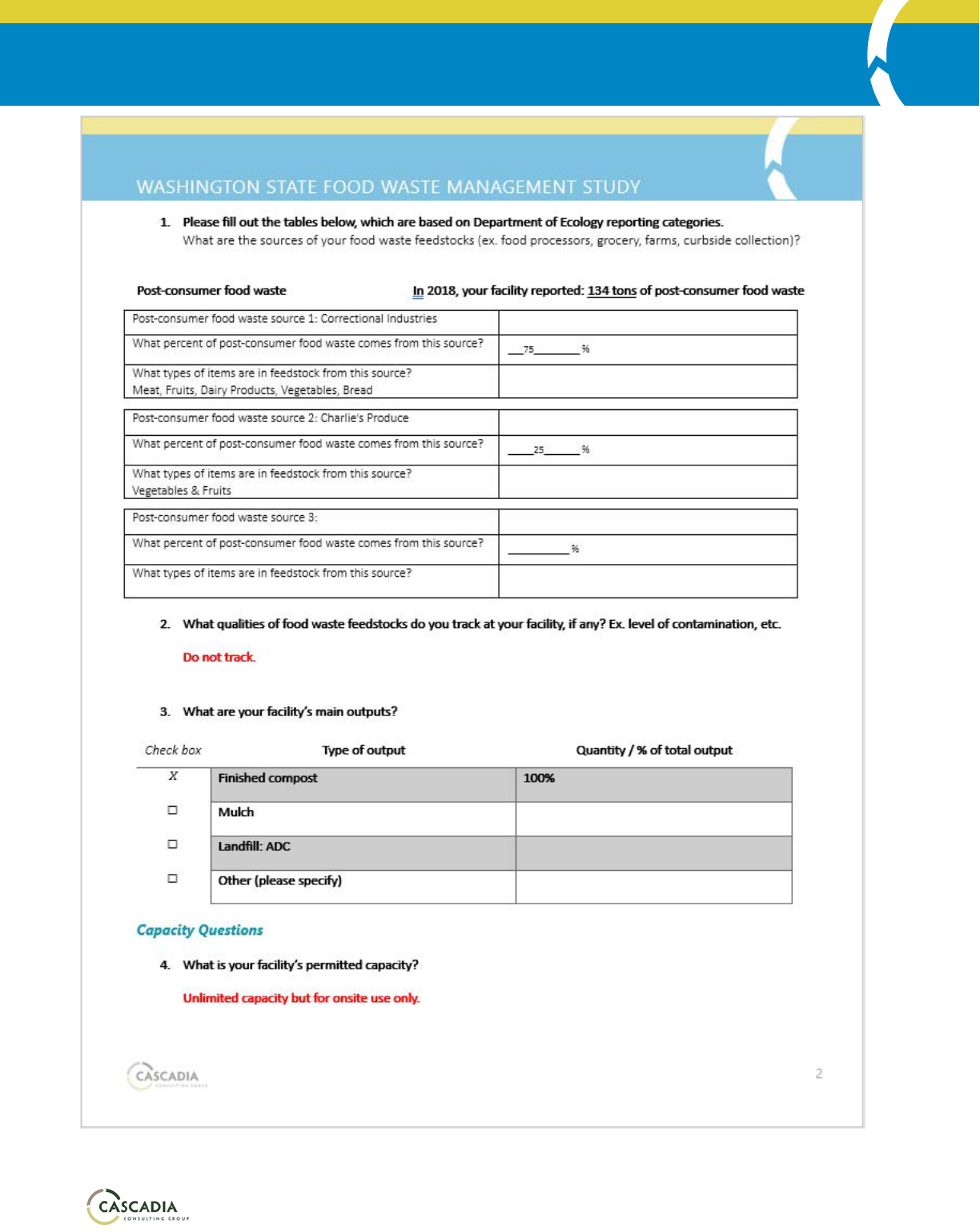
WASHINGTON STATE FOOD WASTE MANAGEMENT EVALUATION
85
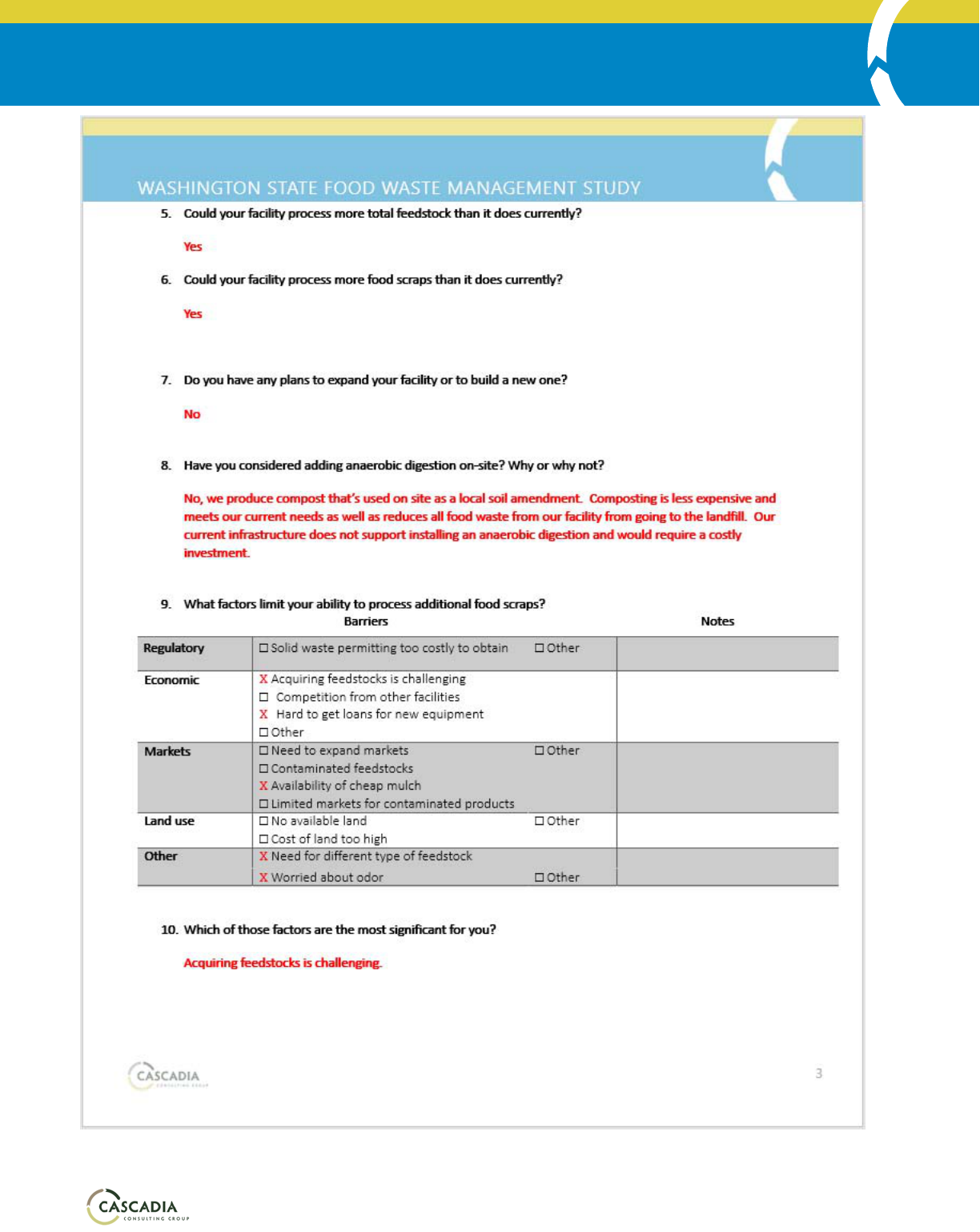
WASHINGTON STATE FOOD WASTE MANAGEMENT EVALUATION
86
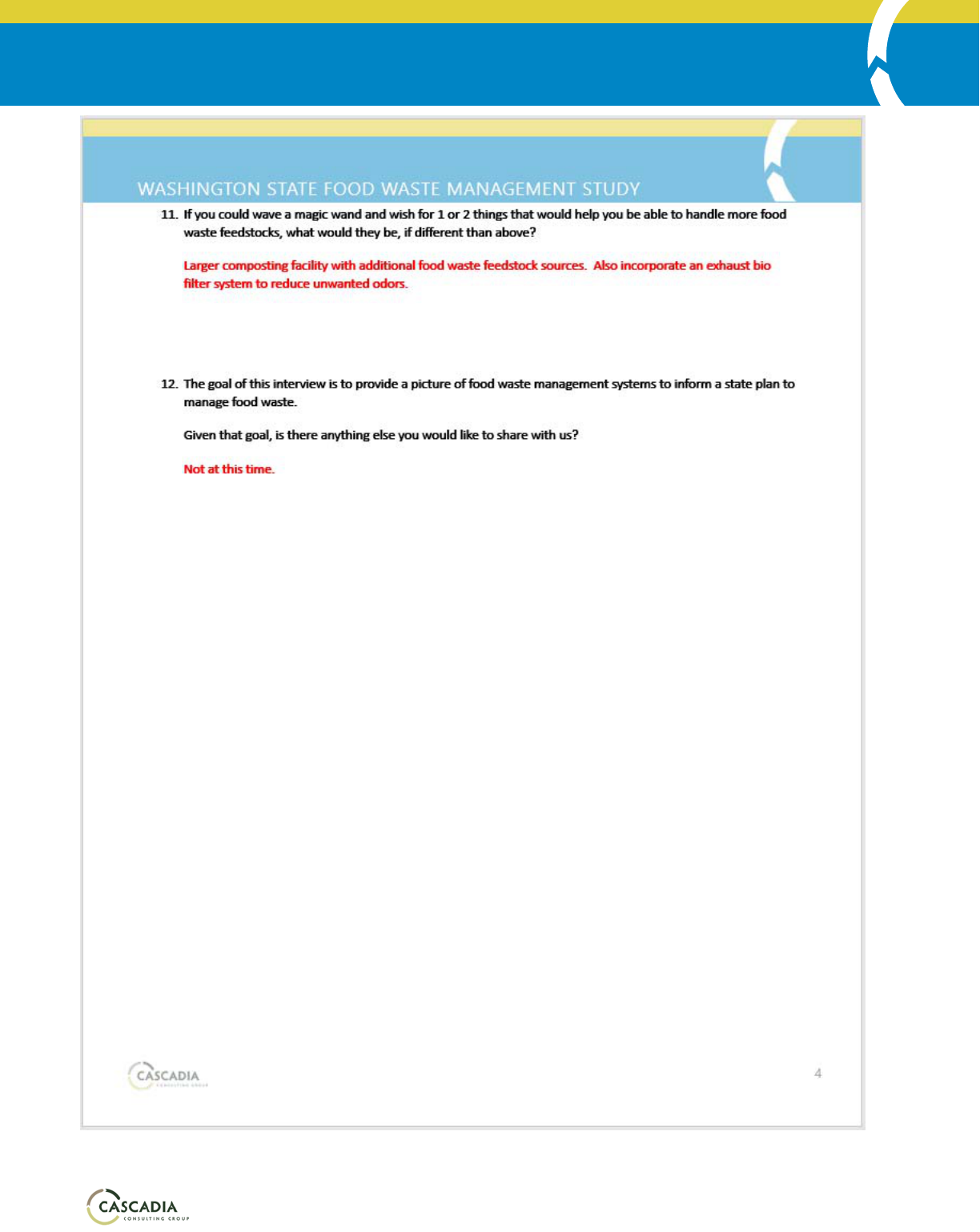
WASHINGTON STATE FOOD WASTE MANAGEMENT EVALUATION
87
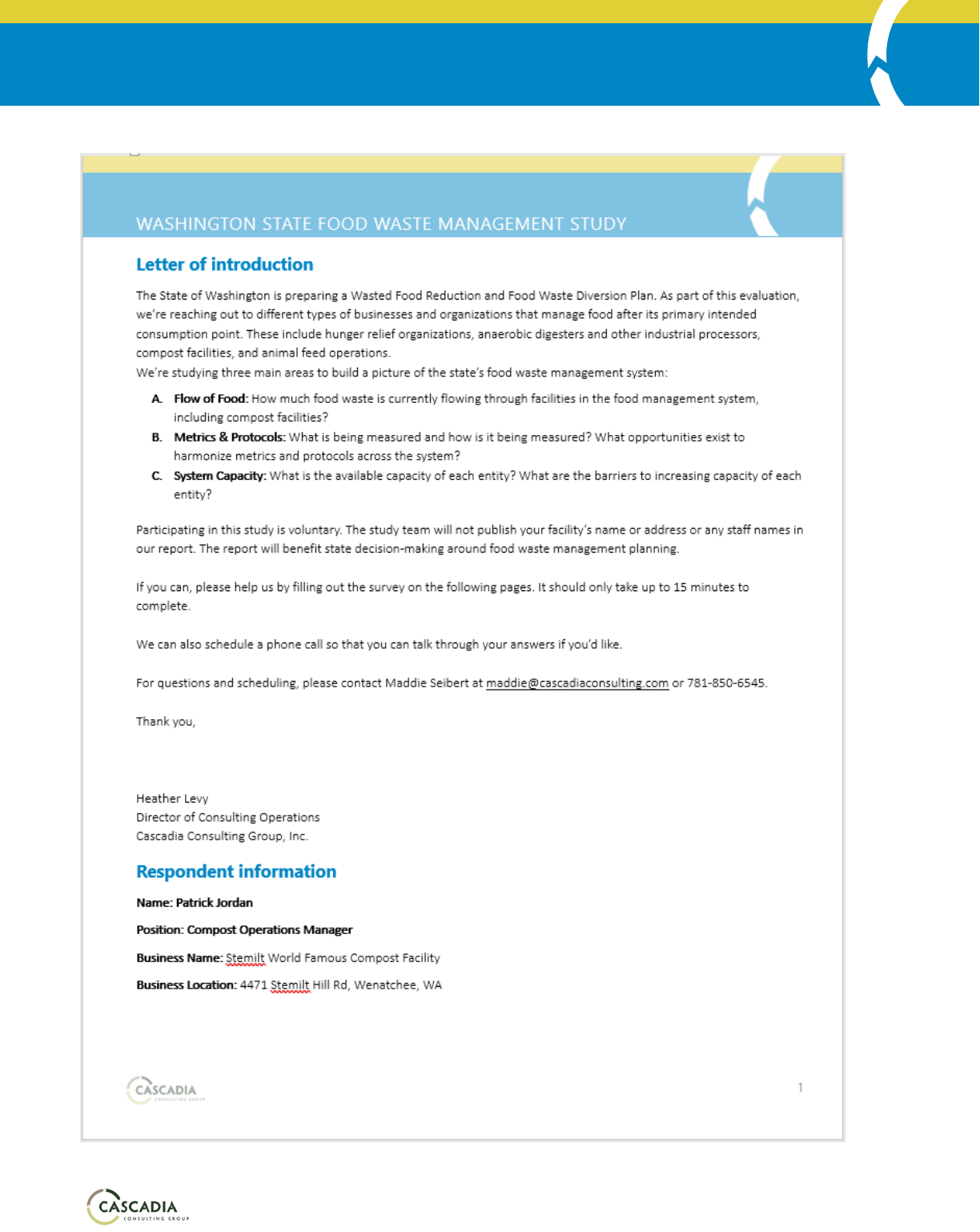
WASHINGTON STATE FOOD WASTE MANAGEMENT EVALUATION
88
Stemilt World Famous Compost Company
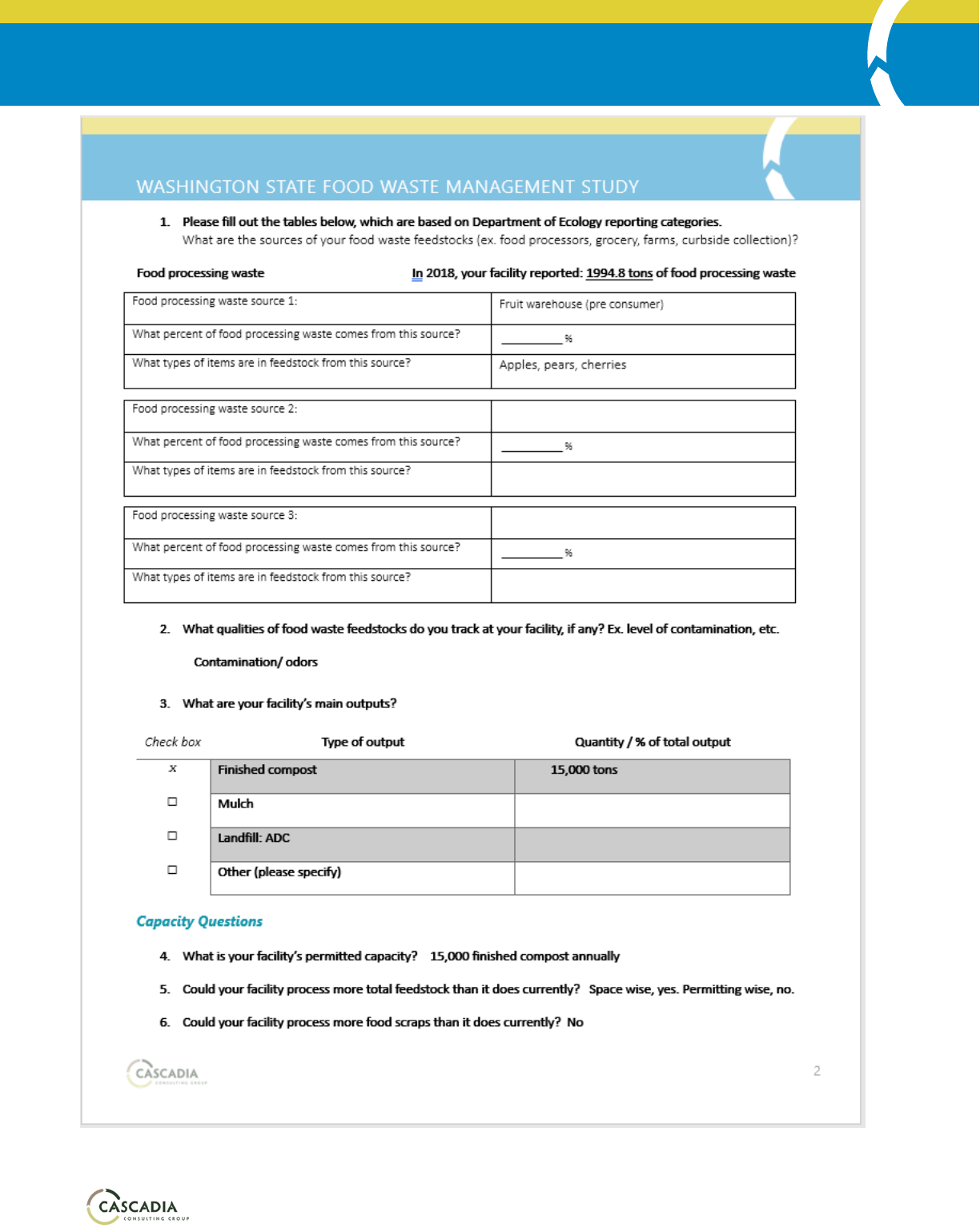
WASHINGTON STATE FOOD WASTE MANAGEMENT EVALUATION
89
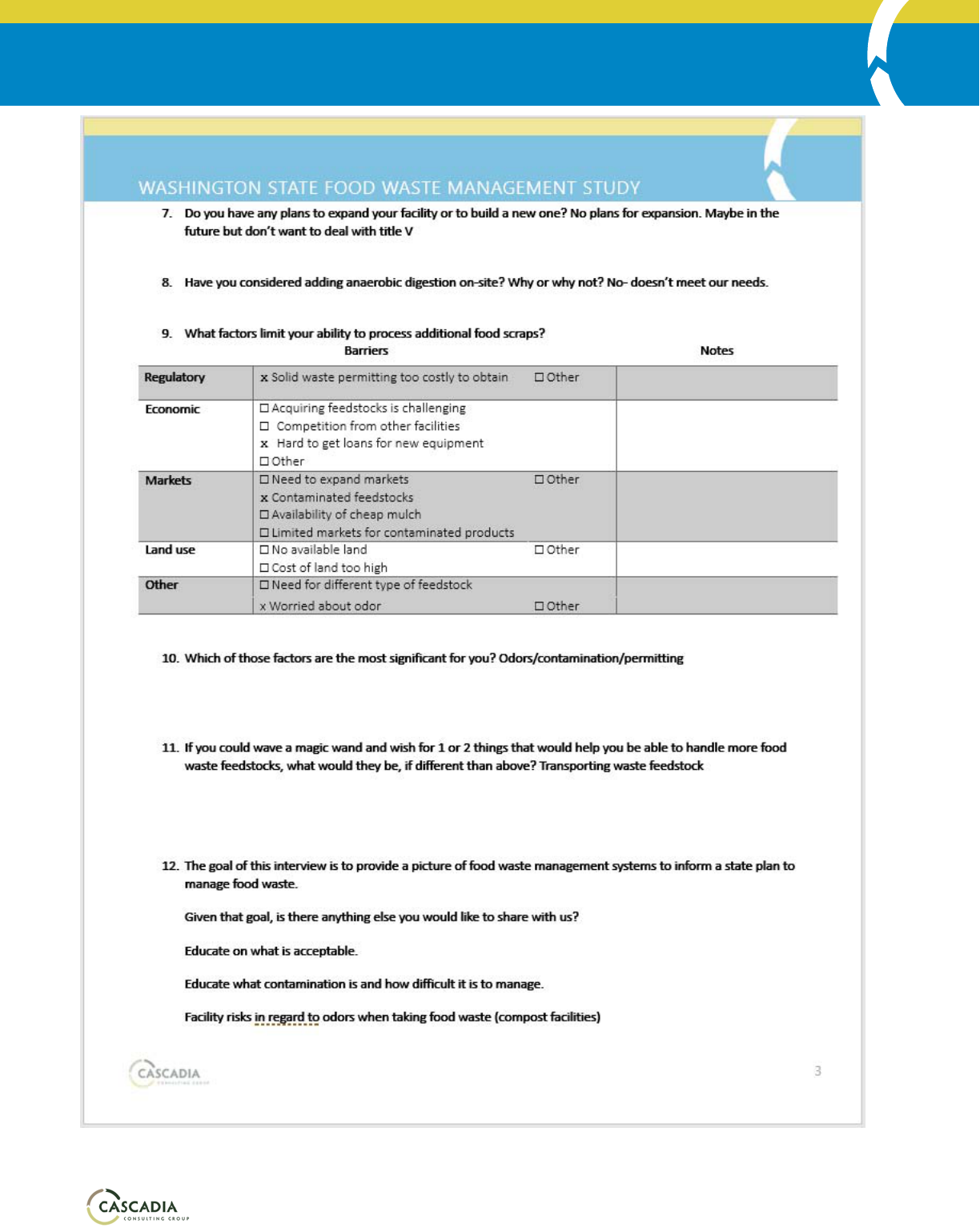
WASHINGTON STATE FOOD WASTE MANAGEMENT EVALUATION
90
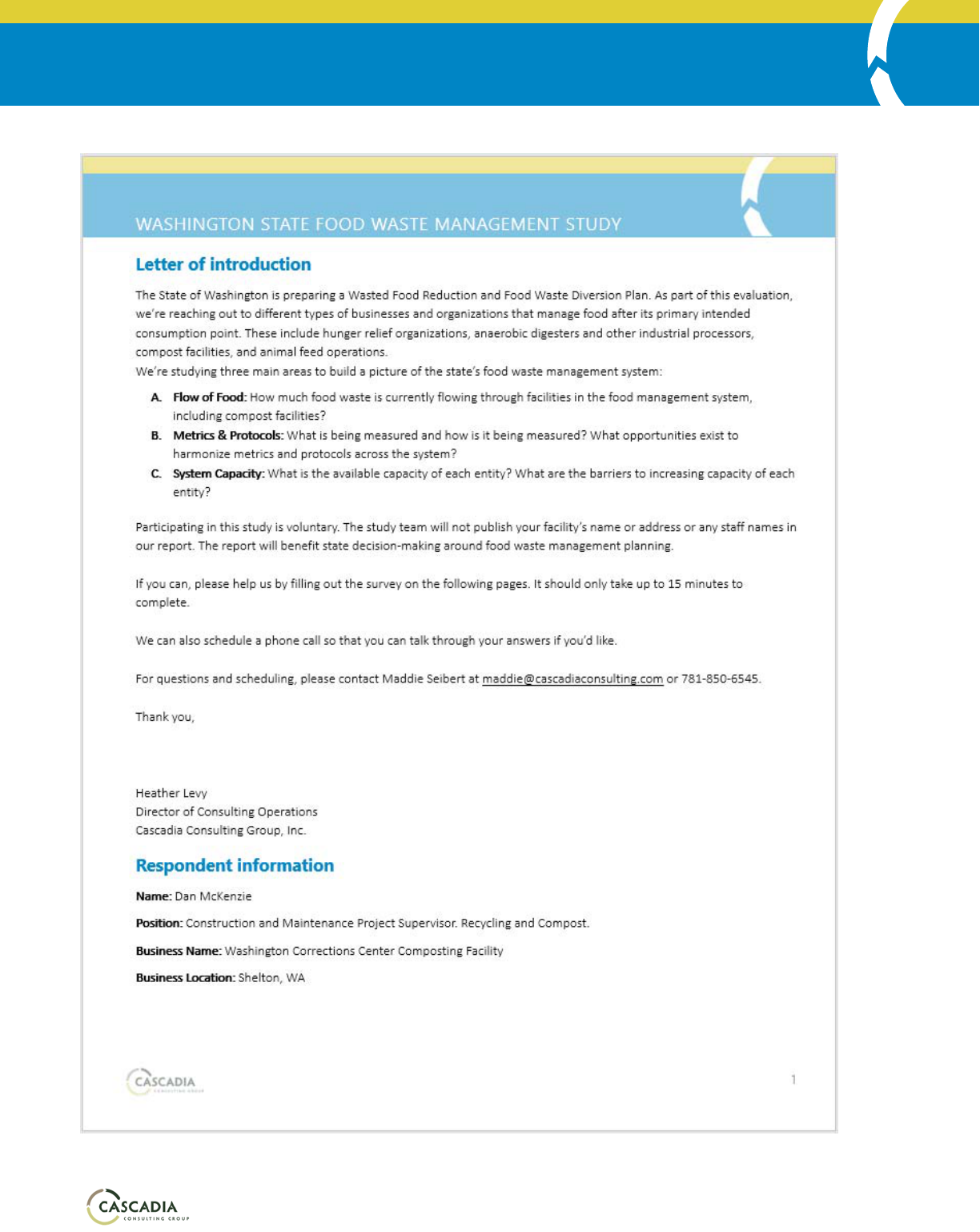
WASHINGTON STATE FOOD WASTE MANAGEMENT EVALUATION
91
Washington Corrections Center
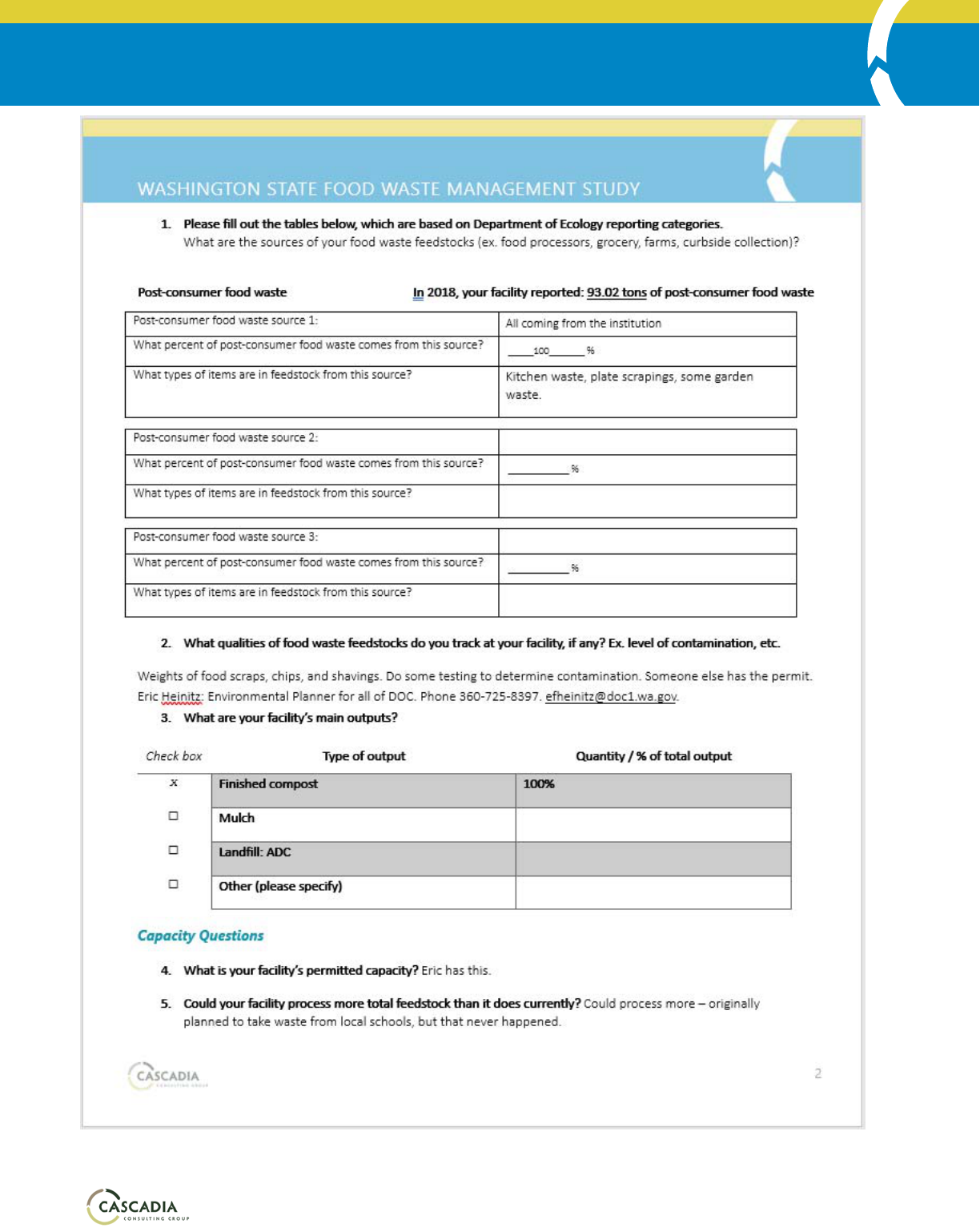
WASHINGTON STATE FOOD WASTE MANAGEMENT EVALUATION
92
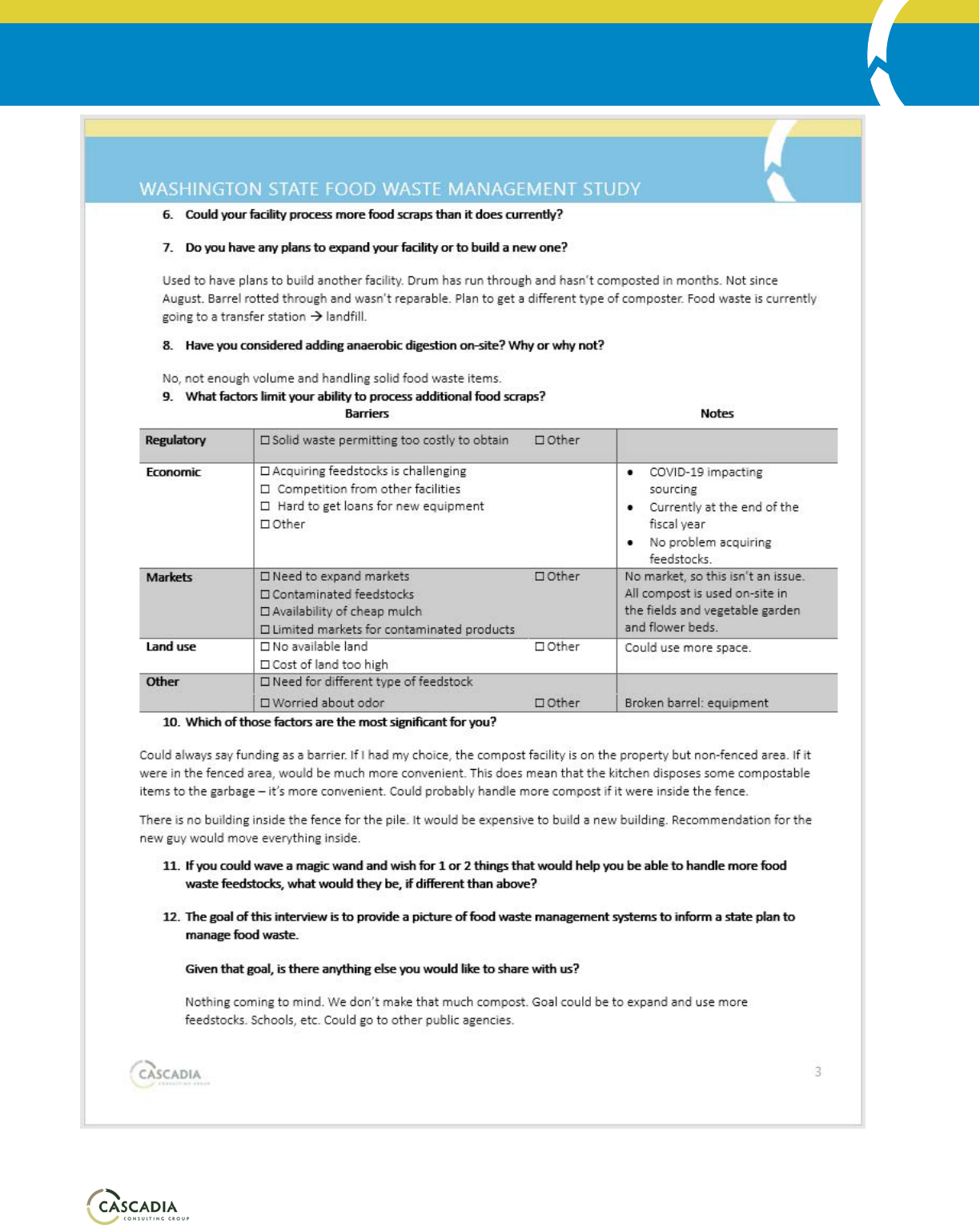
WASHINGTON STATE FOOD WASTE MANAGEMENT EVALUATION
93
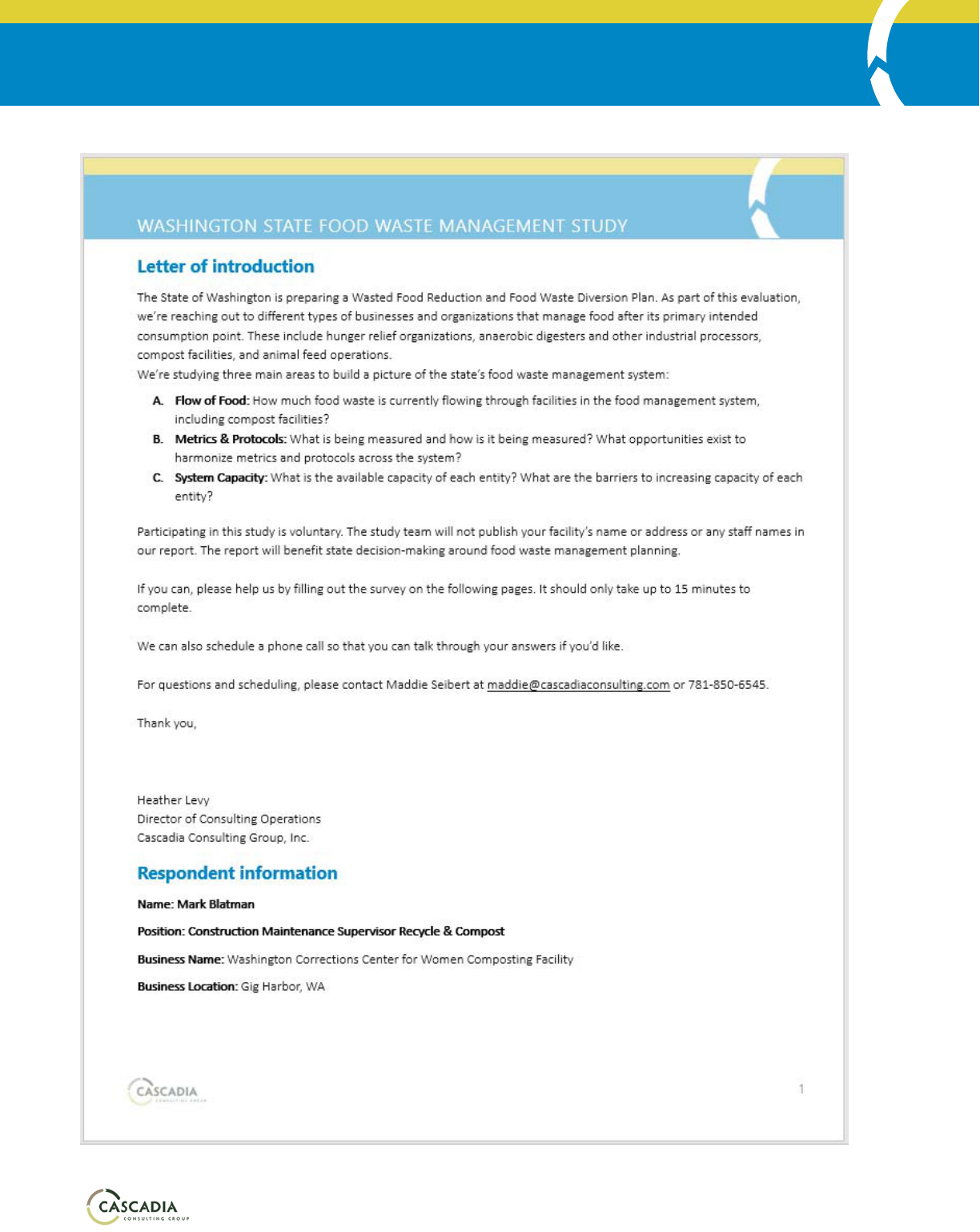
WASHINGTON STATE FOOD WASTE MANAGEMENT EVALUATION
94
Washington Corrections Center for Women
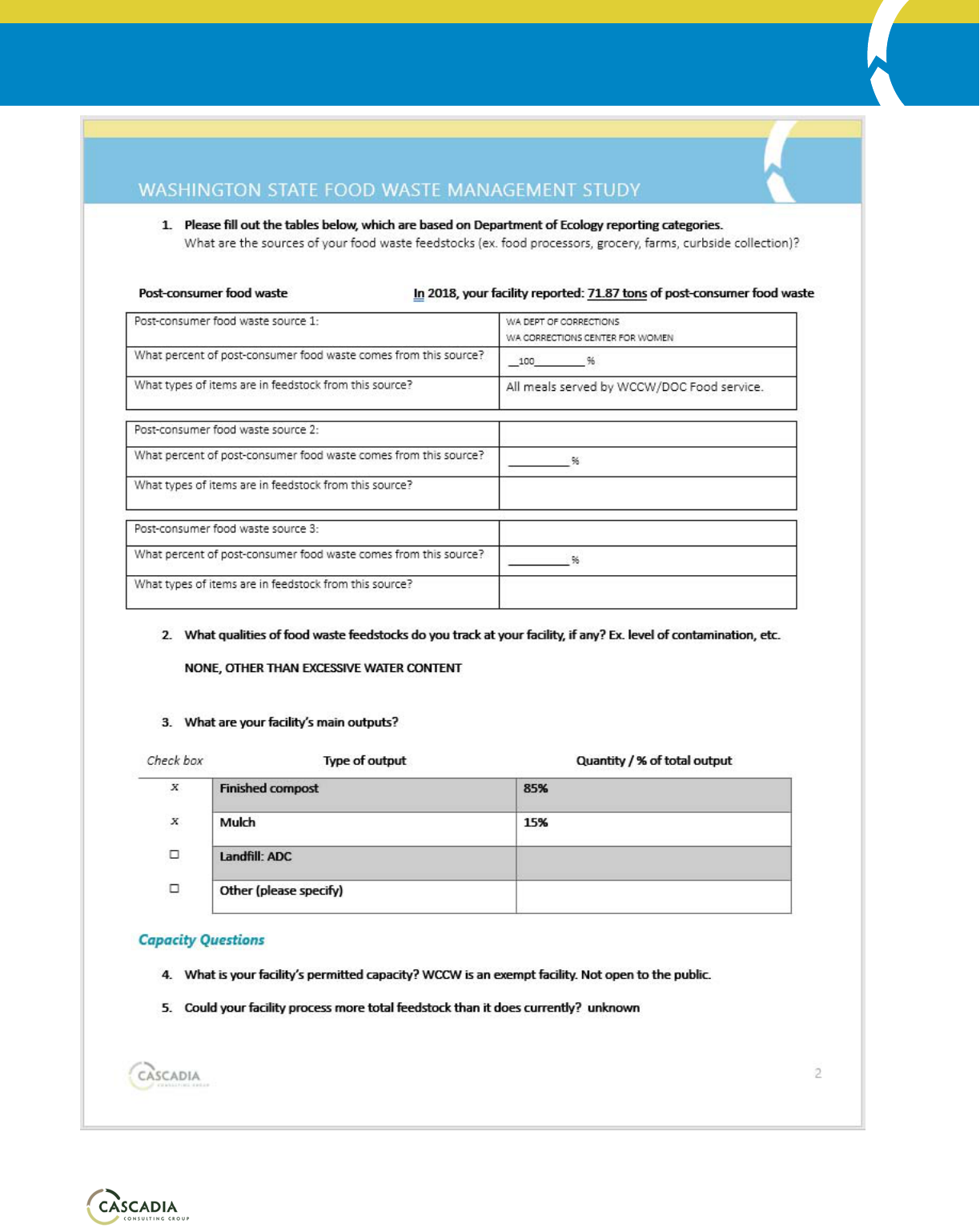
WASHINGTON STATE FOOD WASTE MANAGEMENT EVALUATION
95
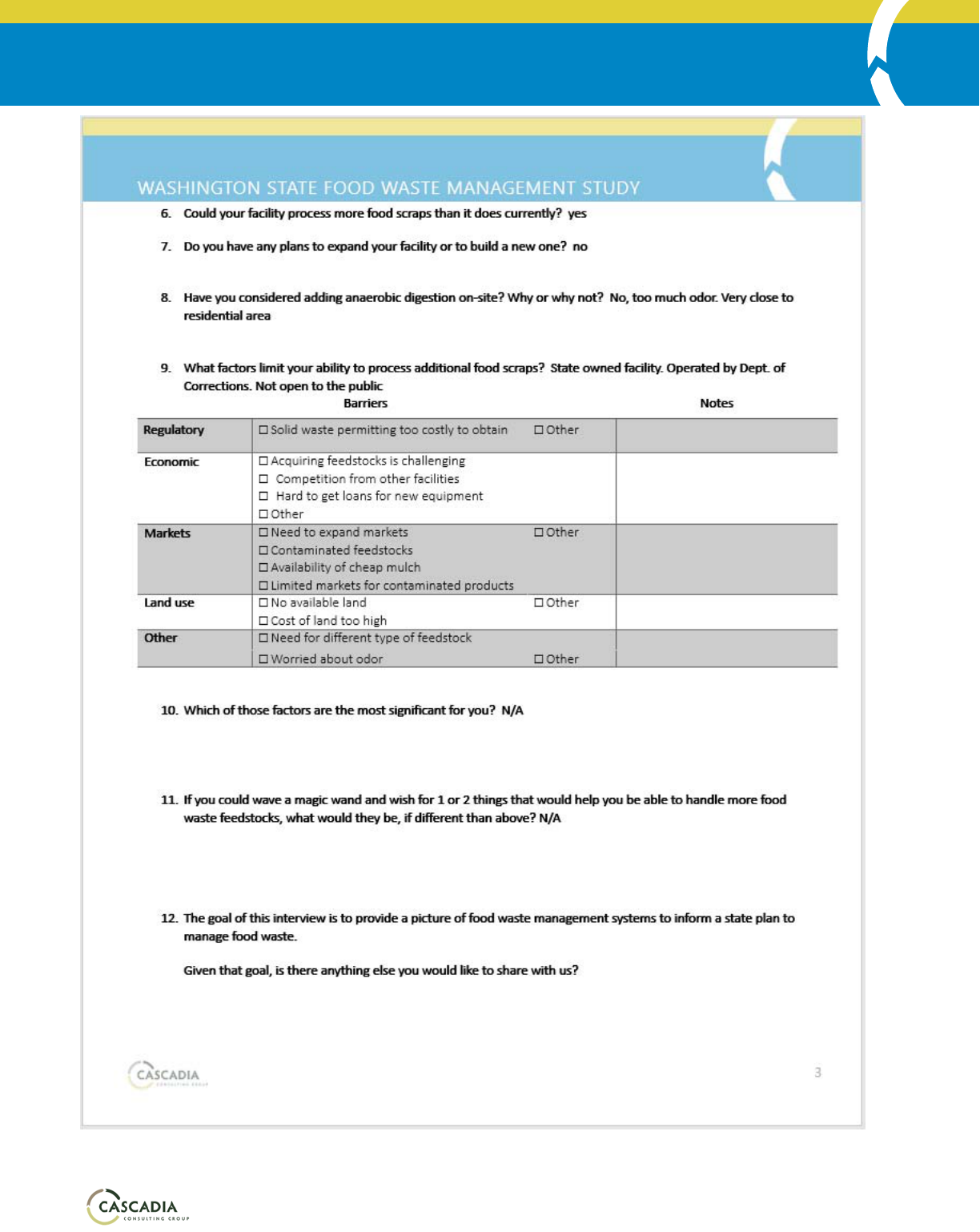
WASHINGTON STATE FOOD WASTE MANAGEMENT EVALUATION
96

WASHINGTON STATE FOOD WASTE MANAGEMENT EVALUATION
97
Appendix E: Animal Feed Food Waste Categories
ThefollowinglistsofingredientsarethosethattheWSDAincludesinitsingredientcategoriesforcommercialfeed
distributors’reporting(WSDA,2018).Thisappendixincludesallingredientcategoriesthatthisevaluationconsiders
tobefoodwasteundertheHB1114definition.
Animal Products
Meat(ifground,artificiallydried,and/ormixedwith
otherfeeds)
Meatby-products
Animalliver
Poultryby-productmeal
Poultryhatcheryby-product
Driedmeatsolubles
Poultryby-products
Hydrolyzedpoultryfeathers
Fleshingshydrolysate
Animalserum
Serumalbumin
Serumglobulin
Spraydriedanimalbloodcells
Meatmeal
Meatand
bonemeal
Meatmealtankage
Hydrolyzedhair
Hydrolyzedleathermeal
Spraydriedanimalblood
Poultry
Hydrolyzedwholepoultry
Hydrolyzedpoultryby-productsaggregate
Eggshellmeat
Bloodmeal
Bloodmeal,flashdried
Bloodprotein
Glandularmealandextractedglandular
meal
Unborncalfcarcasses
Animaldigest
Cookedbonemarrow
Mechanicallyseparatedbonemarrow
Poultrymeal
Animalplasma
Ensiledpaunch
Eggproduct
Leatherhydrolysate

WASHINGTON STATE FOOD WASTE MANAGEMENT EVALUATION
98
(Mammalianorpoultry)stock/broth
Meatproteinisolate
Airdriedanimalbloodcells(airswepttabulardrying)
Hydrolyzedwholeswine
Brewers Products
Brewersdriedgrains
Maltsprouts
Maltcleaning
Malthulls(ifground,artificiallydried,and/ormixedwithotherfeeds)
Driedspenthops
Brewerswetgrains
Brewerscondensedsolubles
Distillers Products
Molassesdistillersdriedsolubles
Molassesdistillerscondensedsolubles
Potatodistillersdriedresidue
Distillersdriedsolubles
Distillersdriedgrains
Distillersdriedgrainswithsolubles
Condenseddistillerssolubles
Distillerswetgrains
Deoiledcorndistillersdriedgrains
withsolubles,solventextract
Human Food By-products
Driedapplepomace
Driedapplepectinpulp
Driedtomatopomace
Cerealfoodfines
Driedpotatoproducts
Gelatinby-products
Driedbeans
Sugarfoodsby-products
Pastproduct
Foodprocessingwaste
Restaurantfoodwaste
Recoveredretailfood
Mixedfeednuts
Otherfruitpomace

WASHINGTON STATE FOOD WASTE MANAGEMENT EVALUATION
99
Screenings
Grainscreenings
Mixedscreenings
Chaffand/ordust
